Critters of Southern Arizona
These are some of the critters you might see while out and about in Southern Arizona. If you are looking for a specific type of critter, you can search with our handy database.
Critter: Acorn woodpecker
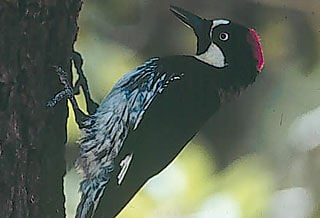 |
I am an acorn woodpecker. My formal name is Melanerpes formicivorus.
I'm black and white with a back that's all black. I have a white forehead and cheeks, but what you'll notice is the red at the top of my head down to the nape of my neck.
In Arizona, you'll find me in the east and southeastern part of the state, including the eastern half of Pima County.
My paramour and I excavate our nest together. Mom lays three to seven white eggs, and we both incubate them for about 11 days. There's only one brood each year. That's enough, don't you think?
We like fruit, nuts - acorns are great - and insects. Mom and Dad both feed the little ones.
I like dead trees. Most people prefer their trees to be alive, but it's much easier to drill holes in dead trees.
As you can tell from my name, I peck at dead trees and things like telephone poles to make little holes where I store my nuts.
I'm different from other woodpeckers. I live in small colonies with as many as five adult males, and we all help to raise the babies.
Critter: Africanized honeybee
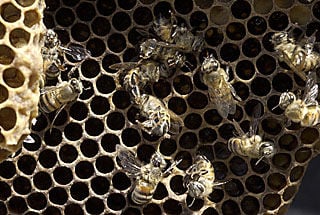 |
Call me: Africanized honeybee, or killer bee. There are 20,000 species of bees.
My looks: I look just like a honeybee. An expert with a microscope can distinguish me from my cousins. I am a bit smaller.
Don't mess with Mother Nature: About 50 years ago, Brazilian beekeepers tried breeding the wild African bee with their domesticated bees. They wanted a bee that survived better in the tropics. Some swarms of the imported bees escaped and have slowly been working their way north ever since.
Don't mess with me: OK, so I am more aggressive. You want to make something of it? Stay out of my way. I don't like loud noises, strong scents or fast movements. I swarm up to seven times a year. I am a much harder worker than the native bees and breed more frequently. All these traits helped me to spread rapidly.
For safety's sake: Screen over all vents or openings into your home that could provide an entry inside. Watch out around old storage buildings or trees that have openings. If you notice bee activity, do not attempt to remove the bees yourself. Get professional help.
Critter: Agave weevil
 |
So your large agave plant suddenly looks like it's wilting. It could just mean I've made it my home. I'm the agave weevil, or Scyphophorus acupunctatus.
As an adult, I am a black bug, about an inch long and beetle-esque. I have a long, curved nose, like most weevils. Although it may look like I have wings, they are just for show. I can't fly.
The large century plant, or Agave americana, is my favorite food source.
The females of my species lay eggs in holes burrowed in the leaves. When the eggs hatch, the white, legless larvae head for the tender center of the plant to feed.
By the time the plant starts to get that wilted look, my whole family is feeding on the dead tissue and fibers that attract other bugs and bacteria.
The only way you'll stop us is by moving us away from other plants in the area. Otherwise, the next generation, and the next, will find homes there.
Critter: American black bear
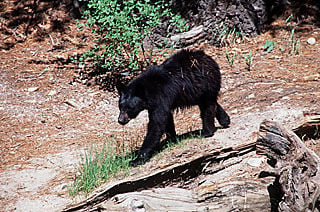 |
My name is Ursus americanus, or the American black bear.
Looking to spot me? As you can tell by my name, I am usually black in color, but sometimes I can be a cinnamon-brown color.
I live in many states in the United States, Canada and Mexico. I can survive in many different habitats and in climates both hot and cold.
I eat plants and animals, but mostly berries and honey since I don't have very strong hunting skills.
I stand on my hind legs when I'm disturbed or frightened. If you see me do this, try shouting or making yourself look big. You may make me run away! I also climb trees when I feel threatened.
Here are some things I'm good at:
Climbing. My sharp claws allow me to quickly climb up trees to escape enemies.
Smelling. I can likely smell 12 to 15 times better than you. This is because my snout is filled with smelling nerves that cover almost 100 times more surface area than in a human nose.
Social life: I'm a solitary animal except during mating season in the summer. Female black bears are also very close to their cubs, which is why they go to such great lengths to protect them, so watch out!
Critter: American Coot
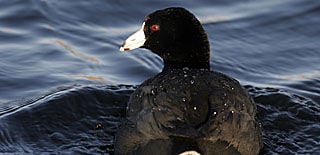 |
Name: American coot
Description: This bird has blackish feathers with white under its tail, a white bill and lobed toes. A chunky bird, it is often mistakenly referred to as a duck and resembles a common moorhen.
Usual haunts: Found from southern Canada into South America. It often spends winters in Southern Arizona, on all open bodies of water.
Housing: During nesting season, it can be found in marshy areas near ponds and streams.
Eats: Dives to snatch aquatic vegetables and some small aquatic animals. It also grazes on meadow plants.
Offspring: Five to 12 pinkish eggs can be found on floating nests in areas with cattails or tules. Both parents care for the eggs. The baby coots begin to swim with their parents soon after they hatch.
Fascinating fact: Usually seen in flocks, this bird is so common that many birdwatchers do not appreciate it. Most hunters aren't interested either, as coots aren't too tasty.
Critter: American Kestrel
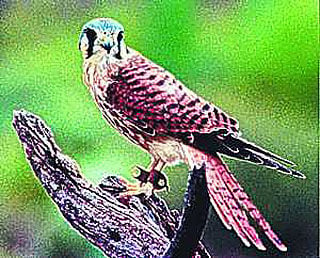 |
I am an American kestrel. I am also known as a Falco sparverius.
I am a small falcon, usually between 8 and 12 inches long. My wingspan ranges from 20 to 24 inches. I weigh anywhere from about 4 ounces to almost 6 ounces.
My back and my tail are rust colored. I am white on my cheeks and chin and also on my chest. Our males have wings that are a grayish blue while our females have wings that are reddish brown.
We can be found throughout Arizona and live here all year. We prefer to be around grasslands, farms, deserts and in open areas that have some trees.
We aren't very picky when it comes to eating. We like insects and rodents, but we also will eat birds and even snakes.
Our mating season is in late spring. We usually have three to five eggs just once a year. Both the parents tend to the eggs.
I fly pretty fast, reaching about 39 miles per hour. I also have great eyesight.
Critter: American Lady butterfly
 |
I am an American Lady butterfly, aka Vanessa virginiensis
An American beauty: My wings have a bright, uneven pattern of brown, yellow and orange. Two large eyespots can be seen when I perch with wings closed.
Like a lady: We're extremely fond of flowers, spending our days sampling nectar from a variety of flowering plants.
Location: Common to the Southwest.
Where we go: We prefer places with low vegetation, such as parks, vacant lots, back yards and along forest edges.
How we live: Males perch in treetops or on the ground, waiting for passing females. Caterpillars live and feed on a nest of leaves.
Critter: Anna's hummingbird
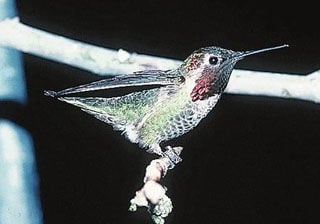 |
I am Anna's hummingbird, sometimes called Calypte anna.
Picking me out of the crowd: I am 3 1/2 to 4 inches long, with a black bill and medium- to light-gray underparts. I am a bright, metallic green to bluish-green above, with a rose- to copper-red throat and crown. Females are green to bronze-green above. The throat is bronze-gray with a spot of iridescent rose or copper.
My idea of a five-star restaurant is a garden loaded with nectar-filled flowers and gnats, midges and whiteflies.
Romance: I'll hover over the object of my affections, climb for seven or eight seconds, then dive that same distance in just two seconds. I could do this to impress a female or to let a rival know he may as well give up because he's just not in my league.
Real estate: Females take care of the nest, building with plant fibers, animal hair and spider silk. In Arizona, females nest October to June.
Who's Anna? My name comes from Anna Massena, Duchess of Rivoli, a patron of the sciences during the time of Napoleon Bonaparte.
Critter: Antelope jack rabbit
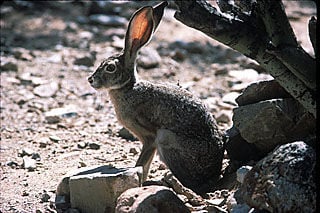 |
Hello! I am an antelope jack rabbit, aka Lepus alleni. I am a member of the Leporidae family, which includes rabbits and hares.
Know me by my ears. They are spectacular at about 6 to 8 inches long, but they are not just for show. They are important for regulating my body temperature. In hot weather, I keep them erect, and they give off heat. When it's cold, I keep them against my body to hold in the warmth. My ears also will stand up when I am alarmed. Bet your ears can't do all that!
What about the rest of me? I am 22 to 26 inches long and weigh 6 to 9 pounds. I am grayish brown on top, and on my lower sides there is a lot of white. My face, throat and ears are brownish.
It's about my tail! I'm called an antelope jack rabbit because of my leaping ability, and my tail is similar to an antelope's. When I run, I "flash'' the white underside of my tail high and low to confuse a predator. When I stop, I don't reveal the white. Bobcats, coyotes and eagles like to have me to dinner, and I am the main course.
Show me the shade. Even with my special ears, I get hot in the summer. To avoid the sun, I back under the shade of a plant. This resting space is called a form. I am then out of the heat and concealed on three sides.
Critter: Apache cicada
 |
I am an Apache cicada. Sometimes I am called a Diceroprocta apache.
Life for me is just three years long, but that's OK because my short life has exciting moments.
It all starts in July and August. You will hear the very distinctive mating call of the males, which sounds like buzzing or singing.
After mating, the females leave their eggs in twigs of trees.
We are called nymphs after we hatch, and this is when our excitement begins. We drop out of the tree to the ground, where we begin digging down. We are underground for about two years.
While underground, we munch on the roots of plants and trees. We continue to grow and molt. We are almost full size when we make our way back up to the surface. We go through our final stage of shedding our exoskeleton above ground. We have to watch out for birds and other predators.
As an adult I'm about 1 to 2 inches long. I am black with a light-colored band around my neck, and I have wings.
Critter: Arizona cotton rat
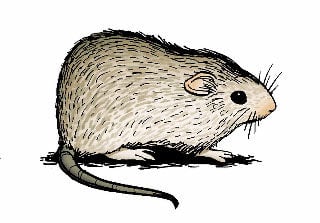 |
The name on the mailbox: Arizona cotton rat, more formally known as Sigmodon arizonae.
The face in the mirror: I was once thought to be the same species as the Hispid Cotton Rat, but we differ in chromosome number. If that doesn't mean much to you, then I look a lot like a vole, but I'm a little larger. I have a short, rounded snout, coarse fur, a thinly furred tail and small ears and eyes. My coat is brown interspersed with black hairs.
It's a beautiful day in the neighborhood: My neighborhood is Southeastern Arizona and parts of Mexico. I live in areas with good grass growth and am likely impacted by overgrazing. In fact, two of my subspecies from central Arizona may be extinct.
My preferred menu choices: I dine mostly on grass and other green growing things. I construct little tunnels or runways in grasses and weeds so I can forage in safety. While I like to eat grass, there are many animals that would prefer to eat me.
Meet the family: Life at the bottom of the vertebrate food chain can be a bit of a roller-coaster ride. To continue the species - if not my personal existence - I am a prolific breeder. We have eight to 10 litters a year when conditions are good.
Critter: Arizona pocket mouse
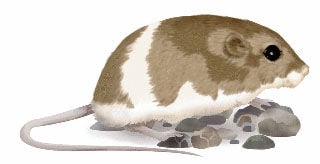 |
Pocket friend. You can hide me in your pocket if you want, 'cuz I'm the Arizona pocket mouse, or Perognathus amplus. Just don't take me out in the daylight, because I prefer to play at night.
All about tail. I may be a little guy, but I sure am proud of my tail; it's more than 3/4 the length of my head and body! My fur is very soft and silky, and sometimes I am all-black, but usually my fur is black with a hint of pale pink or white on my belly.
Livin' large. You can find me almost all over Arizona. I really like the desert, and sometimes you can find me hanging out by creosote bushes. I even like to eat creosote bush seeds.
Snack time. Speaking of food, my absolute favorite meal in the whole world is seeds. I like to dig up seeds in sand, and that's really all that I eat except for sometimes I munch on insects or green vegetation. I like to carry seeds around in my cheeks and then store them in my sandy burrow of a home.
Home sweet home. My favorite place to make a home is in small burrow openings with piles of sand, especially underneath a plant. Sometimes you can find me by following the tiny, round paw prints I leave in the sand.
Family affair. Don't mistake me for my cousins the little pocket mouse and the Apache pocket mouse. Spot me by my long tail.
Critter: Bark scorpion
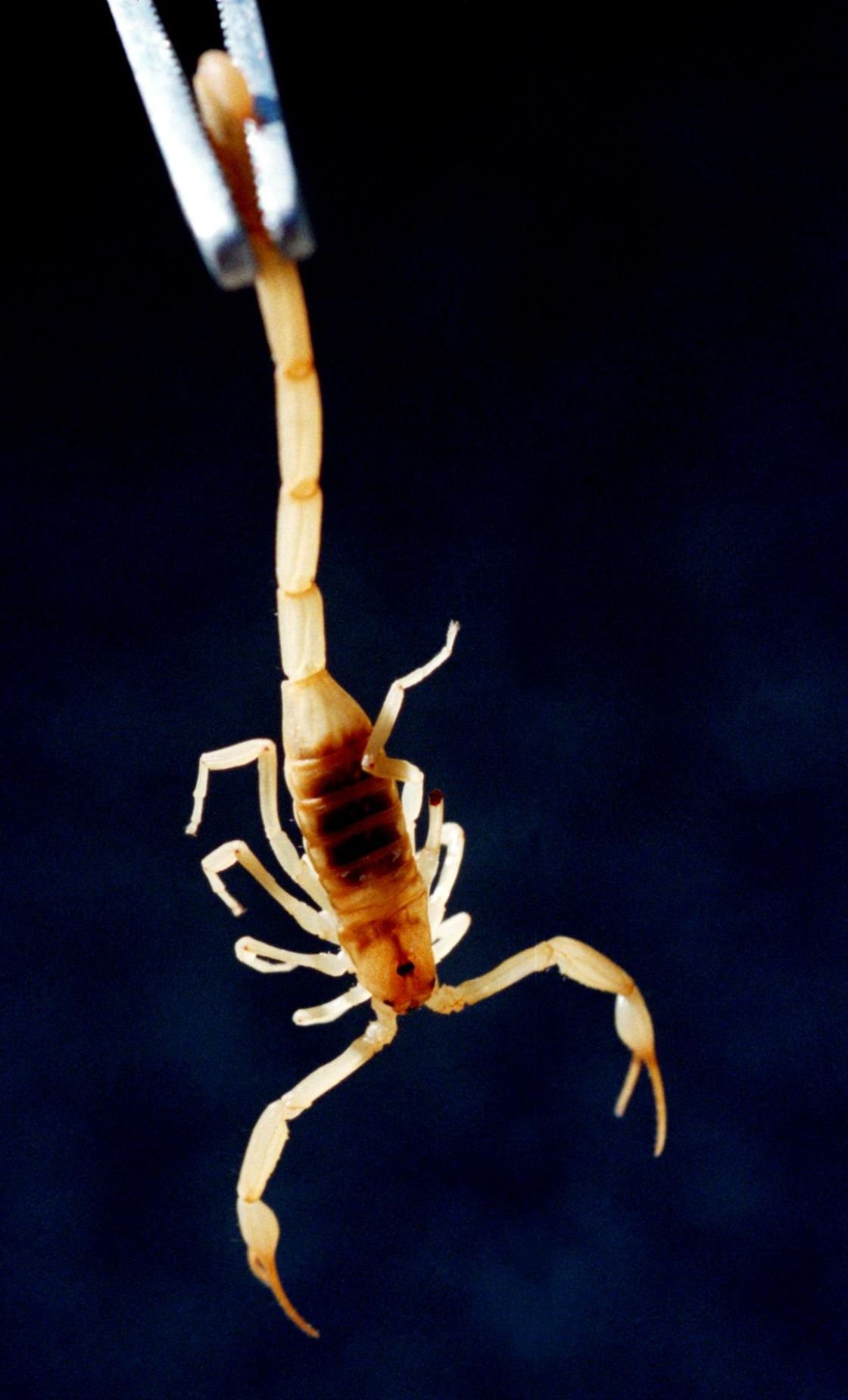 |
Name: Bark scorpion, aka Centruroides exilicauda
Known addresses: Under tree bark, leaves, rocks, debris, sometimes in houses, especially in desert areas. Brownish-yellow to tan, they are about 2 to 2½ inches long with a long, thin tail ending in a stinger.
Greatest activity: April through October.
Important fact: Of the three scorpions commonly found in the Tucson area, the stong of the bark scorpion is the most toxic and can be fatal. If you think you've been stung by a scorpion, call a physician or hospital immediately.
Source: Sonoran Arthropod Studies Institute.
Critter: Barking frog
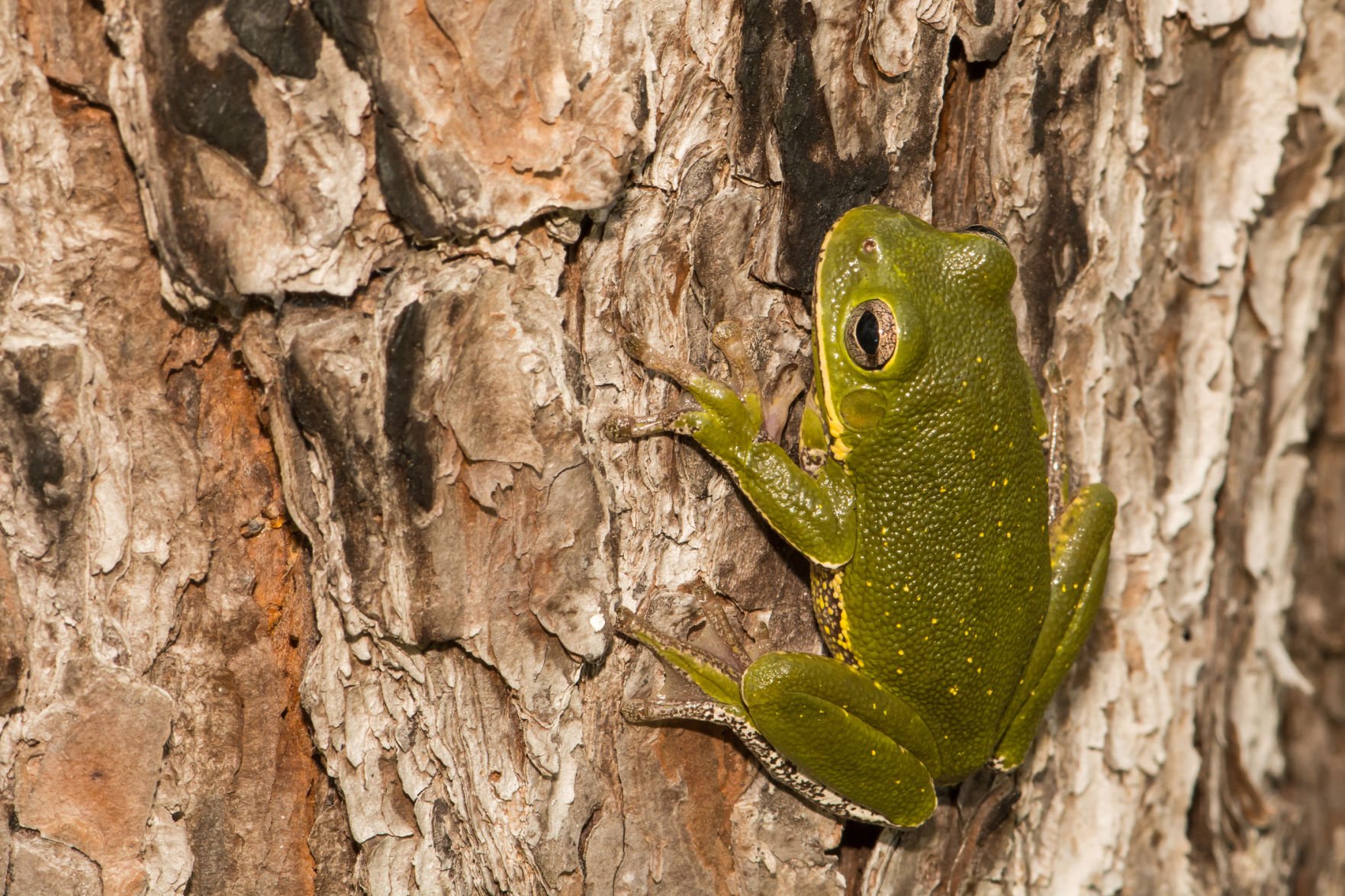 |
Grr: My official name is Eleutherodactylus augusti, although most people call me a barding frog.
Hear me roar: My nickname comes from the sound that males make during mating. My explosive breeding call sounds like a dog barking.
A wee frog: I grow to be only about 3¾ inches long, although females are bigger than males. Thopugh I look a bit like a toad, I don't have any warts. My skin is light brown with dark spots.
Tropical family: I am the only member of the Leptodactylidae family that lives in Arizona; there are more than 500 species ofd tropical grogs in my family found in Arizona, Mexico and parts of Texas and New Mexico.
Yummy in my tummy: I like to hide out under rocks or in holes and jsut wait for my dinner to wanter by. Sure, I guess you could call me lazy. My favorite things to eat are crickets, grasshoppers, snails, scorpions and spiders.
Source: www.reptilesofaz.com and "Peterson First Guides Reptiles and Amphibians" by Conant, Stebbins and Collins.
Critter: Bed bug
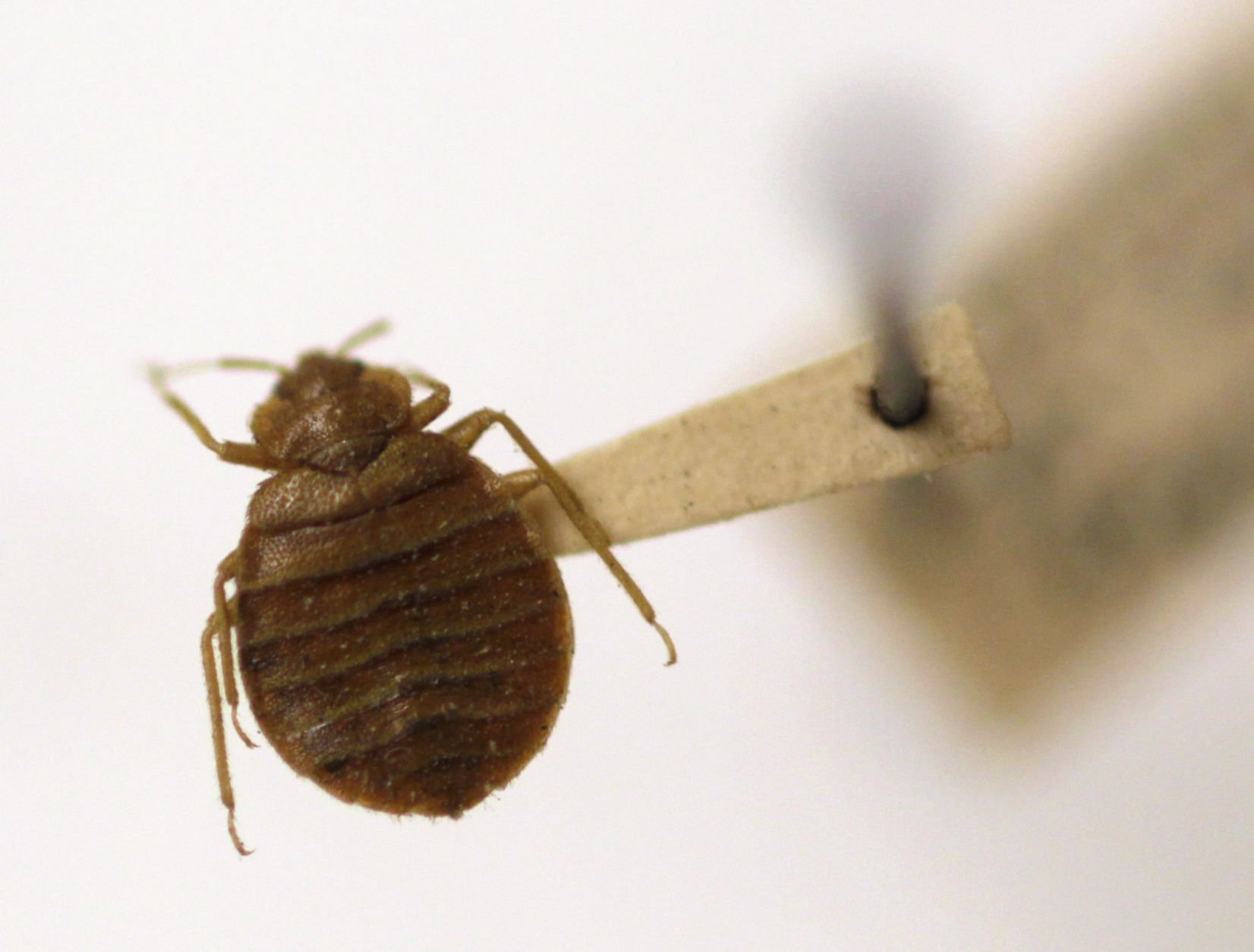 |
My name is: Cimex lectularius (say that 10 times fast), but you know me as your good old friend Bed Bug.
Don't hig the covers: Now, although I don't sleep all day, I do spend most of my time under the sheets. I venture out only in the dark. That's usually when humans are sleeping and I have the opportunity to feast on them. Mmm... there's nothing like dinner in bed.
Eau de Bed Bug: I'm partial to slobs because there's nothing like the aroma of a dirty home, but sometimes I just land in a clean house.
It doesn't take long for me to take care of the smell. I start to stink almost as soon as I move in. Most people tell me I smell like a concoction of poor hydiene, bacteria and bug feces.
Look closely: I'm a small guy, about 4-5 mm long. Now, if you look really hard, you can see me: I'm a reddish-brown color. Good luck seeing my kids though; they're sneaky little critters. They are usually a yellowish-whitish color.
I get around: We travel quite often, not necessarily because we want to, but our host families tend to move around. Sometimes we're in their suitcases or purses, even their socks. Now, if they leave without me, I just move on in to the neighbor's house and hope they have a comfy bed.
Source: "Venomous Animals of Arizona.
Critter: Berylline hummingbird
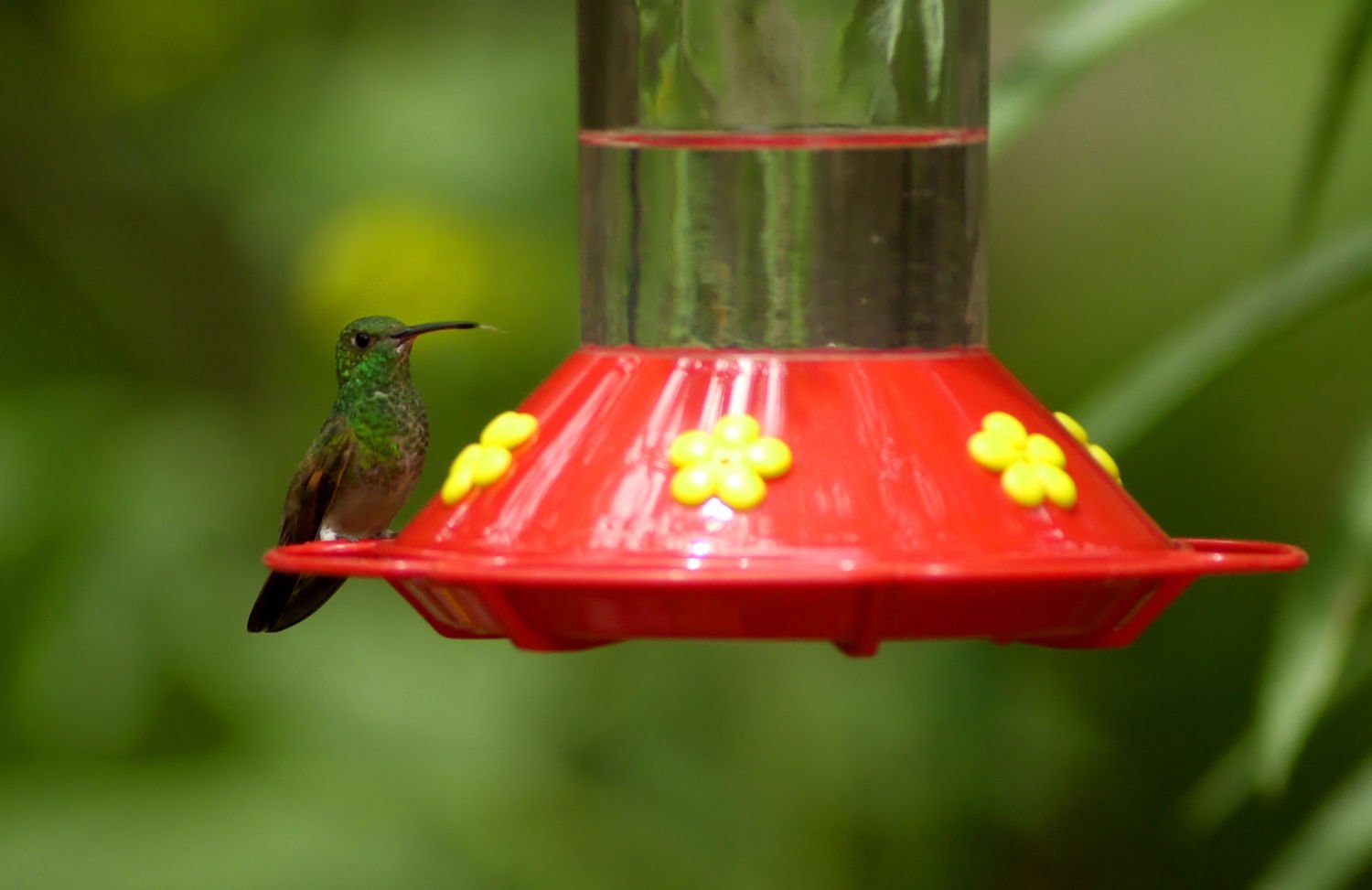 |
Who am I? I am a Berylline hummingbird, aka Amazilia beryllina.
Not just another face in the crowd: We are each about 4.25 inches and weigh between 4.25 and 5.75 grams. The guys have glittering green chests, crowns and upper backs with gray to brown abdomens and chestnut lower backs. Our central tail feathers are purple, and the wings have a rufous patch. Our upper bills are black, and our lower ones are reddish. The girls have similar but slightly subdued colors.
Seek and ye shall find . . . well, maybe: We are not easy to find every year in Arizona, but your best chance for finding us is by looking in the Chiricahua, Huachuca and Santa Rita mountains.
Making a home: Our nests are made of twigs and held together by spider webs. We use soft materials we find to pad the nest.
A home is for family: That nest was built by Mom. Once Dad won her heart with an elaborate flight, he stayed only long enough to ensure babies. Mom lays the eggs (usually two), incubates them in two to three weeks and rears the young.
Did you know? In relation to body size, hummingbirds have the largest hearts of any bird. Those big hearts can beat up to 1,200 beats per minute during great excitement. It must have been that mating flight.
Source: "Arizona Wildlife Views, Special Edition" by the Arizona Game and Fish Department.
Critter: Big brown bat
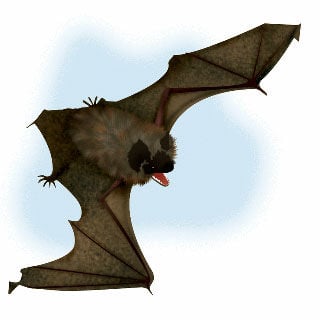 |
I yam what I yam and I yam a big brown bat. No fancy titles or monikers for me. Oh, I guess you can call me Eptesicus fuscus if you want to be scientific, but I prefer telling it like it is.
As you would expect, I am mostly brown with black on my ears and face. I measure almost 4 1/2 inches long.
From sea to shining sea. We are found in virtually every American habitat and our range extends as far as the southern tip of Mexico. We are partial to deciduous forests.
Bring on dinner! We are quite voracious eaters. There's nothing like a good beetle, but we will eat almost any night-flying insect. We will forage over water or land and in forests or clearings.
Oh give me a home. We set up maternity colonies in the small cavities or loose bark of such trees as pine, oak or beech. With encroaching civilization, you will now find us roosting around bridges, barns and buildings. As our habitat shrinks, it would help us out if you would put up bat-specific roosts.
Are we good or what? Like all insect-loving bats, our eating habits are very beneficial to the environment. Research shows we eat prodigious amounts of crop and forest pests, such as ground and scarab beetles, stink bugs and leafhoppers. A reproductive female can eat her weight in insects every night.
Critter: Black widow spider
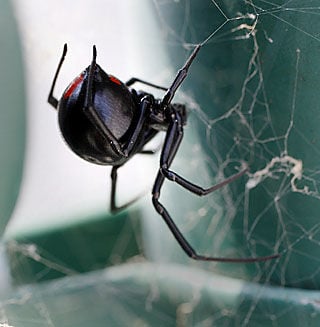 |
Hey, you, this won't hurt a bit a to know: Black widow spider, aka Latrodectus hesperus.
Have we met before? The female is shiny black with a reddish hourglass shape on the underside of her abdomen. Her body is about a half-inch long; with legs extended, maybe up to 2 inches long. Males are similarly shaped, but they are cream or tan in color and much smaller.
The meeting place: We are common throughout North America, but I prefer the warm desert climate of Southern Arizona. I'm very fond of man-made dwellings. I like to live in your garages, lawn furniture and wood piles.
- Just the facts:
- People rarely die from my bite.
- The adult female hangs upside down in her web, making her red hourglass easily visible.
- Females sometimes eat males after mating.
- I only bite to defend myself.
- I mainly prey upon insects.
Critter: Black-chinned hummingbird
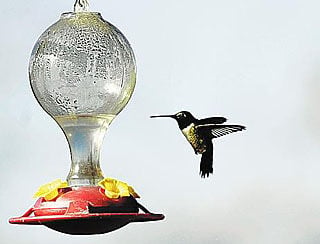 |
Black-chinned hummingbird, aka Archilochus alexandri
Bigger isn't always better: I'm one of several hummingbird species in Arizona. They say I'm one of the smallest, weighing only 2 to 3 grams.
Get your feeders ready: We migrate south for the winter, returning to the Tucson area in the spring.
For best viewing: Sit quietly near a feeder or flower garden; it will be worth the wait.
What to look for: I'm green with a black throat and chin, white chest and belly. My violet, iridescent lower throat can be easily seen in sunlight.
Don't let my size fool you: My wings flap 80 times per second and I'm able to fly backward. It takes a lot of nectar to fuel all of these aerobatics.
We need to eat every 10 to 15 minutes or about 60 times a day: A flower produces only small amounts of nectar, so we may need to visit up to 2,000 flowers each day to obtain enough sugar in our diets. We can't live on sugar alone; we also eat small insects to get the protein we need.
Critter: Black-tailed jackrabbit
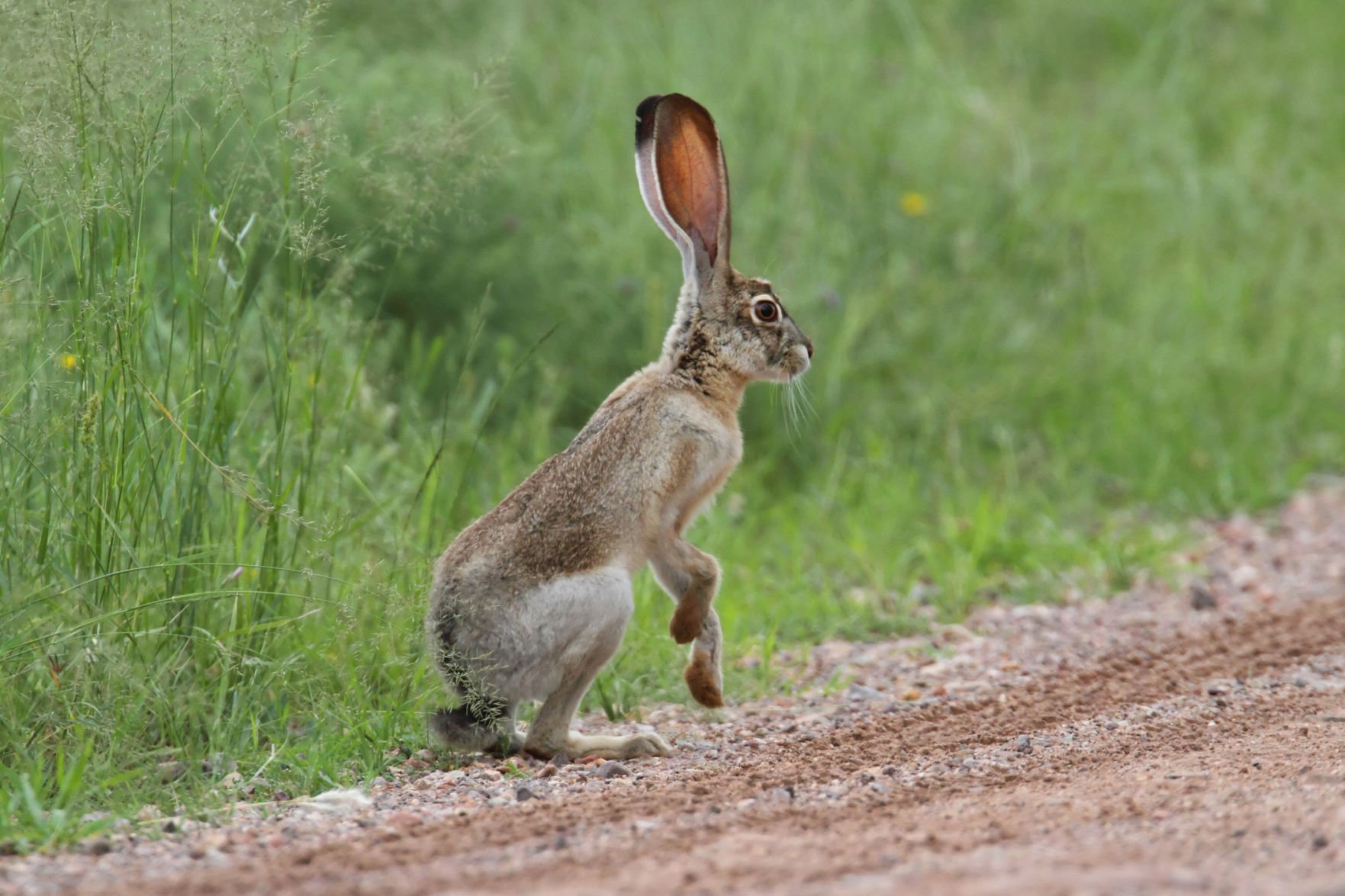 |
Name: Black-tailed jackrabbit, aka Lepus californicus
Description: This critter weighs between 5 and 8 pounds. It is about 17 to 25 inches in length, and its ears are 6 to 7 inches long. Females are larger than the males.
Fur color ranges from a buff to brownish-gray with black tips. Its ears and tail are also tipped black. The belly is lighter in color.
Usual haunts: It inhabits four deserts of the Southwest, including the Sonoran Desert.
Eats: It prefers grasses and forbs, twigs and bark, and the beans and leaves from mesquite trees.
Housing: The jackrabbit doesn't construct a den or burrow. Instead, it uses round depressions on the ground that are near brush or vegetation.
Offspring: It mates all year; the lengthy peak season is from December to September. Pregnancies last from 41 to 47 days. Usually two babies are born per litter, and there can be up to four litters a year. The babies are able to see, are mobile, and are covered with fur when they are born.
Predators: It is wary of coyotes, bobcats, snakes, owls, foxes, hawks and eagles.
Source: "Critters of Arizona Pocket Guide
Critter: Black-tailed prairie dog
 |
Name: Black-tailed prairie dog, aka Cynomys ludovicianus
Appearance: 15 inches tall with a light brown or cream body. The rear third of the short tail is totally totally black.
Life and death: Life span is about 8 years. Females have 3-5 babies at a time. They are preyed upon by rattlesnakes, coyotes, bobcats, birds of prey and weasels.
Neighborhood of choice: Prairie dogs live in towns burrowed underground in open, brushless areas. They prefer an uninterrupted view of their surroundings as they emerge from the burrow. In the past, towns have been miles long and housed millions of prairie dogs. Numbers are dwindling now.
Preferred menu: Grasses, leaves, roots, seeds and other plants, and occasionally small rodents and birds' eggs.
Fascinating facts: Many ranchers ranchers dislike prairie dogs because they compete with livestock for range grass and their burrows are a hazard for wandering horses and cattle.
Source: "Guide to Western Wildlife" by Buddy Mays (Chronicle Books, San Francisco) and The Arizona-Sonora Arizona-Sonora Arizona-Sonora Desert
Critter: Black-necked garter snake
 |
Call me: Black-necked garter snake, or Thamnophis cyrtopsis.
What a looker: My most distinguishing traits are the two large black spots just behind my head, on each side, that are separated by a white or pale yellow stripe. I also have a white crescent between blotches at the corner of the mouth. I am a brownish-green color with black stripes and two rows of spots that fade toward the end of my tail.
Home sweet home: I am common to the Sonoran Desert, although populations in the desert have been rapidly reduced in recent years due to habitat destruction. You can also find me in places from southeastern Utah all the way down to Guatemala. Small populations of my kind have been found in several places, including the Ajo Mountains.
Water, water, everywhere: I usually hang out near bodies of water because I am semi-aquatic. Sometimes during the rainy season, I wander a little farther away from my water source.
Feed me: I eat mostly smaller animals that I find in the water or surrounding areas such as: fish, frogs and their tadpoles, and sometimes small lizards and mammals.
Love those kids: I give birth to five to 15 young'uns in the summer.
Don't push me: If you threaten me, I can bite, defecate and give off a really bad smell to make you go away. But don't worry; I'm not deadly.
Critter: Blow fly or bottle fly
 |
You can call me: Blow fly, but some people call me bottle fly. I'm from the family Calliphoridae. I got the name "blow fly" because people noticed I'm always hanging around on carcasses when they are swollen, or blown.
Check out my looks: I'm larger than a house fly and metallic-green in color. I have a gorgeous blue hue when seen in sunlight.
Home is where we bat our wings: My relatives are established in Arizona, Southern California, Texas, Louisiana and Florida, but can be found throughout Central America, Japan and India. I live on and have babies in rotting flesh, garbage and fecal matter.
In my spare time: I enjoy hanging out on dead bodies and on garbage. I have an incredibly loud buzz.
You need me: I am important for forensic purposes in the Southwest because I can help solve death mysteries. Detectives sometimes use me to determine how long something has been dead. I usually arrive within the first 10 minutes after someone has died. Also, my larvae are used to treat osteomyelitis, a bone disease. I quickly decompose dead animals during hot weather.
Life is short: About six weeks.
Critter: Blue-throated hummingbird
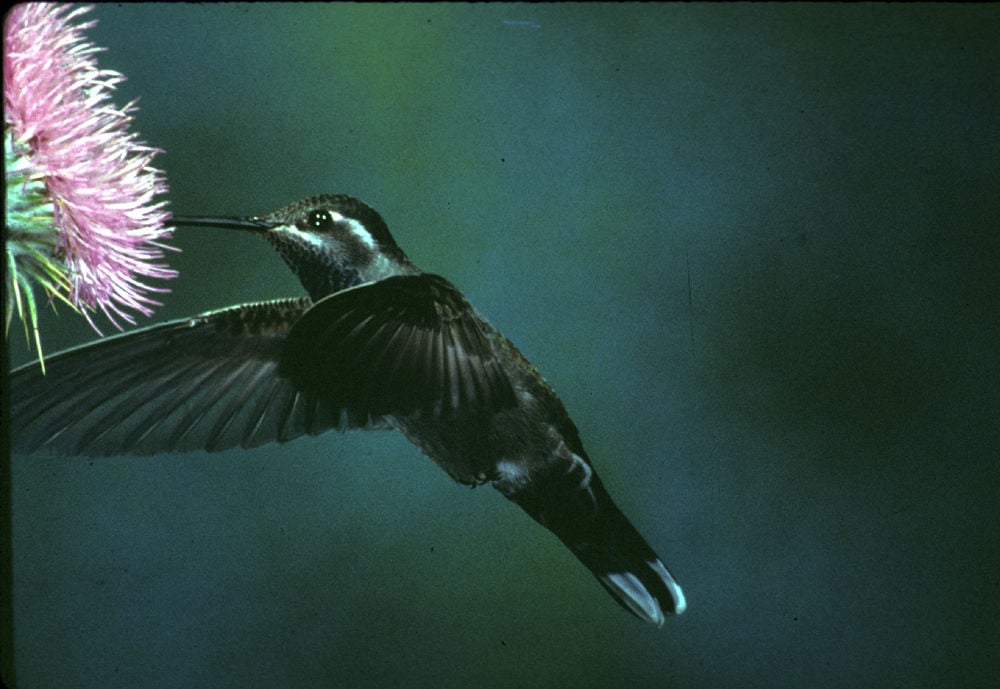 |
Name: Blue-throated hummingbird
Description: The largest hummingbird in Arizona, this critter measures 5¼ inches and weighs about a quarter of an ounce. The female does not have the powder-blue throat feathers that distinguish this critter. However, both genders have gray-brown heads and gray-brown dark gray underparts. Three of their tail feathers have white tips.
Usual haunts: The critter's range is from Southern Arizona and New Mexico and southwestern Texas to southern Mexico. They have also been seen in Colorado, Utah, California and Nevada. Locally, they prefer Cochise, Pima and Santa Cruz counties. They especially like wooded canyons with elevations of 5,000 feet or higher, including Madera and Ramsey canyons.
Housing: Their nests consist of twigs and other plant material and are bound together together by spiderwebs. They also use moss in their nests.
Offspring: This bird has an 18-day incubation period for two eggs. This hummingbird can have as many as three sets of eggs in one breeding season.
Fascinating fact: The females can stay at their nests for several years, and when needed, they build new nests on top of the old one.
Source: Arizona Wildlife Views
Critter: Bobcat
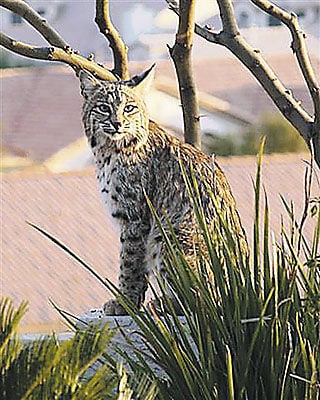 |
My name is: Bobcat. A scientist might call me Lynx rufus, but you can call me Bob.
Picking me out of the crowd: I weigh 20 to 26 pounds. I'm brown with a lot of undefined dark spots and dark stripes on my legs, tail and the ruff around my face. My tail is short; it is tipped black on top and is all white on the underside. My ears are black in the back with a big white spot on each.
Directions to my house: My kind are found almost everywhere in North America, and we are adaptable to marginal habitats. I may not leave an area where I'm comfortable just because humans have moved in.
What's for supper? I may go looking for food or may just wait for it to wander by. Then I pounce and give a quick, deadly bite to the neck of my prey: rabbits, rodents, birds and other small critters. These smaller meals mean that I hunt daily.
Meet the family: I'm not really the family type, preferring solitude. But I generally get a little romantic in the spring. For the guys there's no commitment; the ladies deal with the consequences a couple of months later, when they have two or three spotted kittens, who usually go off on their own in the fall.
Critter: Brown spider
 |
I am: a brown spider, aka loxosceles spp.
You may know me: I'm small and brown with a slightly darker brown violin-shaped marking on my head and thorax.
I live among you, unnoticed and inconspicuous. I prefer dark, gloomy places seldom disturbed by humans, such as basements or garages.
Meal planning: I spin a sticky web beneath rocks and debris to catch insects.
Enter at your own risk: My bite can be dangerous to humans. The most common reaction from my bite is a spreading sore that can cause permanent tissue damage. Consult a physician if you think I've bitten you.
All in the family: Several species of loxosceles live in Arizona. We are closely related to the brown recluse spider found in the Midwest.
Critter: Brown-headed cowbird
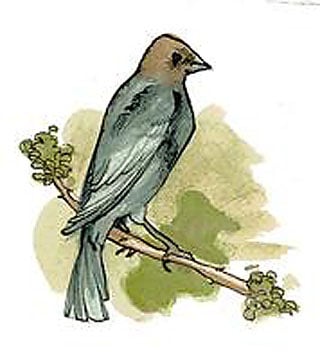 |
Don't call me names: I am a brown-headed cowbird, aka Molothrus ater.
Tell me I'm beautiful: I am from 6 to 8 inches long and have a small bill similar to that of a finch. The guys are a metallic green-black, and what color do you suppose my head is? Ladies are a light gray-brown all over. I am the smallest North American blackbird.
The next "American Idol": When I'm courting a lady, I make a variety of high-pitched, squeaking whistles and gurgling notes.
There goes the neighborhood: During breeding season, we like to spend our time in woodlands, suburban gardens and city parks. Otherwise, we'll mix with other blackbirds in fields and pastures.
Mooching off the neighbors: Mom finds the nest of another songbird, perhaps a warbler or a finch, and removes one of the host's eggs. She lays one egg in its place, then moves on to another bird's nest, laying four to five eggs in all.
We're following our nature: We don't mate for life. Our children are larger than the babies belonging to the nest in which they are born, so ours will often crowd and starve out their foster siblings.
Critter: Buck moth
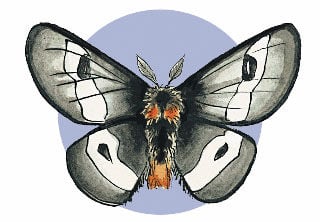 |
I am a buck moth, or Hemileuca nevadensis.
I am rather large in the larva stage, and when I emerge from my cocoon I measure about 2 inches.
As a caterpillar, I am gray with black spots and a red head. I have six rows of spines covering my back, and I can use them to defend myself. I can let go of the spines, and they will stick in whatever is trying to touch me. If it's you, the spines can cause your skin to burn and blister. To remove spines, try cellophane tape.
As a moth, my body is gray and hairy with a red spot at the top of my abdomen. My wings are gray around the edges and white in the middle, with a gray spot on each wing.
My life cycle begins when the female lays a cluster of eggs on a tree branch. Larvae hatch in the spring and quickly begin feeding. In early summer, they spin cocoons under a thin layer of earth, shed their skin and become moths in the fall. Females repeat the cycle the next spring by enticing males with a special scent.
My arrival in the autumn, when deer are in season, is the source of my name.
I fly during the day, unlike most of my moth counterparts.
Critter: Buff-breasted flycatcher
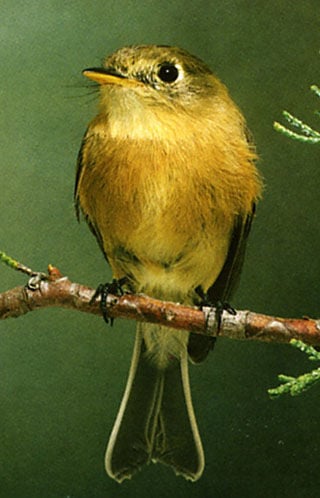 |
My name? Empidonax fulvifrons for you technical folks, and for the rest of you, just call me buff-breasted flycatcher.
Visit me at my summer getaway: I arrive around April and stay for the summer before flying to Mexico for the winter. You'll find me in the Huachuca Mountains, at Sawmill, Carr, Scotia and Sunnyside canyons.
Listen for me if you get lost: My song is a quick chicky-whew - it's highly distinctive.
You'll recognize me: I'm brownish-olive on top and have rich brownish-yellow underparts and bold, white eye rings.
We'll go out to lunch: My favorite place is over a pine branch where we can pick insects from among the needles.
Critter: Bullock’s oriole
 |
Name: Bullock’s oriole
Description: Measures from 7 to 8½ inches. This bird is black with an orange bottom, shoulder patch and breast. Its cheeks and eyebrows are orange, and it has a large, white wing patch. The female and younger males look similar to one another; they are grayish-olive with white tummies and yellowish or buff throats.
Usual haunts: Woodlands. They really like shade trees. They used to prefer the American elm for nesting, but it is on the declineso they have moved on to other trees.
Housing The woven nests are made from bark, string and plant fibers.
Offspring: 4-6 grayish eggs with dark spots.
Interesting fact: The Bullock’s oriole and Baltimore oriole are very similar.
Sources: The National Audubon Society “Field Guide to North American Birds” and “Birds of the Southwest.”
Critter: Burrowing owl
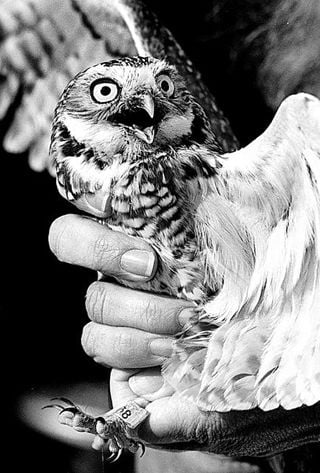 |
What to call me: Burrowing owl. My formal name is Athene cunicularia.
Tell me I'm beautiful: I'm 8 to 10 inches tall and have a wingspan of up to 21 inches. I'm brown with white or tan spots, yellow eyes and long legs that are practically featherless.
Favorite places: I'm found from southwestern Canada to the tip of South America. I like open country, prairies and deserts.
My house: It's a rental. I get my name from the fact that I make my home from the burrows of such mammals as prairie dogs and ground squirrels. I also can use holes made by kind folks who feel sorry for me when my habitat is bladed over.
Lunch: I'm partial to insects, rodents and smaller reptiles. Males and females both hunt.
Family time: Moms have one brood a year, laying five to 10 white eggs. Dad brings food, while Mom incubates and then cares for the young. The babies stay underground until it's time to exercise their flight muscles before they're fully fledged.
- Cool facts:
- We are sometimes seen standing on mounds or fence posts during the day. I look like I'm nodding when I'm approached, but it's really because I'm not sure I should trust you.
- We can scare predators away from the nest by making a sound quite similar to that of a rattlesnake.
Critter: Cactus ferruginous pygmy owl
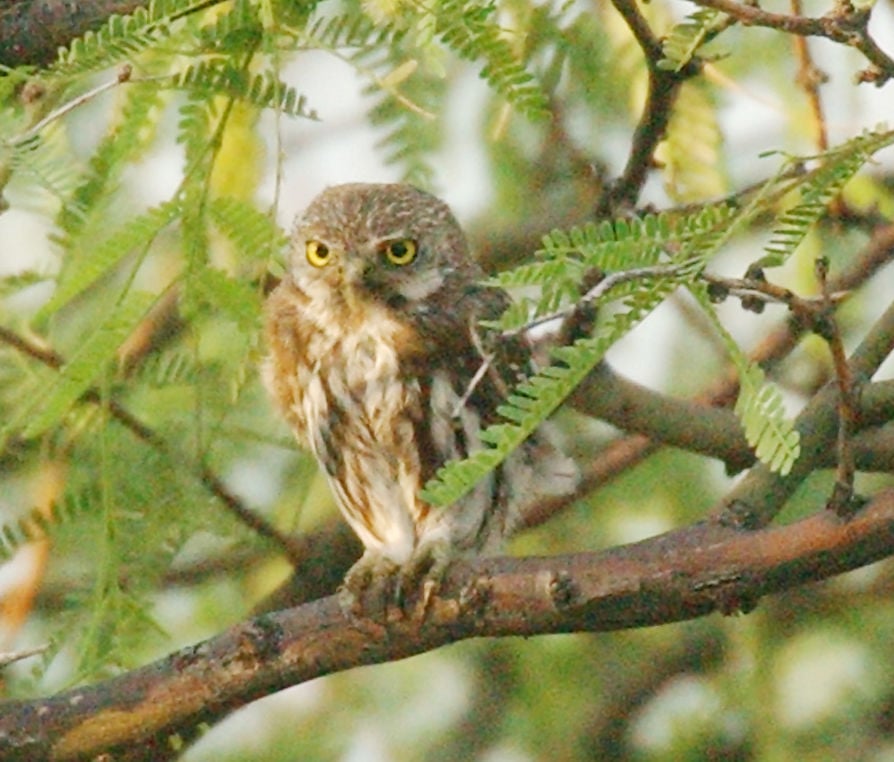 |
And the winner is: Cactus ferruginous pygmy owl
Long name, little bird: I am 6 to 7 inches long, reddish-brown and have a cream-colored underside with red-brown streaks. I have yellow eyes and black spots on the back of my head that look like eyes. I have no ear tufts.
Neighborhood: My kind ranges from Southern Arizona and South Texas to Central and South America.
Local address: I like to live in hollows of saguaros or trees. The ironwood tree is an excellent choice.
Lunchies and munchies: Lizards and large insects are especially delicious. I also like the occasional scorpion, small bird and mammal.
I love the night life: I'm most active at night but I also get out during the day, especially early and late in the day.
Family time: I'll lay three to four white eggs at a time, and they'll take about four weeks to hatch. My mate feeds me while I care for the eggs. We feed the babies together, and they'll fly about a month after hatching.
Why my name sounds familiar: I am known for stymieing building projects when they might interfere with my habitat. I am listed as endangered, and many feel I am running out of places to live.
Source: Arizona-Sonora Desert Museum and the Arizona Daify Star archives
Critter: Cactus mouse
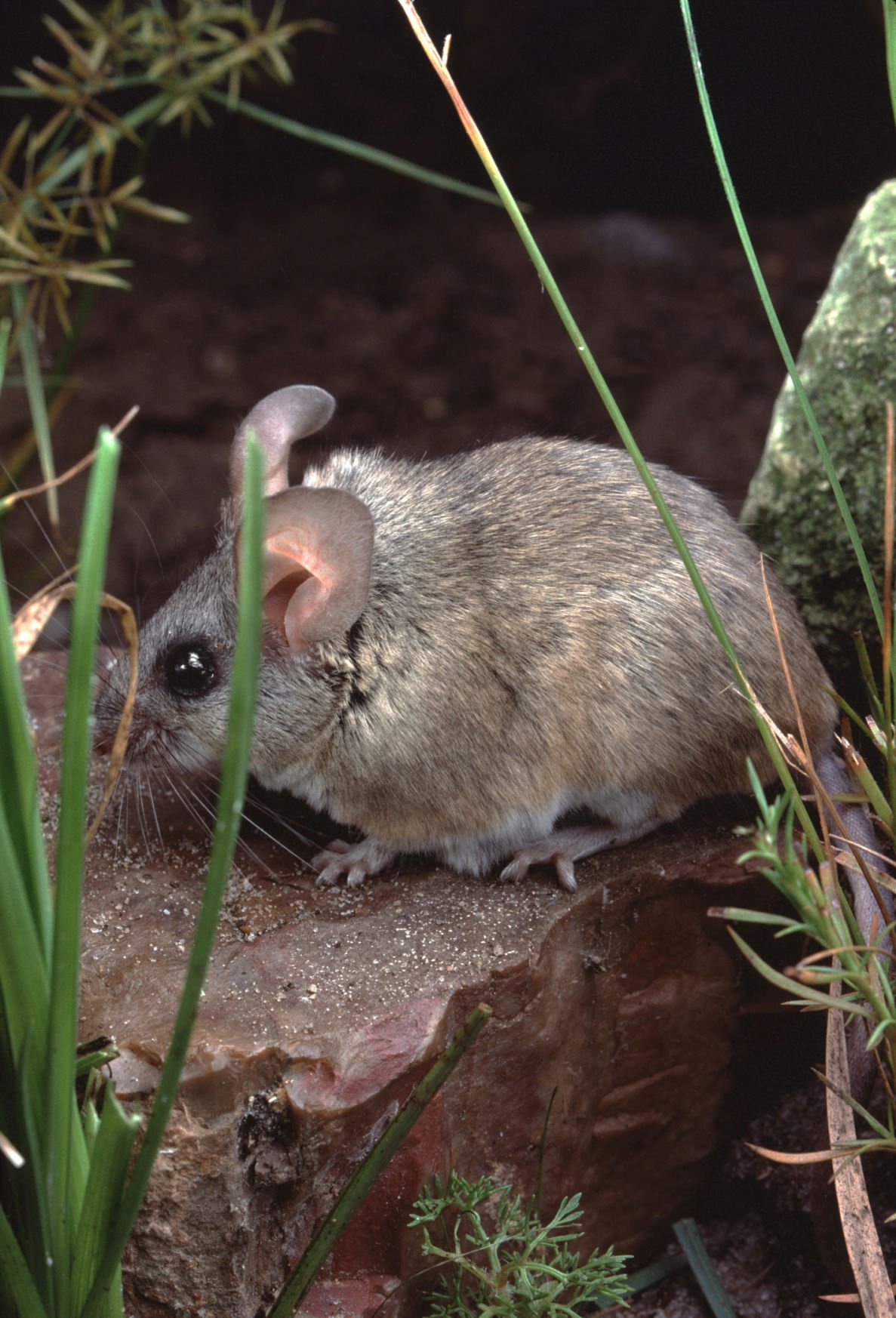 |
Name: Cactus mouse, Peromyscus Eremicus
Description: I'm about 3½ inches long and grayish-brown. My tummy and feet are white. I have big ears and a tail with a little bit of faintly bicolored hair.
Usual haunts: I'm found in Arizona, Baja California, and the southern parts of Utah, Nevada and California. I am also found in Sonora, Mexico, and in southern Mexico. You can find me along washes and rocky hillsides and in sandy desert and desert foothills.
Housing: Grass and twigs are the building materials I use. I have been known to use bird nests abandoned by verdins.
Eats: I'm partial to a variety of seeds, fruit and various plant materials.
Offspring: The female can have three to four litters a year with four to five little, little ones per litter.
Fascinating fact: This critter gets the water it needs from its foods. This mouse is a source of food for owls, foxes, coyotes and snakes.
Source: Arizona-Sonora Desert Museum
Critter: Cactus wren
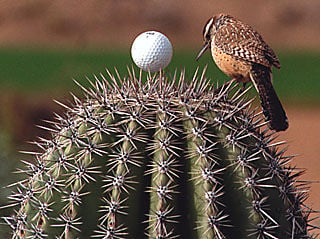 |
My name is: Campylorhynchus brunneicapillus, but I also answer to cactus wren. I'm the best-known wren in these parts, and I'm Arizona's state bird.
I break the rules: Most wrens are small and plain, but I'm almost twice the size of them - about 8 inches. I have a brown head and white stripe above my eyes and spots on my breast. My bill is curved, so I can probe for insects.
My stomping grounds: If you look at my name, you can guess. I like deserts and foothills with cacti. People often picture me peeking out of a saguaro, but I'm more comfortable in a spiny cholla cactus, although a saguaro is also nice. And, no, I didn't make that hole in the saguaro. A woodpecker most likely did that.
What's cookin'? I eat insects, seeds and fruit pulp. I probe crevices on the ground and in low trees for my meal. We forage in pairs or groups, unlike other wrens.
Family matters: We nest from mid-March through early September. Both parents build the first breeding nest, and Mom lays three to five eggs. Then Dad builds a roosting nest while Mom incubates the eggs. She'll use the new nest later. When the young hatch, Dad cares for them while Mom is incubating another clutch.
Critter: Canyon towhee
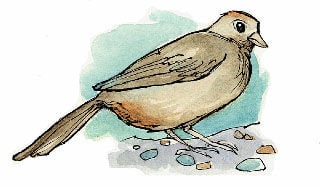 |
Presenting canyon towhee, of the perching birds, aka Pipilo fuscus.
Formerly known as brown towhee.
Featuring the song chili, chili, chili, chili and the call chud-up.
Straight from the rocky, brush-covered hills of arid regions.
Dressed to the nines in a full-length grayish-brown coat against a buff throat, adorned with a brown necklace complementing the dark-brown birthmark on her chest. She tops it off with a rust-colored crown to match her undertail feathers.
Joined by three or four bluish-green eggs (with brown-black markings) fresh from the nest.
Playing in Southern Arizona, central New Mexico, West Texas, northern Mexico and everywhere in between.
Critter: Canyon tree frog
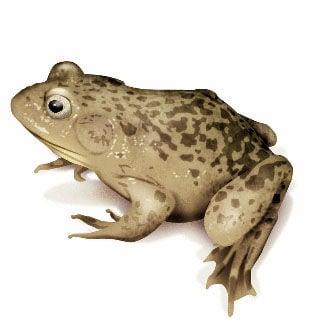 |
What's in a name? Canyon tree frog, aka Hyla arenicolor: I'm not sure why I'm called a tree frog, since I spend little of my time in trees. I prefer to crouch in small hiding holes in rocks near the water's edge, close enough to jump in when danger approaches.
Chameleon: I'm small, with highly variable patterns and colors. Ground colors of cream to brown and irregular bars, blotches and spots of olive to brown serve as perfect camouflage. My color matches my surroundings extremely well, and I can change colors quickly as my surroundings change.
Picky eater: Not me. I eat a variety of insects.
Background: From March to August, a loud rivet-gun like sound of mating tree frogs fills the evening air in arroyos and canyons. Eggs are laid in large quantities, and they float on the surface of the water.
Don't look: Even though I'm familiar with most of Arizona, I'm extremely shy and hard to find.
Critter: Canyon wren
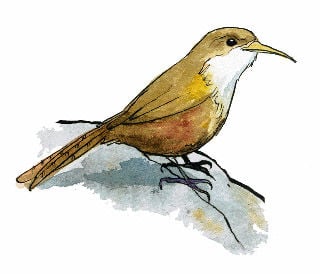 |
I am a Catherpes mexicanus, but you can call me a canyon wren. Please don't confuse me with the state bird of Arizona, which happens to be the cactus variety of my kin.
I am 5 1/2 to 6 inches in length. My wingspan is about 7 inches. I weigh between 9 and 18 grams. I am brown or dark rust. I have a white throat, and the white extends down to my upper chest. I have a low center of gravity and large feet, which make it possible for me to climb around on rocks.
I like western Canada, and the western United States from Montana and western South Dakota all the way south into my favorite country, Mexico. I can be found in canyons and cliffs.
You would know my eggs because they are white and have specks of reddish-brown. I usually have from four to six eggs at a time.
My songs can be heard in canyons, but you must look long and hard to find me because of the way sound travels. Look up. I am probably perched up high.
I am elusive and have never been seen drinking water. I get all the water I need from the insects I eat.
Critter: Cardinal
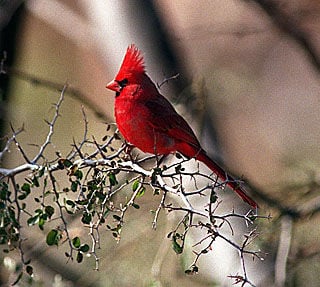 |
Name: Cardinal aka Cardinalis cardinalis.
Description: The males are red with black faces. The older male bills are red, and the young male has a black bill. Females are light brown or tan with a red bill and crest.
Usual haunts: Prefer to live on the edges of woodlands and streams. Also like mesquite thickets.
Eats: Insects, berries and seeds.
Looks like: The female is often mistaken as a male pyrrhuloxia, which has an ivory-colored bill and is grayer in color.
Offspring: This critter usually has three or four eggs. Incubation lasts 12 or 13 days.
Cool stuff: The cardinal's nest is cup-shaped and made of twigs and plant stems. It is lined with grasses and hairs. The nest is made in areas with dense shrubbery or in mesquite, and is five to 10 feet off the ground.
Nesting starts in late March and extends into early April.
Critter: Cat flea
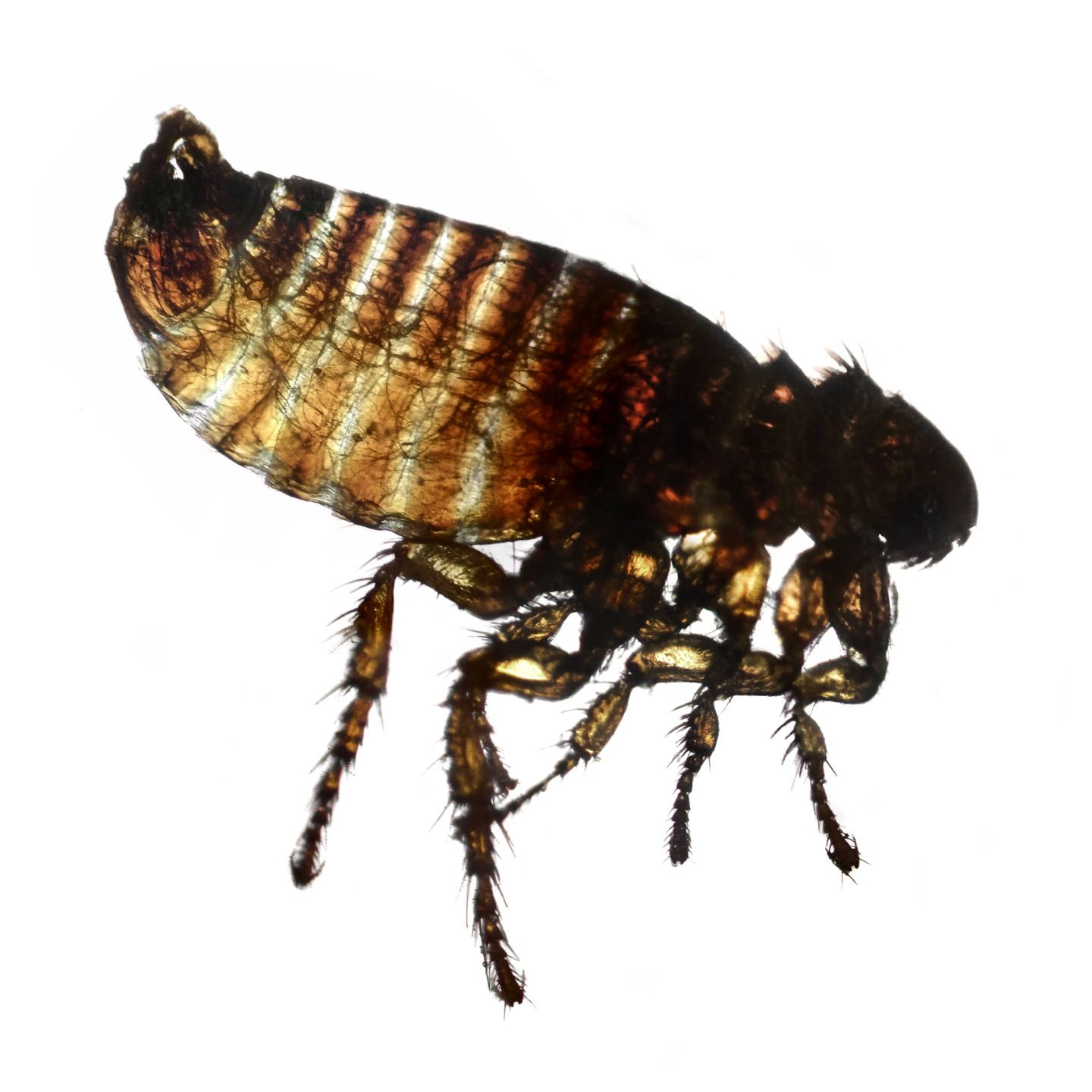 |
My name: I am a Ctenocephalides felis, but you know me as a cat flea.
My home: I am mostly found on your cat, dog and other pets. They pick us up in the yard or in other areas where they like to relax. Once picked up by the animal, we lay eggs and live throughout the area where the animal lives.
How we grow: We lay a large number of small, white eggs that eventually turn into ½-inch-long worms. The larvae spin a cocoon and change into an adult flea.
Our features: We have a flat body that helps us move through hair and fur easily. Our hind legs are powerful and allow us to jump easily. Spines near our head allow us to attach to the host firmly, so it cannot easily get rid of us.
How you know we are there: Once we find a host, we live by feeding on the host's blood, making us ectoparasites. Although we can live on you humans, we usually do so only after you come in contact with an infested animal. Once bitten, you'll see the red, itchy mark that tells you that we got you!
Source: "Learning About & Living With Insects of the Southwest," by Floyd Werner, Ph.D., and Carl Olson, M.S.
Critter: Chiricahua leopard frog
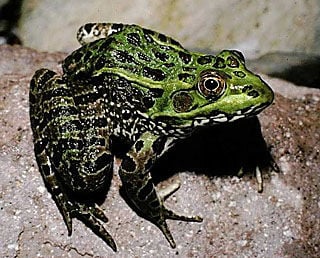 |
My name: Chiricahua leopard frog, or Rana chiricahuensis
My appearance: I am a stocky frog with a rounded head, short limbs and a mostly green head. Most of my body is a brown or green tint, with small gray spots peppering my thighs. My belly may be a white or yellow color that extends down to my lower abdomen and groin area.
My home: I live in the mountains of Central Arizona and Southeastern Arizona, as well as in the mountains of southwest New Mexico and even in Mexico. My population is on the decline in Arizona and New Mexico.
I co-exist and sometimes breed with similar species of frogs in some areas, including the Plains leopard frog, the Northern leopard frog and the Lowland leopard frog.
My activities: I like to live near water, whether in forests or in desert, and spend much of my time in small basins, streams or water holes.
My family: I breed from May to August if I live in the upper mountain regions and from March to June if I live in warmer areas.
My voice: I have a snore-like croak that sometimes drops in pitch at the end of the call. I can even call underwater.
Critter: Cholla long-horned beetle
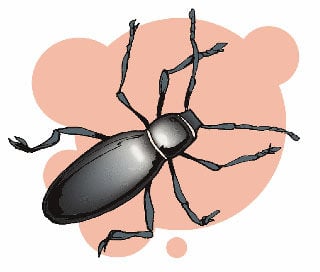 |
Ladies and gentlemen, the beetles: Not the singers but the cholla long-horned beetle, aka moneilema gigas.
My family: Cerambycidae, a very large family of North American species that includes a wide variety of attractive and brightly colored beetles. I'm about an inch long with a smooth black appearance and an armor-plated body.
My world: Even though I'm unable to fly, I'm well-adapted to desert life in the Southwest. I have large pads on my feet, like hiking boots, which allow me to move around the spiny jungle of a cactus.
Scare tactics: To help protect myself from predators, I make a squeaking sound by rubbing my thorax and abdomen together.
When hunger strikes: I normally feed on cholla or prickly pear cacti, but like many opportunists of the insect world, I sometimes take advantage of the young and defenseless. I've been known to find a seedling saguaro and consume it.
Critter: Christmas mouse
 |
Merry Christmouse!
What am I?: I am a Christmas mouse, aka a Christmouse, the Mouse King or a cute little holiday critter.
Coming to a card near you: This is my season for spreading good cheer. You will see me on all kinds of cards and holiday decorations. I can be large or small, ceramic or paper, whatever you want. I often have a striped nightshirt and carry a candlestick.
My place in history: Historically, I have been around for some time. "The Nutcracker and the Mouse King" was written by E.T.A. Hoffmann in 1816. That work immortalizes the more sinister royal side of my family. My ominous uncle is frequently seen this time of year in plays and ballets. He is finally felled by a young girl's slipper, but not before scaring many young children.
They thought I was not stirring in the 1822 poem "The Night Before Christmas"; However, I was actually in my nest putting the final touches on some presents for the young-uns.
Family spat: I do have a wealthy cousin with large, black ears who always appears around now wearing a Santa hat. No names, but his initials are M.M. Fortunately, there is always plenty of the holiday spirit to go around, but I don't see why he needs to horn in on my seasonal work.
'Tis the season: In the words of my good friend Santa, "Happy Christmouse to all, and to all a good night."
Critter: Chuckwalla
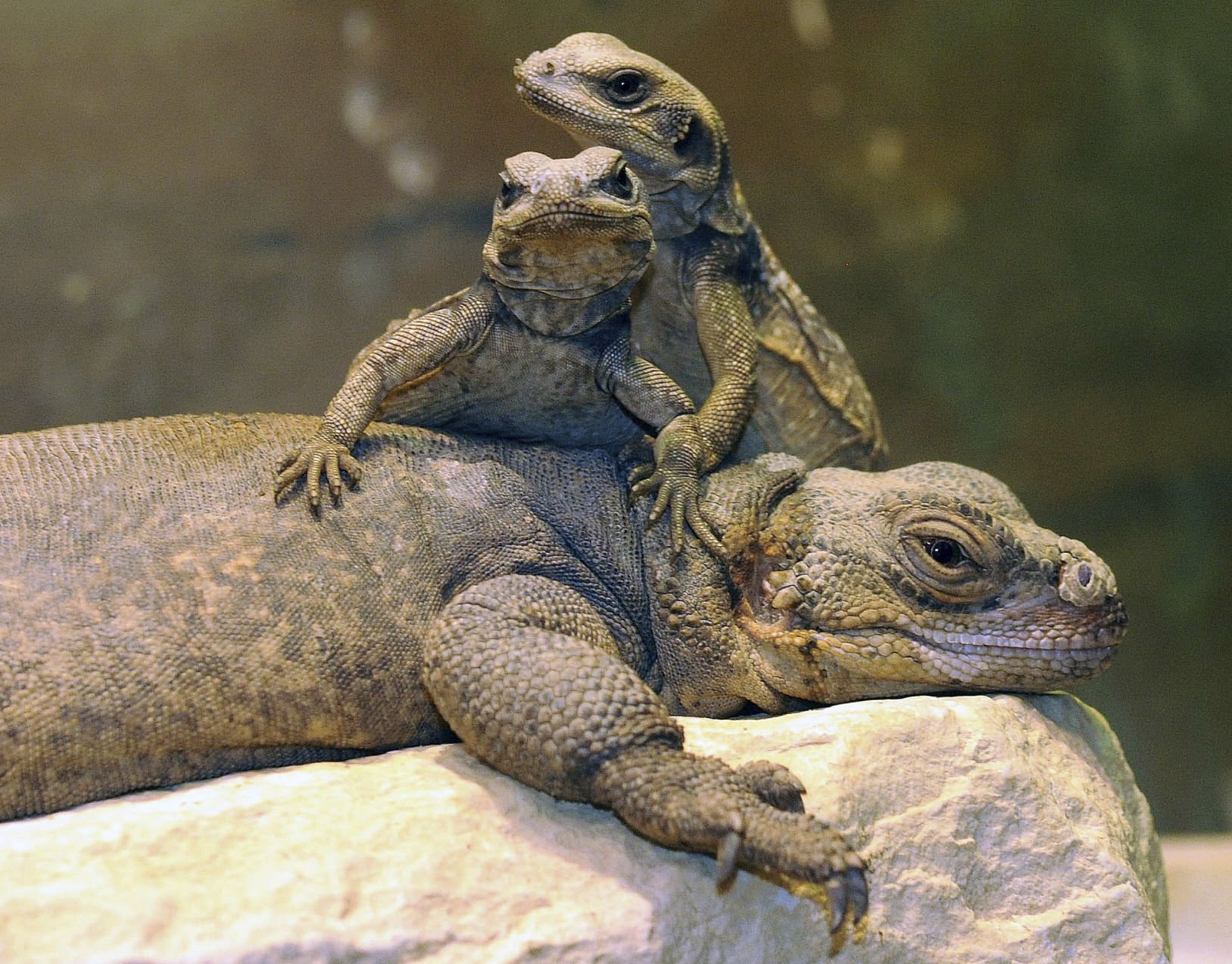 |
My name is: Chuckwalla aka Sauromalus obesus
Admire my beauty:
I grow up to a foot in length and have loose folds of skin on my neck and sides. I have a dark head, chest and legs and the rest of me is red-orange or light gray. My tail is light yellow.
Hanging out: I prefer the desert, especially rocky hillsides, lava flows and rock outcroppings.
Favorite snacks: I munch on leaves, flowers and seeds. Cactus fruit is also nice.
When I'm the snack: Sometimes small mammals and birds of prey try to make a meal of me, but I know how to hide.
The family way: Our females lay clutches of five to 15 eggs in the summer.
A sense for self-preservation: When I'm in danger, I hide in rock crevices and gulp air to inflate myself myself so I can't be pulled out by hungry hungry birds.
Beautiful and smart: I can change color from dark to light and back to reflect or absorb heat from the sun.
Source: Arizona-Sonora Desert Museum and the Phoenix Zoo.
Critter: Chupacabra
 |
Name: I am a chupacabra. Some call me a goatsucker.
Lizard, dinosaur or alien? There are varied descriptions of me. Most involve vampirelike fangs, red eyes, a reptilian/alien body and quills or spikes running down my back. Many say I leave an awful stench in my wake. Some say I have a tail. Some say I have wings. I'm not telling.
Catch me if you can: I am believed to roam Puerto Rico, Mexico and the southern United States. But why give myself away?
Why you're afraid: I am called "goatsucker" because I am believed to suck all of the blood from goats and other hapless victims that cross my mysterious path. Apparently, I use my fangs to make punctures in the neck (arteries are so convenient) and suck my victim dry. Yum! It is also said that I take the internal organs.
Other fascinating tidbits that may or may not be true: I can fly. Then again, maybe I can't. Maybe I can just hop very high and very far. I could be a secret government experiment that got away. Or maybe the government sent me out to take care of some "problems." The secretive government is not telling. And neither am I.
Critter: Coachwhip
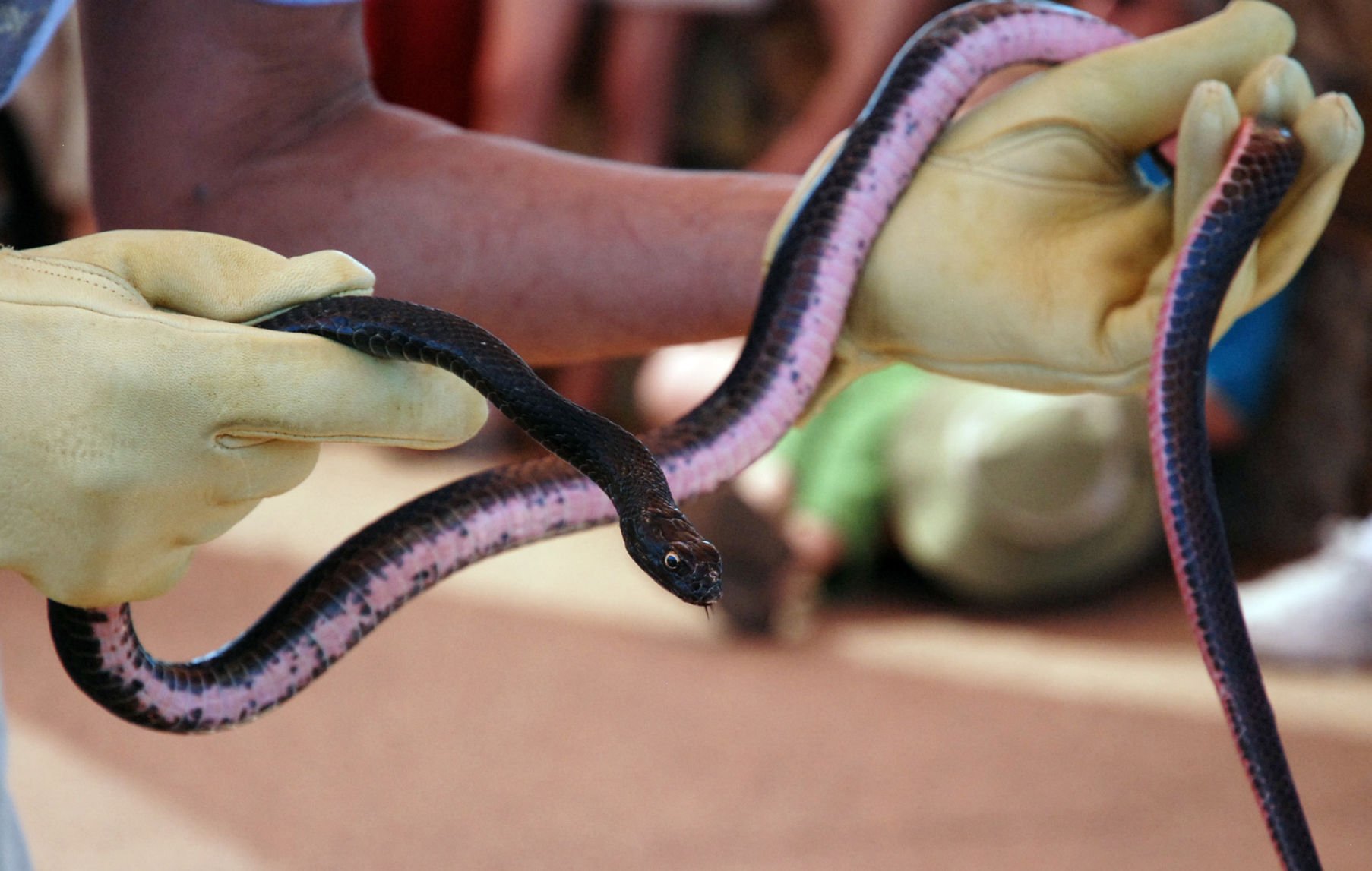 |
Who am I? Coachwhip, aka Masticophis flagellum
What I look like: I'm slender and long about 3 to 8 feet in length. My color varies widely from tan, gray, pink, black, reddish-brown or a combination of these colors. I have large eyes, smooth skin and black crossbars.
A fun fact: I got my name because some thought I resembled the whip used by stagecoach drivers.
Where my home is: I'm found throughout Arizona except the northeast corner of the state.
Activities: I'm most active in the morning or late afternoon. Clocked at 3.6 mph, I can move quickly out of sight into a rocky spot or a rodent burrow to escape a threat. I may also face an intruder by hissing and striking. I will bite if handled.
A large appetite: I'll eat lizards, snakes, mice, birds, bird and reptile eggs, and insects. My meals are swallowed alive.
Source: "A Field Guide to Western Reptiles and Amphibians, " by Robert C. Stebbins; and the Arizona-Sonora Desert Museum.
Critter: Coati
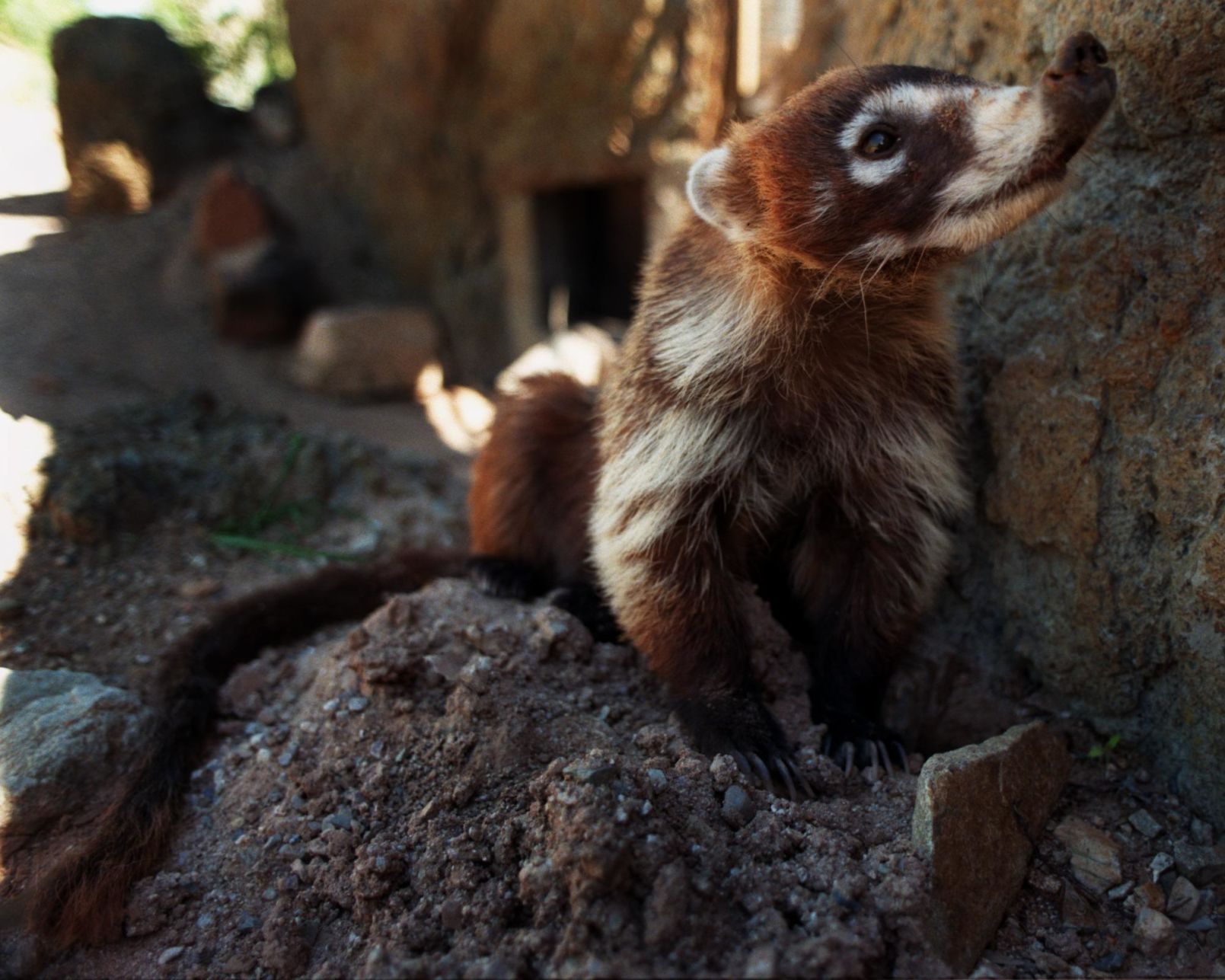 |
Name: Coati, aka Nasua narica
Identification: The coati's black face mask and white ring around the eyes resemble those of its relative, the raccoon. A long tail faintly ringed with light and dark shades of brown is used for balance.
Location: Throughout the American Southwest. A cave-dweller generally found in the Chiricahua, Santa Rita and Santa Catalina mountains.
Eating habits: It feeds on a large variety of animal and vegetable material. It has a keen sense of smell and uses its nose to root out insects, lizards or tubers.
Family: The females and young travel in groups of 20 to 75. The males are solitary and only join the group during breeding season. The young are born in July, with four to seven in a litter.
Interesting fact: The coati communicates by wagging its tail. The tail in the up position indicates safety. The tail in the down position indicates fear and danger.
Source: Arizona-Sonora Desert Museum
Critter: Cochineal bug
 |
What am I? I am a cochineal bug, dactylopius confusus. I belong to a group of insects called scales.
What's that weird white stuff? If you have seen a prickly pear that looks like it was the target in a spitball contest, you have seen me. Or rather, you have seen where I am living. If you break through the waxy white crust you will find the female. She resembles a quarter-inch-long red bag, like an engorged dog tick. The males are very tiny and seldom seen.
How did we get stuck on that cactus? After emerging from their eggs, the juveniles form long wax filaments that enable the wind to carry them off to a new cactus. Their beaks can pierce the plant and allow them to feed on its juices. They then form the waxy crust to protect themselves and their new neighbors.
Red Dye #? Very few insects eat us because of the red pigment we produce. However, we are used as coloring for people food, although some folks get squeamish at the thought.
The Redcoats are coming! Early New World explorers realized we produced a beautiful red pigment and took us back to Europe. We gave the British those bright red uniforms as well as helping out Michelangelo with some of his paintings.
Wash us away! We will only kill the cactus if it is a heavy infestation. Otherwise, cut off the damaged pad or hit us with a strong stream of water.
Critter: Codling moth
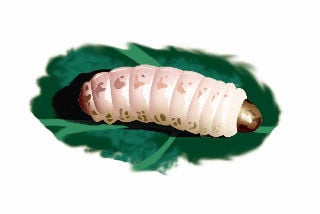 |
Seeing all of me is better than only seeing half. I am an appleworm as larvae. When I grow up, I am a codling moth.
I am a pinkish caterpillar. I love to tunnel through apples and pears. Some people might think I am destructive to fruit, but I just love to eat.
You can recognize me as a moth by my grayish-brown and white coloring. I am 1/2-inch long. When I fold my wings, you can see a dark semicircle on the back edge of my forewings.
There are several generations of my family every year.
Bon appetit, and don't forget to look for me in your next bite.
Critter: Common collared lizard
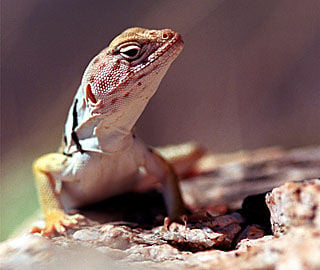 |
Name: I am a Common Collared Lizard, aka Crotaphytus collaris. I received my name for the black and white band around my neck.
Looks: "Leopard" spots cover my face, legs and tail area. My skin feels granular, and my overall color can vary from grays to greens and yellows. My colors tend to fade as I get older. I am usually 10 inches or longer.
Babies: In breeding season, females develop orange spots and bars on the side of their necks and bodies, which fade after they lay their eggs.
Haunts: I love rocky areas in canyons, in which I can run and jump from rock to rock and bask in the sun. On mountain slopes, I like to find open areas in which to sun.
Dining habits: I eat small reptiles, lizards and insects.
Human interaction: I am not very happy about being handled and will try to bite.
Critter: Common poorwill
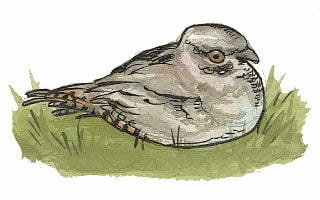 |
Call me: Common poorwill
What a looker: I'm a small nightjar between 7 and 8 1/2 inches long. Nightjars are nocturnal. I have a short beak and legs, and I also have soft feathers that are spotted with many colors, including gray and brown. Check out my white throat and collar, and take a look at my dark tail feathers, rounded with white tips.
Where I hang: You'll find me breeding in southeastern Canada and in the Western states. My winters are spent in the American Southwest and in northwestern Mexico. Look for me in desert, sagebrush, chaparral and arid upland areas. Sometimes I can be found sitting on roads at night.
When I get the munchies: I eat insects, which are caught on my wings.
My eggs: I lay two pinkish-white eggs on the ground.
More cool stuff about me: The California desert has a common poorwill that hibernates. This cousin of mine lowers its body temperature and goes without food.
Critter: Cooper's hawk
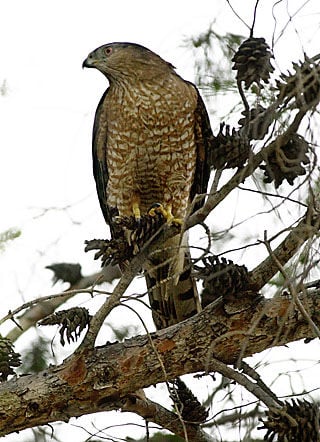 |
Name: Cooper's hawk, aka Accipiter cooperii
Description: This critter is slate-gray with a white face and neck. Its belly and upper legs are white and rust-striped. It has a long tail with a rounded tip and short, rounded wings. This hawk is about the size of a crow, measuring 14 to 20 inches, with a 28-inch wingspan. The young are brown with white bellies, which have fine streaks.
Usual haunts: Found from southern Canada to northern Mexico. Can be found in the low desert in winter or during migration. Likes the wooded areas near streams, canyons and arroyos.
Eats: Fond of small vertebrates and other birds.
Housing: Prefers stick nests in large trees, usually more than 20 feet high.
Offspring: This hawk lays four to five eggs, and the female incubates them by herself. However, both parents are responsible for feeding the young. They take care of themselves when they are about eight weeks old.
Critter: Costa's hummingbird
 |
Name: Costa's hummingbird aka Calypte costae
Take a picture: We are about 3 inches long with a straight, thin bill. We have bright green backs and crowns, white underparts and a dark tail. The males have an iridescent purple crown and gorget. Females and young have a white chin and white tips on the outer tail feathers.
Dinner time: We just love nectar from flowers, especially red ones. We're also partial to small insects. No junk food for us.
There goes the neighborhood: We like California, Nevada, Utah, New Mexico and Arizona during the warmer months, but in winter, Southern California and Southern Arizona are best.
Housekeeping: We like to live in deserts, washes, sage scrub and hillsides. Our nest is a tiny cup in a bush or small tree.
The family way: Females will lay two white eggs, which take 15-18 days to incubate.
My voice: We'll make a soft "chik" sound when we have something to say.
Critter: Coyote
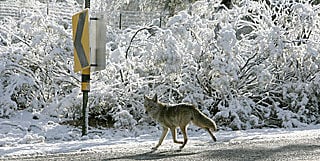 |
I am the Barking Dog: That is what my Latin name, Canis latrans, means, but you probably call me a coyote.
Coyote not ugly: I am about 2 feet high and about 4 feet long. My coat is a grizzled gray or orangish gray with long rusty or yellowish legs. I have prominent ears and a long, slender snout.
Supercoyote: I have cruising speed of 25 to 30 mph, but I can hit 40 on the straightaway - well, at least for a short distance I can. I am also able to leap tall buildings, if they aren't more than 14 feet high.
Solitary teamwork: We coyotes usually hunt alone, but sometimes we combine efforts with a couple of other coyotes. Then we run a tag team effort to bring down our prey or wait in ambush for the quarry to be chased right to us. We will even wait at the back door of a rodent burrow while a badger is digging at the entrance. And you wondered where the expression "wily coyote" came from!
The tale of the tail: I have a long bushy tail with a black tip. When I run, my tail is down, unlike a dog that holds his up or a wolf whose tail is out straight.
The barking part: Coyote vocalizations are quite impressive. If you have ever heard the incessant barking and yelping of a pack coyotes or my lone plaintive, primal howl, you won't soon forget it.
Critter: Crab spider
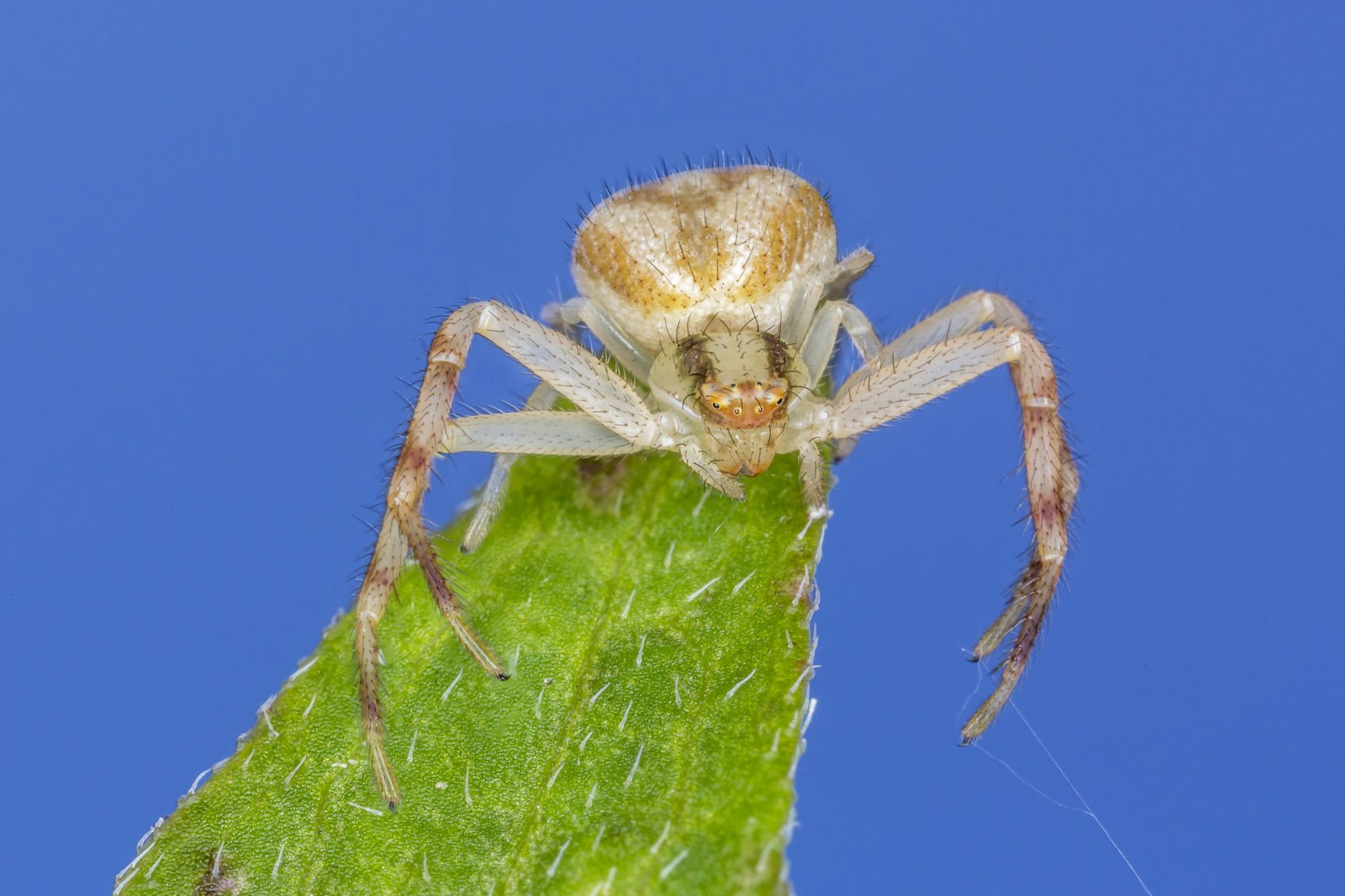 |
Name: I'm a crab spider, and I come from the family Thomisidae. There are 200 species of crab spiders in North America.
Appearance: We're called crab spiders because of our resemblance to aquatic crabs. Our first and second leg pairs are much longer than the third and fourth and are held out in a crablike fashion. Just like you humans, we can walk sideways, backward and forward.
Offspring: Our name implies that we have a bad personality, but, on the contrary, male crab spiders are actually romantic. Males may wrap females in silk before mating. Ooh-lah-lah! After mating, females spin a silk cocoon to deposit the eggs. Females will defend the cocoon vigorously - so vigorously that they don't even eat during this time! Females usually die before the eggs hatch.
Hiding in plain sight: Crab spiders don't use webs (surprise!) but instead employ a camouflage and hunting strategy. We sit on tree bark, leaves, flower petals, etc., waiting for insects that we can attack. Some in my family can change their colors to match the plant they inhabit.
We don't hurt ─ much: Don't worry too much if you get a bite from one of us. Our bite is only mildly venomous. Just wash the wound with soap and water and apply an antiseptic. Go to the doctor if you experience an infection or allergic reaction.
Source: "Scorpions and Venomous Insects of the Southwest" by Erik Stoops and Jeffrey L. Martin
Critter: Dainty sulphur butterfly
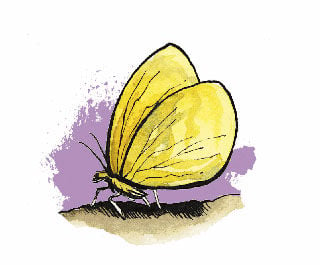 |
My name is: Nathalis iole Boisduval, but I am more commonly known as a dainty sulphur butterfly.
What I look like: I am only about an inch long, with yellow coloring and black markings. Females usually have more black coloring than males.
Where I live: You can find me in open, dry places like meadows, hillsides and roadsides throughout the Southwest and Florida. I don't fare very well in the cold weather, so I often migrate north during the winter.
What I do with my time: I like to fly low to the ground, picking up reflected heat off plants. When I rest, I move my wings perpendicular to the sun, so the sunshine hits my body and I get as warm as possible.
What I munch on: I feed on the nectar of plants such as asters, marigolds, shepherd's needle and sneezeweed.
My reproductive habits: Females lay single eggs on the leaves of low-lying plants, where they become caterpillars.
Critter: Desert bighorn sheep
 |
I am an Ovis canadensis mexicana or, as you know me, a desert bighorn sheep.
I have impressive horns. We never shed our horns, and they grow a little every year. Males have horns up to 33 inches long and 15 inches around the base near the head. The horns can weigh up to 30 pounds. Both males and females have horns, but the females have smaller ones.
The males fight for females by ramming their horns with other suitors.
My coloring ranges from grayish brown to cream. The area from my nose to my chin is white. I have a white rear. The tip of my tail is black.
I am about 4 to 4 1/2 feet long, and 2 1/2 to 3 1/2 feet tall. I can weigh anywhere from 75 to 225 pounds.
We hang out in mountain ranges and can be found all over Arizona, except for the east-central part of the state.
I eat mesquite, ironwood and jojoba. I also eat grasses and cacti.
I don't need a lot of water to survive. I can get what I need from cacti. If I can't get to water or a cactus, I can lose up to 30 percent of my weight and still survive. I am able to recover from dehydration quickly.
My hooves are designed to make it easy for me to climb mountains, which helps me escape animals that prey on me.
Critter: Desert cottontail
 |
My name: desert cottontail, aka sylvilagus audubonii, for my white tail that looks like a cotton ball.
My looks: I weigh in at about 2 pounds, and I'm tan or gray. I resemble other cottontails, but I have larger ears.
What we eat: Grasses, forbs, mesquite leaves, beans and cacti.
Where are you, wascally wabbit? We're found throughout the Sonoran Desert. We like thick, brushy areas with plenty of places to hide. We stay close to home, venturing only about 400 yards from the safety of our nest.
Multiply and divide: We are heavily preyed-upon by snakes, coyotes, owls, hawks, foxes, bobcats and humans. Our best defense is our excellent eyesight and hearing, and an ability to reproduce at a prodigious rate. Females can breed at 3 months of age and can have a couple of litters each year. Two to four babies are born blind, naked and helpless, but they're ready to venture out on their own after only two weeks.
Critter: Desert encruster termite
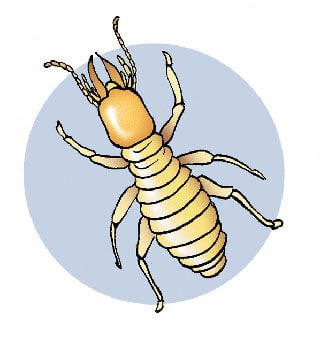 |
My name is: Desert encruster termite, aka gnathamitermes perplexus
Misunderstood: We are social insects, living in colonies ruled by a queen and a king. We are protected by soldiers, and we have plenty of workers on hand to tend to the needs of the colony, including nursemaids, groomers and food gatherers.
Mission statement: Our mission in life is to keep the planet free of dead materials, such as dead grass or weeds. We do not eat houses.
Hungry, hungry termite: We feed by scraping dead wood or desert plants. We then convert what we eat into soil-building materials.
A fresh start: After a summer shower, the workers of the colony bring the winged adults (alates) to the surface and shove them out of the nest. After leaving the nest, some of us find mates, drop our wings and start new colonies.
Critter: Desert red bat
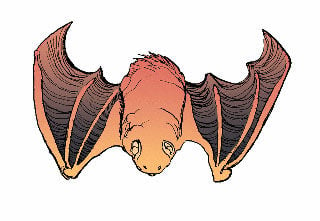 |
You just call out my name: I am a desert red bat, aka western red bat or Lasiurus blossevillii.
Rockin' in the treetops: I am one of a group of bats known as tree bats. That would be because we all like hanging out in tree foliage. We desert red bats are particularly fond of cottonwoods in higher riparian areas. Those of us who have moved to California like the orchards in the Sacramento Valley.
Autumn leaves: In spite of our bright amber color, finding us can be difficult. We resemble dead leaves when we curl up in our furry tail membranes to sleep.
All alone am I: We are the solitary type, only getting together to migrate or mate.
And baby makes three ... or four: Generally, we average three pups per litter, although twins and quads are not unusual.
In the still of the night. We like to feed on moths. Hunting is usually done around the edges of the forest, in clearings and near street lights.
But will you love me tomorrow? You've heard it before and you'll hear it again, our numbers are believed to be declining because of loss of habitat. Come on, guys, plant a tree!
Critter: Desert shrew
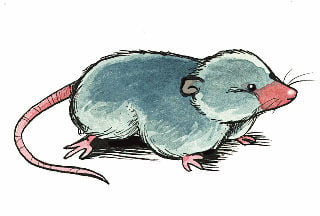 |
Shakespeare never met a shrew like this. But that's because he never visited the southwestern United States, where you find these guys. But the desert shrew, aka Notiosorex crawfordi, might be hard to find anyway, because he doesn't leave very distinguished tracks. He doesn't dig holes, either; he lives in woodrat nests or underneath vegetation.
Oh yes, he's also very small. Only 2 to 3 inches long. Hold a penny in one hand and a nickel in the other, and this shrew will weigh in somewhere in between.
He belongs to an order of mammals called insectivores, meaning he eats bugs, but also lizards and even small mice. He is apparently immune to scorpion venom, so he eats those, too. He eats 75 percent of his body weight every day, but doesn't need to drink water because he gets it all from food.
Be glad you're much larger than he is, because you wouldn't want to be on his list of favorite foods. He keeps food in his nest fresh by keeping it alive. How, you ask? He crushes their heads and bites off their legs. Not fun.
This guy does have predators of his own, nocturnal animals out hunting when he is. Owls and snakes are the reason the desert shrew only lives for about a year.
Critter: Desert spiny lizard
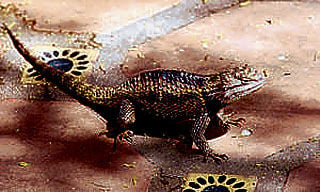 |
Who am I? I am a desert spiny lizard, otherwise known as Sceloporus magister.
Beauty is in the eye of the beholder, so behold this: We can be as small as 3 1/4 inches or more than 5 inches long. We're stocky and light-colored, with pointy scales. Black, wedge-shaped marks are on both sides of our necks. Some of us have orange heads, especially breeding males, and we all have pointed ear scales. Males also have blue patches on the belly.
Welcome to the neighborhood: We like arid regions such as deserts and mesquite woodlands, as our name implies. We're good rock and tree climbers, but we're also found on the ground. We take shelter in crevices, under logs and in the burrows of rodents.
Dinner is served: We eat insects, including ants, beetles and termites - it's not as if we're made of wood and the termites will bite back. We also like spiders and lizards, and we even eat flowers and berries. There's nothing like a well-balanced diet.
Continuing the family line: From May through August, we think about having families. We lay clutches of four to 19 eggs, and we may have more than one clutch per season.
Something you should know: We're inclined to bite when captured. Personally, I think you should just leave me alone.
Critter: Desert Tortoise
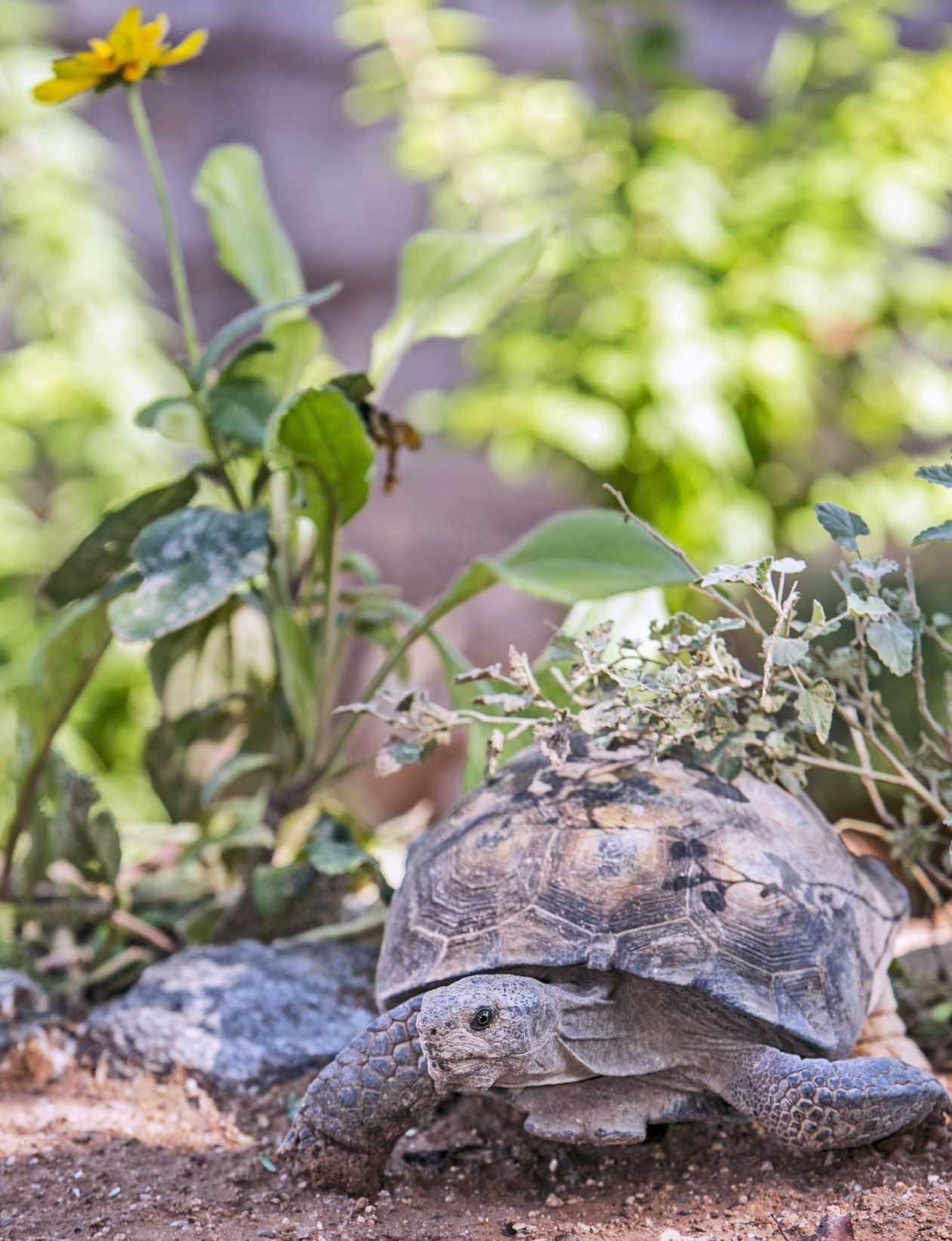 |
Name: Desert tortoise, aka Gopherus agassizii
Vital statistics: Up to 14 inches in length, lives 80 years or longer and has from 2 to 14 offspring at a time.
Last known address: Prefers rocky foothills, burrows into firm soil or between and under large rocks. It is believed that some tortoises don't move more than 2 miles from the nest during the course of their lives.
Menu preference: Grasses and cacti fruit
Enemies: Foxes, ravens and coyotes will snack on young desert tortoises, but the older tortoises find that shell a nice suit of armor.
Cool facts: This tortoise can live without drinking water, instead reabsorbing moisture from its bladder. If one is startled, when picked up in the wild perhaps, it may dump its water supply, endangering itself if there is no rain soon.
Be aware: The desert tortoise is protected in Arizona. The Arizona-Sonora Desert Museum has a Tortoise Adoption Program for those interested in learning about and caring for them. For information, call the museum, 883-1380.
Source: The Arizona-Sonora Desert Museum Web site
Critter: Dog-face butterfly
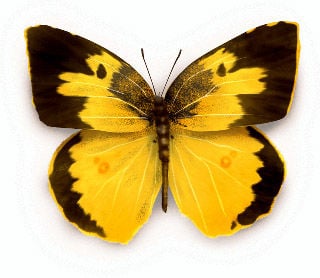 |
When it comes to the world of butterflies, I'm the top dog 'round these parts. No, I'm not conceited, but people do call me a dog-face butterfly, or a Zerene Cesonia to be exact. My name comes from what looks like a dog's head or "poodle face" on my wings, formed by the black area bordering my bright yellow wings.
The dog-face feature is more prominent in males because females lack the distinct contrast in color. But males and females alike can be recognized by the dark spot on our forewing.
I'm quite common in southeastern Arizona and many other parts of the southern United States. Don't be surprised to find me year round. It's common to find me in the cold of fall and I can even survive through light freezes!
My wingspan is about 2 to 3 inches and during the day I fly around searching for a mate. But when hunger strikes I go in search of my favorite food, flower nectar.
Like most butterflies, my life started in the form of a caterpillar. We grow up on small-leaved plants like alfalfa before spreading our wings and taking off in flight.
One of my favorite spots to hang out is on cattle farms because the plants where I breed are promoted for cattle. I also take up residence in dry, open areas like washes, road edges or open woodland.
Critter: Donkey
 |
I am an Equus asinus, or, as you may know me, a donkey.
Several of my brothers are domesticated, but stubborn people label me feral because I don't conform. I reside in the deserts of several Western states, including Arizona, California, Nevada, Oregon and Utah.
Other people who are mulish may think that I am a small horse when they first see me, but all you must do is look at me to see the differences. My body is smaller, and my head and ears are larger than a horse's. My mane of hair on the back of my neck is short, black and stands straight up. I have a dark stripe that starts at the end of my mane and runs down my back to my tail. My coloring is gray or any of a variety of colors and patterns. The tip of my tail is black.
Pigheaded humans think I eat hay, but I prefer herbs and woody plants. I must outwit bighorn sheep to eat because we eat the same types of food. I must have water to drink. One of my best qualities is that when I get dehydrated, I can lose up to 30 percent of my weight and still survive. Even better, I can replenish it all in one drink. Pretty cool, if I must say so myself.
You can find me in the films "Shrek" and "Shrek 2." I was the sidekick. Those filmmakers didn't think I could play the lead, and then they turned me into a horse for part of the second movie.
Critter: Eastern Amberwing Dragonfly
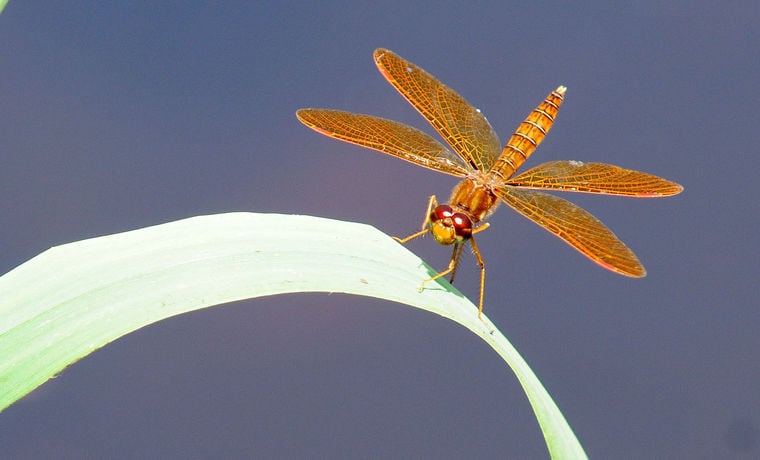 |
Allow me to introduce myself: I am an Eastern amberwing dragonfly, more formally known as Perithemis tenera.
Take a look at me: I am one of the smallest dragonflies in North America, just under 1 inch long. Males have a brown thorax with thin dorsal stripes and yellow spots on the sides. The wings are amber with red stigmas — rectangular spots at the front and ends of the wings.
Females’ wings are generally not amber but have a dark patch in each inner wing and a band of color midway toward the outer wings. Females also have the reddish stigmas.
The home court: I can be found in Arizona, but usually around ponds, lakes and streams. I perch on the tips of shoreline plants and plants poking out of the water. I move my wings and abdomen up and down like a wasp.
Continuing the family line: We form tandem pairs when ready to mate and form a copulation wheel at the point of mating. The male uses his abdominal appendages to grasp the female behind the eyes. and the female extends her abdominal segments and appendages to the underside of the male to receive the sperm packet. The female stores the sperm, and eggs are fertilized just before they are laid right above the waterline on plants.
Source: “Stokes Beginner’s Guide to Dragonflies” by Blair Nikula, Jackie Sones and Donald and Lillian Stokes.
Critter: Eastern fence lizard
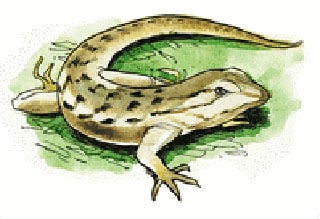 |
You can call me: Eastern fence lizard, aka Sceloporus undulatus. This name was given to me because of my habit of sunning myself on wooden fences, woodpiles or tree trunks.
My colors: I'm gray to brown or rusty in color, which varies based on my surroundings.
Adaptability: The key to my success is my ability to live anywhere. I'm found throughout the United States and Mexico. I live in deserts, woodlands, flatlands, sand dunes, rocky slopes and urban areas.
My favorite thing: I like bright, open places where I can bask in the sunshine on fences or in trees. I'll perch in high places, so I have a good view of approaching predators.
In Arizona: I'm active all year and breed in the spring and summer.
Eats: I forage on the ground with a sit-and-wait attitude. Some of my favorite meals include flies, grasshoppers, termites, beetles and spiders.
Critter: Elegant Trogon
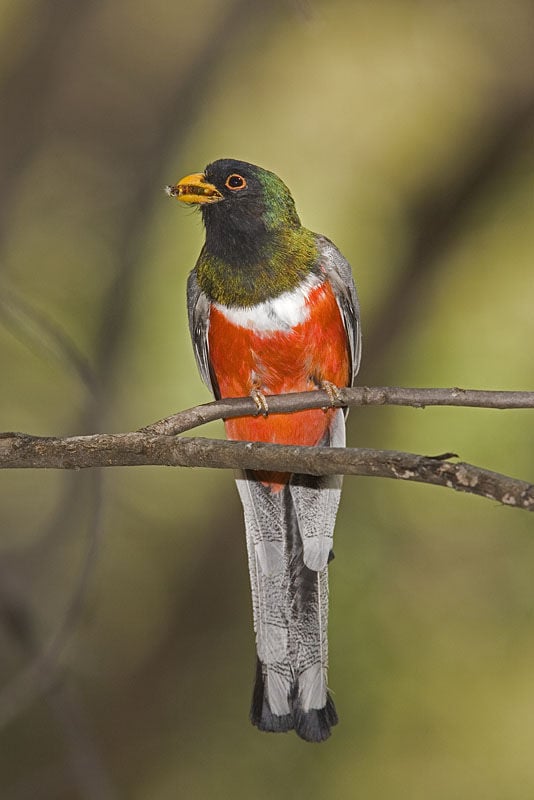 |
I am Elegant Trogon, sometimes called Trogon elegans.
Picking me out of the crowd: I am a brightly colored, parrot-sized bird, about 12.5 inches long. My wingspan measures 16 inches, and I weight about 2.5 ounces. Males have a black throat and face, green head, breast and back and a red belly, with a white line separating my green breast and red belly. The ladies are gray-brown where the men are green or black. The ladies also have a duller red belly and white marks behind and in front of the eyes.
My neighborhood: I can be found in some of Arizona's mountain ranges including the Chiricahuas and Huachucas.
Dinner time: My menu preferences include insects, including caterpillars, cicadas, grasshoppers and beetles, and fruits like wild grapes. Small lizards make a nice meal on occasion as well.
Romance: Gentlemen use complex songs and chases to attract a lady. We use the same nest from year to year. Sometimes these were nests made by woodpeckers, and on occasion we have to persuade other birds to let us move in.
Family time: We nest between May and July. Mom lays 2-3 white eggs that hatch after 19 days. Fledglings start attempting to fly after three weeks, but Mom and Dad still feed them for another three weeks.
Critter: Fairy shrimp
 |
Hello, my name is: fairy shrimp. I know what you're thinking, but I can be found in the Southwest if you know where to look.
Get a look at me: I am roughly an inch long. I am slender and almost transparent, and females have a bulge behind the middle. That's my egg sac. I have many legs to help me swim. Males have a larger second set of antennae, and those of the Southwest have peglike teeth on those antennae. These are used for holding onto females.
Am I really a shrimp? I am a crustacean but not closely related to the shrimp you know. Fossil records indicate my kind came long before they did.
But am I really in the desert? I show up in waterholes and cattle water troughs.
The truth is out there: We dine on microorganisms in the mud of these waterholes. We grow up quickly - within a few weeks - and mate and produce eggs by the time the tank or waterhole is dry. The eggs will last. The next time the hole fills with water the eggs hatch, and the circle of life begins again.
Critter: Familiar Bluet
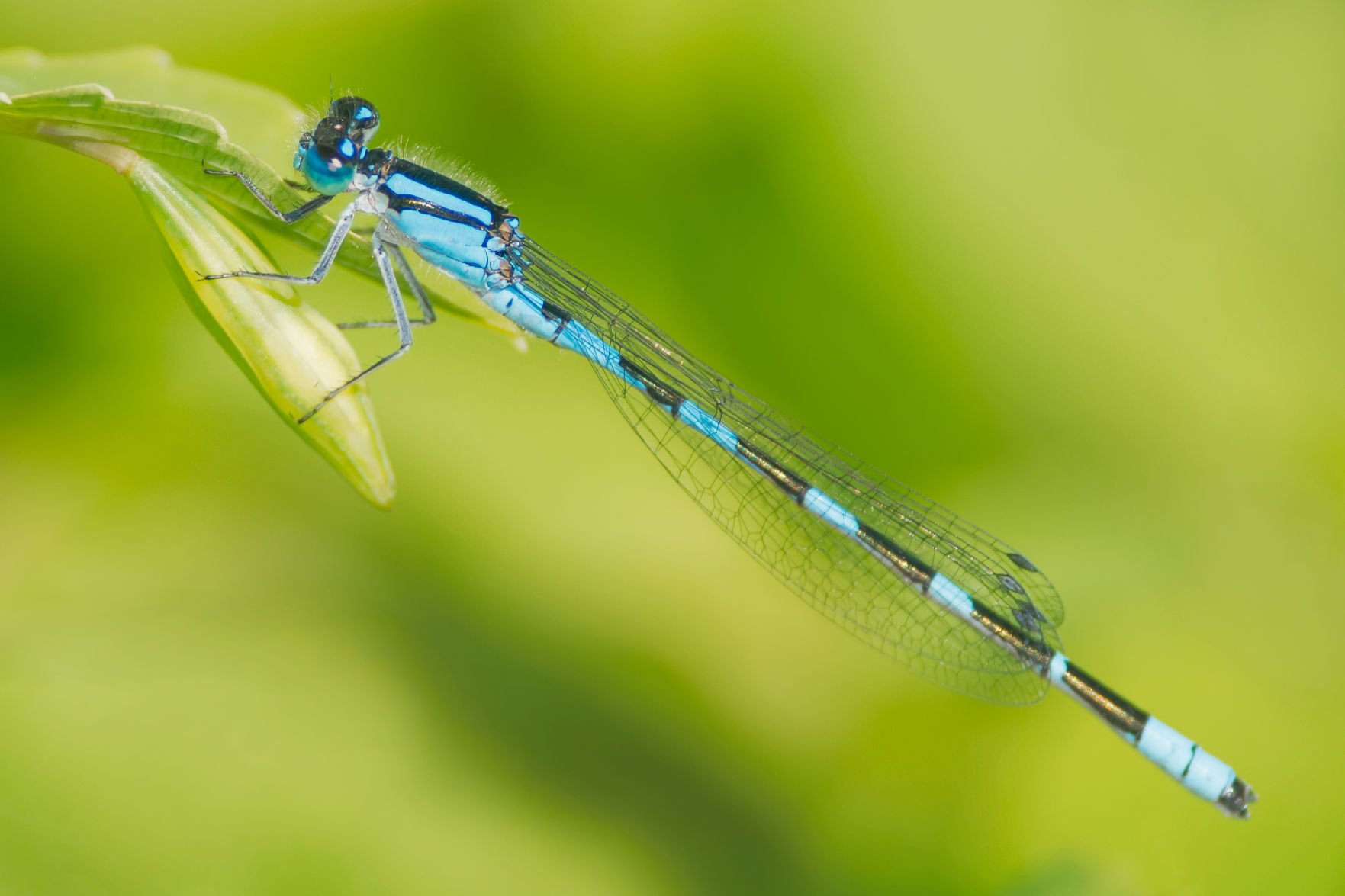 |
Name: Familiar Bluet, akaEnallagma civile. I am a damselfly.
Take my picture: As an adult, I am about 1.4 inches long with a mostly blue thorax and abdomen. I have black markings on my abdomen. Females are duller in color.
I may look like a dragonfly, but I am smaller, fly closer to the ground and hold my wings close together over my back when perched.
Where I hang my hat: You can find us all over most of this country, as long as there is water. I prefer lakes, ponds and sluggish rivers.
The good life: I have a three-part life cycle: egg, larva and adult. My speed and agility when flying are impressive. I eat almost anything I can catch, usually all kinds of insects.
Making babies: Romeo uses his abdominal appendage to hold onto Juliet at her neck. This is called a tandem pair. They stay this way through mating and much of egg laying. Mom lays the eggs on submerged plants and goes completely under water to complete the task. Dad lets go before going under himself.
Death: It's a morbid subject that must be broached. Adults live only a few weeks and become lunch for birds, frogs, fish, spiders and other insects.
Source: "Beginner's Guide to Dragonflies" by Donald and Lillian Stokes.
Critter: Fig beetle
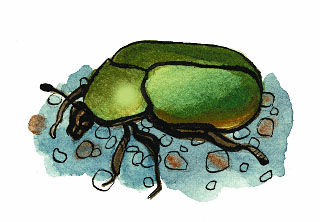 |
We delight in the soft, delicate fruits, such as juicy figs, hence the name: fig beetle (aka Cotinus mutabilis).
A Southwest treasure: Sometimes mistaken for a June beetle, I have a green, jewel-like underside and a funny-looking horn on my head. My body is flat, about an inch long.
We are fruit and sap feeders: You can find us clustered together around trees or feeding on prickly pear fruit.
Unusual behavior: I use my horn like a can opener to cut into the tough skin of desert fruits. You're also likely to see me in my larval stage, crawling around on my back in compost piles.
Critter: Flea
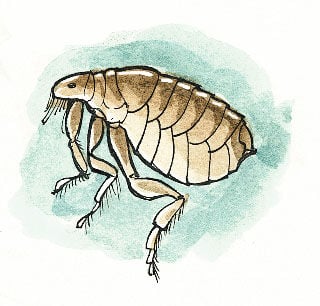 |
I am a flea and I come from a very large family. In fact, you may know some of my family members because they live right in your home. That's right, fleas live on dogs, cats, swine, humans and other animals, depending on our species.
Family resemblance runs strong for fleas. We are small and wingless and have long hind legs that make us excellent jumpers. We all have mouth parts that are designed to pierce the skin and suck the blood out of our hosts.
Some of my wild relatives attack rodents and birds, and are known to transmit microorganisms that are responsible for diseases such as typhus, salmonellosis and tularemia.
Do you want to know something scary? Some of my family members who live in the northern portions of the Southwest carry the deadly plague bacterium Yersinia pestis, which was responsible for the black plague in medieval Europe.
Don't worry too much though. You won't necessarily die from this bacterium anymore.
How would you know if you contracted the plague? Well, you would have a high fever, headache, nausea, weakness and pain. Additionally, you may experience swelling of the lymph nodes. Go to a doctor if you experience these symptoms. The doctor will give you antibiotics.
Critter: Gambel's quail
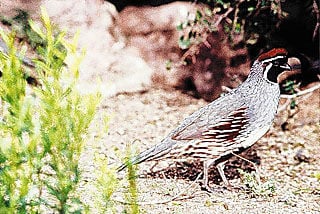 |
I am a Gambel's quail. I am sometimes called a Callipepla gambelii.
I am gray and my most distinct characteristic is my black front curved plume at the top of my head. Our males have black faces and throats that are outlined with white stripes. Their heads are grayish to reddish brown. Males also have rust-colored sides with stripes. Bellies are white with a black spot. The females are very similar to the males but have gray faces and heads. Their plume is not as pronounced as the males'. Our young resemble their moms.
I really like the Southwestern deserts. I can be found from California to Texas. In Arizona I prefer the southern part of the state and the western edge up to Utah.
I usually have eight to 12 eggs once or twice a year. The eggs are white and have brown marks. The females take care of the eggs, and incubation lasts about 21 to 24 days.
Our nests are made by the females with grass and twigs. We find tall shrubs or trees to provide some cover and make the nest on the ground near the base of the cover.
We love to eat what we can find, such as seeds, fruit, insects and even leaves.
Parents usually are with their young, and a group of us is called a covey. We are pretty cute, especially when we walk in a single file.
Our little ones think the best thing about being a quail is that we take dust baths.
Critter: Giant desert hairy scorpion
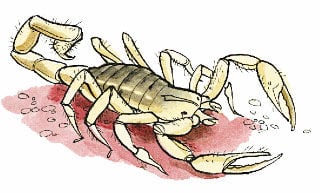 |
Introducing: Giant desert hairy scorpion, or Hadrurus arizonensis.
Why I'll scare you: I am the largest scorpion in the United States, reaching up to 6 inches in length. I am usually a mix of brown, yellow and greenish in color, with brown hairs that stick up all over my body.
A comforting thought: I am the least common scorpion in Arizona, with a sting that is mild.
If you want me, I'll be: Often burrowing as deep as 8 feet in the desert soil, usually close to a water source. I live in southern Utah and Nevada, southeastern California and Arizona, and northern Mexico.
Once you find me: I make myself look even larger by spreading my pincers and curling my body and tail in a threatening pose.
Big scorpion, big appetite: I eat soft-bodied insects, other scorpions and even small lizards.
I wasn't always big: Females give birth to live young that ride on Mom's back for about 20 days before going off on their own to become very big.
Critter: Giant Swallowtail
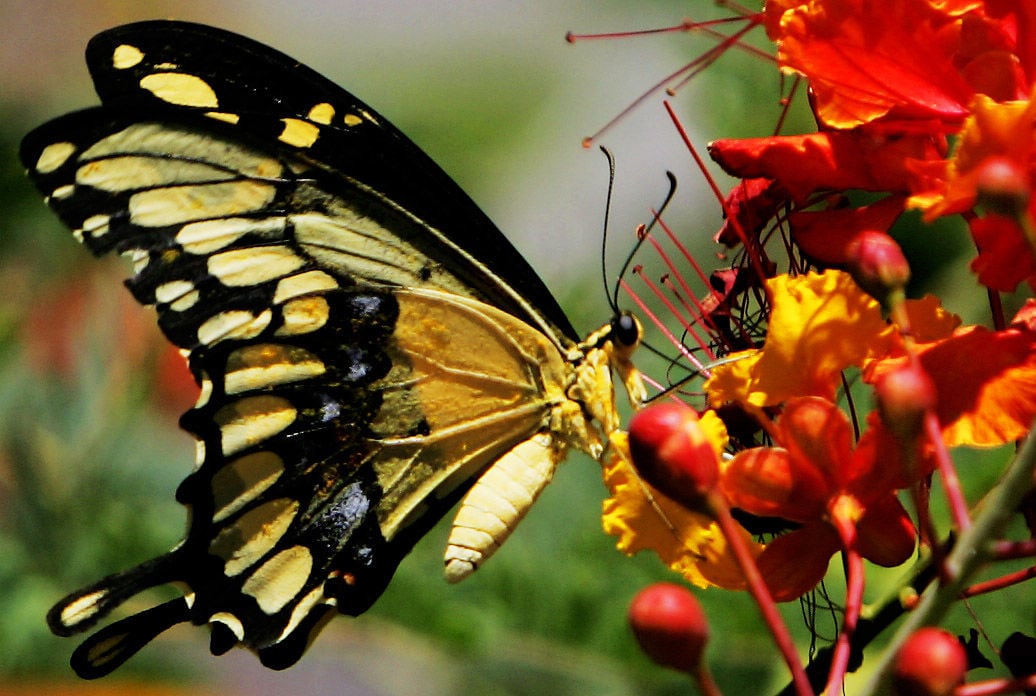 |
Name: Giant Swallowtail or Papilio cresphontes
Looks: It is one of the largest North American butterflies — 3½-5½ inches. The forewing has a diagonal yellow spot band and the hindwing has a broad yellow band at base. Tails are spoon-shaped, filled with yellow.
In early stages: Caterpillar ("orange dog") is brown with white mottled middle and rear saddles, closely resembling a fresh, moving bird dropping.
Food: Various plants in the citrus family. Adults take nectar from lantana flowers, orange blossoms and cultivated city gardens.
Seen: Flight is March-November in Southern Arizona. Range is South America America north to Pennsylvania, southern Texas, Southern Arizona and Southern California as a breeding resident. Strays regularly into eastern Colorado and rarely to North Dakota and Wyoming.
Habitat: Mountains, suburbs and citrus groves — any sunny, open areas with irrigation.
Did ya know? Gov. Jane Hull signed a bill June 11 that made the swallowtail butterfly Arizona's official insect.
Source: Provided by The Arizona-Sonora Desert Museum. References: Peterson Field Guide to Western Butterflies by Paul Opler and Amy Bartlett Wright, and the National National Audubon Society Field Guide to North American Butterflies by Robert Michael Pyle.
Critter: Gila monster
 |
Just call me: Gila monster
Picking me out of a crowd: I average 16 to 18 inches in length and have bumpy, beaded skin that is orange and black with bands on my tail. My tail does not detach and regenerate as with some other lizards.
Preferred hangouts: My kind ranges throughout the Sonoran Desert. I like to live in canyons, foothills and desert areas.
Favorite foods: I am partial to reptile and bird eggs and also will snack on baby rodents and nesting birds. I store fat in my tale for lean times and winter.
Life and death in the desert: I can live 20 to 30 years - I vote for 30! I will reach maturity at about 10 years of age. Females lay three to eight eggs at nesting time. I am endangered by few predators, other than people.
Don't bother me: My bite is worse than my bark because I am venomous. My bite will cause great pain, but, to inject venom, I must hold on with my jaws. Just leave me alone, and we'll get along fine.
Critter: Gila woodpecker
 |
Gila woodpecker, that's my name. A member of the Picidae family, my full name is Melanerpes uropygialis.
You've seen me. I am very common in the area. About 8 to 10 inches long, I have a distinct black and white barred pattern on my back. My underside is buff colored, as well as my head and neck. The guys have a cute little red cap. When we fly, there is a prominent white wing patch.
Local haunts. I can be found in town and out in the desert. The scrub and cactus desert areas are particular favorites, and I especially like those saguaros. I am a year-round resident of the Sonoran Desert, but my range is southeastern California to New Mexico.
Making a home. Being a woodpecker, making holes in things comes naturally to me. Saguaros make really great nesting places; you have no doubt seen the holes I put in them. A really cozy nest is formed by the scar tissue that develops inside the hole. The resulting "saguaro boot" makes a great home and will be used by other birds in subsequent years.
Not the quiet type. My call is a rolling churrr. Some have called me raucous. I prefer to consider myself outgoing. Either way, you will often hear my voice.
Critter: Glossy snake
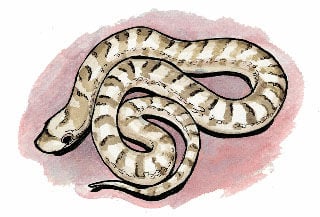 |
My name: Arizona elegans, aka glossy snake.
My colors: I can be light-brown, cream, yellowish or gray in color on top with tan or brown blotches. I'm well-named because my smooth, shiny skin gives me a glossy look. Sometimes I'm called the faded snake because of my bleached or washed-out appearance.
Range: Throughout the American Southwest.
Home: I'm comfortable in a variety of landscapes, ranging from barren deserts to grasslands and woodlands.
Digs: I'm a capable burrower, spending my days underground and venturing outside at night to search for food.
Appetite: Lizards, other snakes and small mammals are some of my favorite foods.
Critter: Golden eagle
 |
I am an Aquila chrysaetos, but you can call me a golden eagle.
I am a rather large bird, with my body measuring between 30 and 41 inches. My wingspan is an impressive 78 inches. I am dark brown. I am called a golden eagle because the back of my neck is a pale-golden color. My bill is smaller and darker than that of my kin the bald eagle.
I prefer to live in mountain forests or open grasslands, but I am less discriminating during my migration. I can be found from Alaska to northern Canada and south to Mexico. Don't tell the bald eagle, because he is the national bird, but I even like Eurasia.
I make my nest in a rocky ledge or high up in a tall tree. I usually have between one and four eggs, which are whitish and may have dark brown speckles.
I feast on jackrabbits and large rodents. I can be a snob being golden and everything, but I will confide in you that I have even eaten roadkill. It is rather tasty, and I don't have to exert as much to dine.
Critter: Grasshopper sparrow
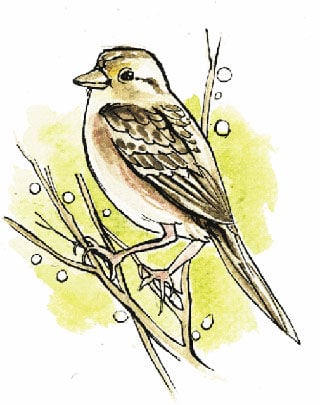 |
My name is: grasshopper sparrow, or Ammodramus savannarum.
I'm little, but darn cute: I grow up to be 4 1/2 to 5 inches with a short, pointed tail. My breast is clear buff, and I have a dark, rufous underside. I have a pale stripe on the center of my crown, and I have a conical-shaped bill to help me crush seeds.
Look me up if you're in town: I breed over much of the United States, Mexico and a small piece of Canada. In the winter, the farthest north I like to go is from the most southern part of California to southern Texas to North Carolina. I like open, grassy areas.
Where I hang my hat: My nest is a cup of grass on the ground. It is lined with rootlets and hair and often has a dome. I lay four or five white eggs with reddish-brown speckles.
I'm a chart-topper: I'll bet you can't guess what insect I sound like. I make a high-pitched kip-kip-kip, zeeee.
Let's do lunch: I am partial to seeds, but have also been known to eat insects.
Staying out of the limelight: I'm a bit secretive. If you flush me out, I'll fly a little way and drop back into the tall grass to stay out of sight.
Critter: Gray fox
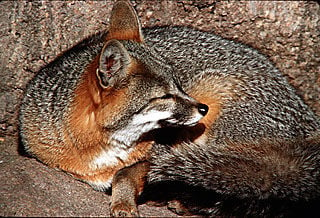 |
Name: Gray fox, aka Urocyon cinereoargenteus
Description: This critter is about 40 inches long, weighing between 10 and 18 pounds. Its coat is gray, with a lighter shade of gray on its belly. Throat and sides are orange or reddish. Its tail is about 18 inches long, bushy with a black strip and a black tip.
Eats: Rodents, young birds, eggs, reptiles, berries and cactus fruits.
Offspring: Pups have dark brown fur, are born immature and require care for some time. Mating season is February and March. The young are born after 51 days with a litter of three to seven pups.
Usual haunts: Canyons and evergreen forests. May live at edge of town, as long as there is sufficient brush for concealment. Dens are usually made in rocky overhangs, cliffs or thick brush.
Cool stuff: This critter is the only fox that climbs well and occasionally will climb trees.
Critter: Gray garden slug
 |
OK, call me a slug, a gray garden slug actually, Agriolimax reticulatus to be exact. But don't call me a sluggard!
Home is where you make it. Unlike snails, which are very similar to us in biology and form, we prefer not to be encumbered carrying a house around on our backs. We hang our little slug hat wherever we please, without the bother of a mortgage and upkeep. Of course, that does make us more vulnerable to predators. But it also allows us to live where there is not much calcium in the soil, a requirement for shell construction.
We aren't lazy; we are nocturnal! We are quite active at night, munching on your young, tender seedlings and plants. The evidence of our activity is seen as damage on leaves, flowers and fruit - and on the sidewalk as a slimy trail.
If you spot us, we are about 1 to 2 inches long, and, as you might expect, gray. We like it where it is cool and moist, so even in the hot desert, gardens usually fit us to a T.
So you don't want to share your bounty. If you must get rid of us, the best way to control us is to keep your garden area clean, offering no hiding places, and not overwatered. You can also put up a barrier of copper screen, anchored in the soil. They even have pesticides called molluscicides, which are too scary to contemplate!
Critter: Great blue heron
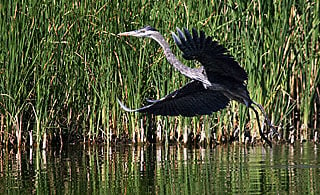 |
Name: Great blue heron
Description: This large bird, which can be as tall as 48 inches, is blue-gray. Its belly and head are white with black markings.
Usual haunts: Wetlands. Prefers areas that provide some security, such as where there are tall trees, ledges or places with many reeds.
Young herons tend to spread out during late summer and can be seen at small ponds, mountain waters and even in backyard pools. They hang out wherever there are plenty of fish. This critter can be found in many areas in North America. They migrate from areas where the water freezes.
Offspring: This critter has bluish-green eggs. Three to seven eggs are usually laid in a stick nest.
Fascinating facts: The bird is sometimes mistaken for a crane, but herons have longer bills than cranes. Also, herons can be found standing in water or on a bank of water, while cranes prefer to stand in marshes or dry fields. A heron flies with its neck folded back on its shoulder. They also travel up to 15 miles for food.
Critter: Great blue or purple hairstreak
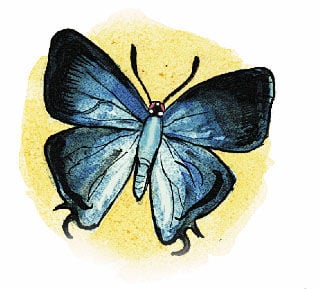 |
Call me: Great blue or purple hairstreak, aka Atlides halesus estesi
What a looker: I know this sounds like I am being vain, but I am a very beautiful butterfly. The back side of my wings is a dazzling iridescent blue, while the underside of my wings is charcoal gray.
Where I hang: In the spring and late summer, I can be found in the low and middle elevations of canyons. I get around. I have been spied in a large area bordered by the Baboquivari, Peloncillo, Black and Santa Teresa mountains. I can be found at a variety of flowers. You can find me in trees in the afternoon, looking for a little love.
When I get the munchies as a larva: I eat mistletoe.
More cool stuff about me: I can usually be found in a small group. My flight has been described as slow and erratic. What do people know?
Critter: Great egret
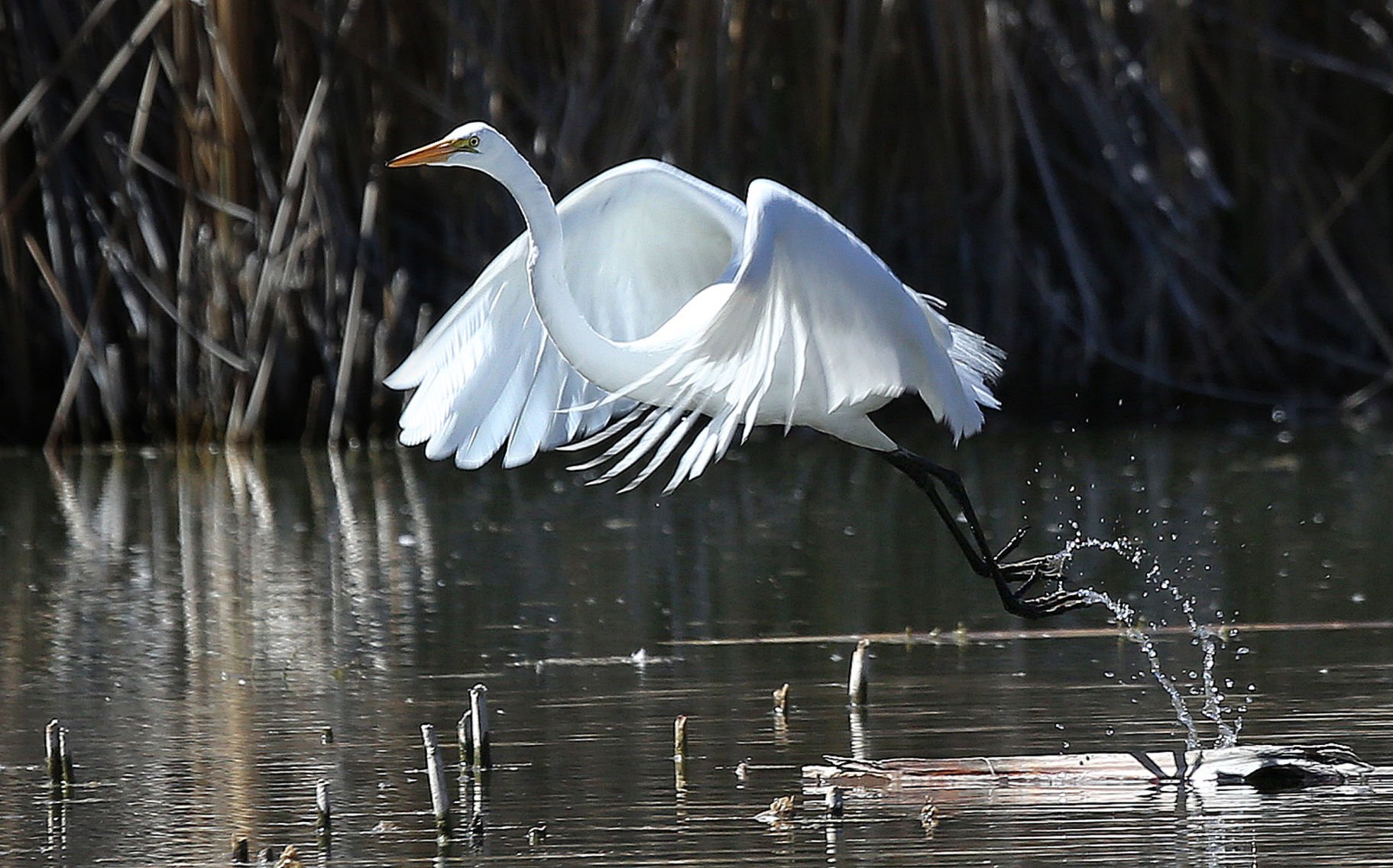 |
Name: Great egret
Description: This bird is about 35 to 41 inches long and has a wingspan of 4 feet, 7 inches. This is a large, white heron. It has black legs and a yellow bill.
Usual haunts: This critter frequents marshes, both fresh and salt water. It also likes marshy ponds and tidal flats.
Housing: Nests are found in colonies. It is not uncommon to see them with other species of herons. These nests are made of sticks and can be found in trees or bushes.
Offspring: Usually three to five blue-green eggs.
Interesting fact: Hunting had greatly reduced the bird's numbers. The National National Audubon Society opposed the trade of the bird's plumes. The egret has since become the Audubon Society's Society's emblem.
Source: National National Audubon Society's "Field Guide to North American Birds."
Critter: Great horned owl
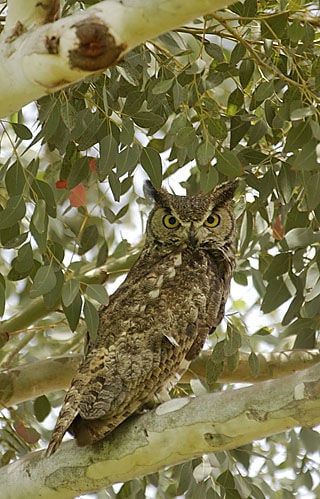 |
Who-hooo am I? I am a great horned owl, aka Tecolote cornudo, Buho or Bubo virginianus.
Where you will find me: I live almost everywhere in the New World. Here, I am in every habitat.
My appetite: I eat almost any critter that is not bigger than I am, such as skunks, rodents, waterfowl, snakes and insects. I am a very natural and successful form of animal control, especially in regard to jackrabbits and cottontails.
Special skills: I have really good hearing and night vision, and my soft feathers make almost no noise. These adaptations allow me to locate my dinner and snatch it before it hears a sound.
I am a big bird: At about 2 feet tall, I am the largest owl in this region. I have a white throat and barred underside. My prominent ear tufts gave me my name.
Leave my family alone: I nest in January or February with two or three white eggs. I will not tolerate anyone messing with my nesting territory, including humans - so back off!
Word for the day: I am a zygodactyl. I have two toes pointing forward and two back, perfectly designed for grabbing dinner on the fly.
Critter: Greater bonneted bat
 |
I am a greater bonneted bat, also known as a western mastiff bat. Formally, I would be Eumops perotis.
Hats off to me. Prince Charles has nothing on me. My ears protrude forward about 1 1/2 inches. They give a bonnetlike appearance to my head, hence my name. I also have a small tail, just a bit over half an inch in length.
I'm No. 1! The largest bat in the United States, my wingspan is almost 2 feet! I am 5 to 7 inches long. My fur is generally dark gray or brownish-gray; the hair is nearly white at the base.
Water, I need water! Because of my wingspan, I find it difficult to take off from land, preferring instead to perch high up and drop into flight. But this means I can't land to get a drink. When I get thirsty, I need a pond at least 100 feet long to skim across. These are becoming harder and harder to find. Consequently, we are no longer found in lots of places that we used to be and are thought to be declining in numbers.
A mystery. We have been found throughout the Southwest, but very little is known about us, as we roost on cliff faces and forage high up in the air.
Critter: Greater earless lizard
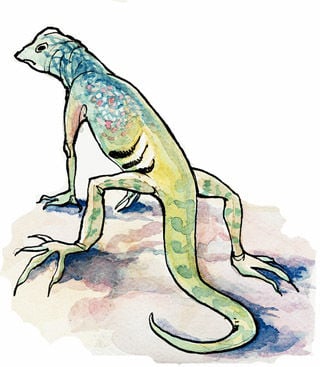 |
What's in a name: I'm called greater earless lizard, aka Cophosaurus texanus, because I have no external ears.
What to look for: I'm the color of the ground, usually brown or gray. I have the slender legs of a marathon runner and a long, flat tail.
Native Tucsonan: Look for me where cacti, mesquites, ocotillos and palo verdes grow.
Hanging out: I prefer the open space of a wash, riverbed or rocky hillside where I'm free to run without obstacles. Sometimes you might see me running with my tail curled over my body. Since I don't have ears to slow me down, I can burrow into sandy surfaces for a fast getaway.
What's for lunch? My favorite foods are grasshoppers, caterpillars, bees, wasps and spiders.
Critter: Gulf Fritillary
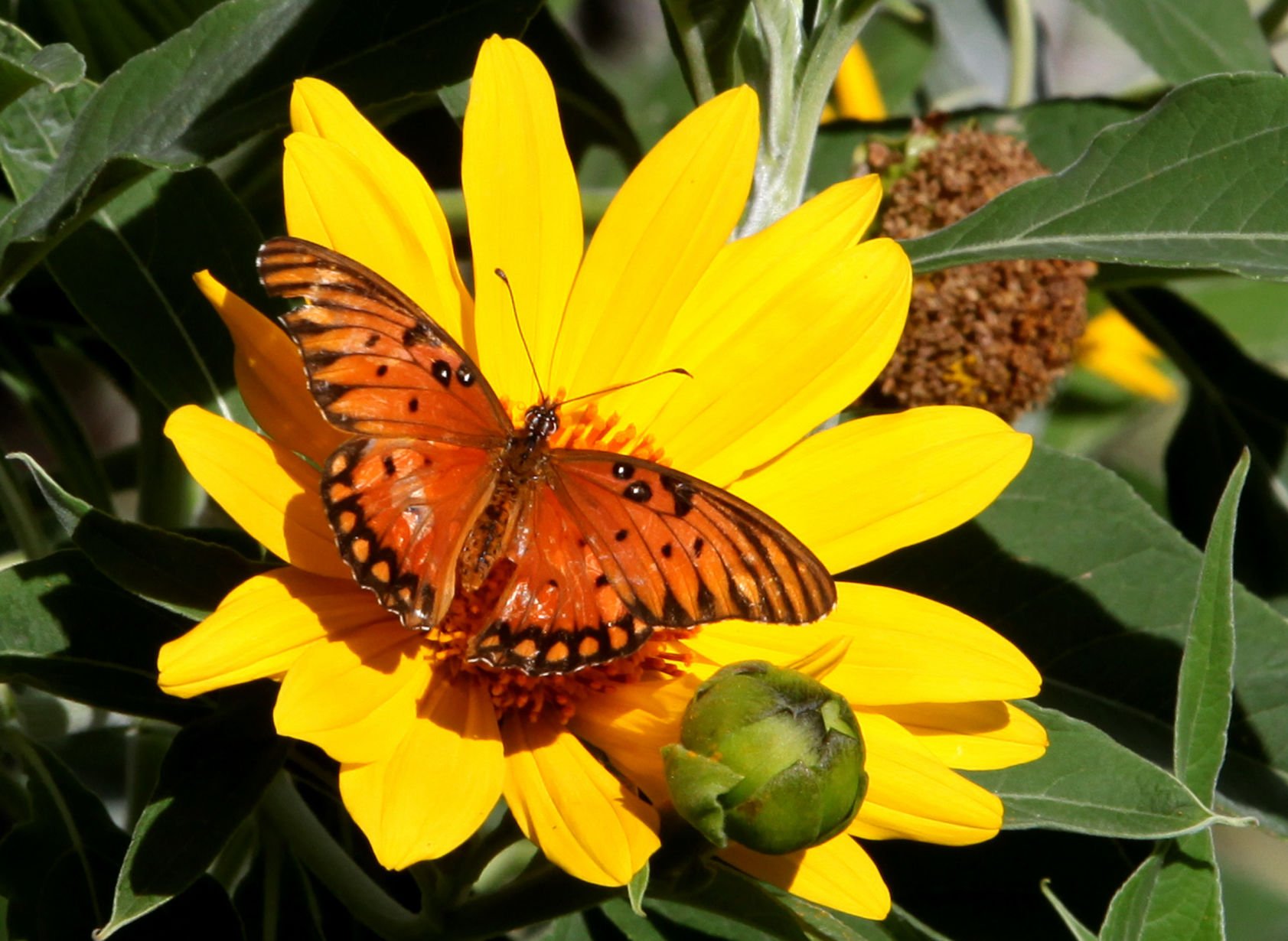 |
Name: Gulf Fritillary, aka Agraulis vanillae
Subfamily: Heliconnnae
My good looks: I'm a beautiful bright orange butterfly. My wings are marked with black lines and three white spots encircled in black.
City life: I can be found gliding through yards in search of a host plant, the passion flower vine.
My home: I live in many parts of the United States and Mexico. I'm common throughout Arizona except the northeast corner.
Flight: Adults fly April through October.
Life history: We increase our chances for survival by tasting bad (a common trait to all passion vine butterflies) and by being prolific egg layers.
Source: "Butterflies of Arizona: A Photographic Guide" by Bob Stewart, Priscilla Brodkin and Hank Brodkin.
Critter: Harris' antelope ground squirrel
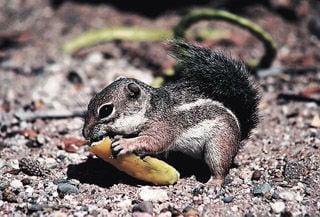 |
Hi, my name is Harris: Well, Harris' antelope ground squirrel, to be precise - and for you really precise types, Ammospermophilus harrisii.
I am a cute little fellow: You will agree if you spot me. I am about 9 inches long. I have a white "racing'' stripe on both sides of my pale-gray body. My tail is 3 inches long. It is grayish on top and a black-and-white mix underneath.
Life in the desert: I like the desert and can handle the daytime heat quite well. I especially like the low desert with little vegetation, but other desert habitats also suit me. You can find me in Western and Southern Arizona over to extreme Southwest New Mexico.
What a mouthful! Being an omnivore, I feed on a variety of seeds, fruits, insects and whatever. I carry my food back to the burrow in my cheek pouches. One of my relatives was known to stash 44 mesquite beans in his mouth at once. I metabolize the water I need from my food.
Outta here! When I am frightened I dash off with my tail in the air, chattering as I run. Before disappearing under the brush, I may stop, call out and stomp my feet. So there!
Critter: Harvester ant
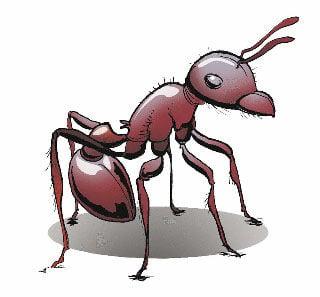 |
My scientific name is Pogonomyrmex spp., but mostly I'm called a harvester ant.
My main food source is seeds that I harvest and store, hence the name.
I am a common ant in the arid Southwest. I am about three-eighths of an inch long, and my color can vary from all black to reddish-brown and sometimes a mix.
When I move into an area with my friends, we build an extensive nest that can sometimes reach up to 10 feet deep. The mound on the surface is usually surrounded by an area cleared of all plants, which we do ourselves.
We like to keep the nest warm because it's where the queen and larvae live. Sometimes we use small pebbles around the nest to attract and hold heat. Clearing the plants ensures that nothing shades our home. We will defend our home aggressively.
My sting is one of the more painful ant bites, with the stingers released into the skin, creating a large welt. People with allergies could go into shock if bitten.
Critter: Harris' hawk
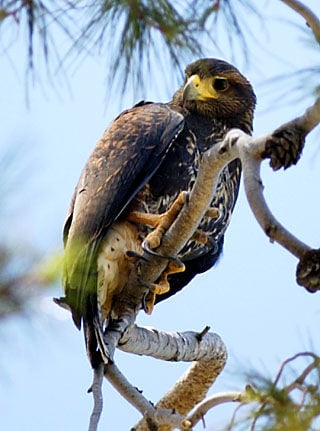 |
One handsome bird: They call me Harris' hawk or Parabuteo unicinctus, but my name just doesn't do me justice. I'm a beautiful chocolate-brown color with a dark, broad tail with white trim.
Hanging out: I'm considered a "sit-and-wait" predator, and you usually can find me sitting on telephone poles, on fence posts or atop a saguaro.
Birds of a feather: It's true ? we do flock together. My family is quite the social group, and you often can find us in groups of three to six, sometimes even more. We like to stick together so we can hunt as a team. We also spend time together during the nesting period and help each other with raising the baby birds.
Preying for lunch: My favorite foods are rodents, cottontails, reptiles and ground birds.
Raspy voice: My voice can be described as a short, dry scream. I promise it's not quite as bad as fingernails on a chalkboard.
Spending time with the saguaros: You can find me in parts of New Mexico, Texas and California, or closer to home in Southern Arizona.
Critter: Head louse
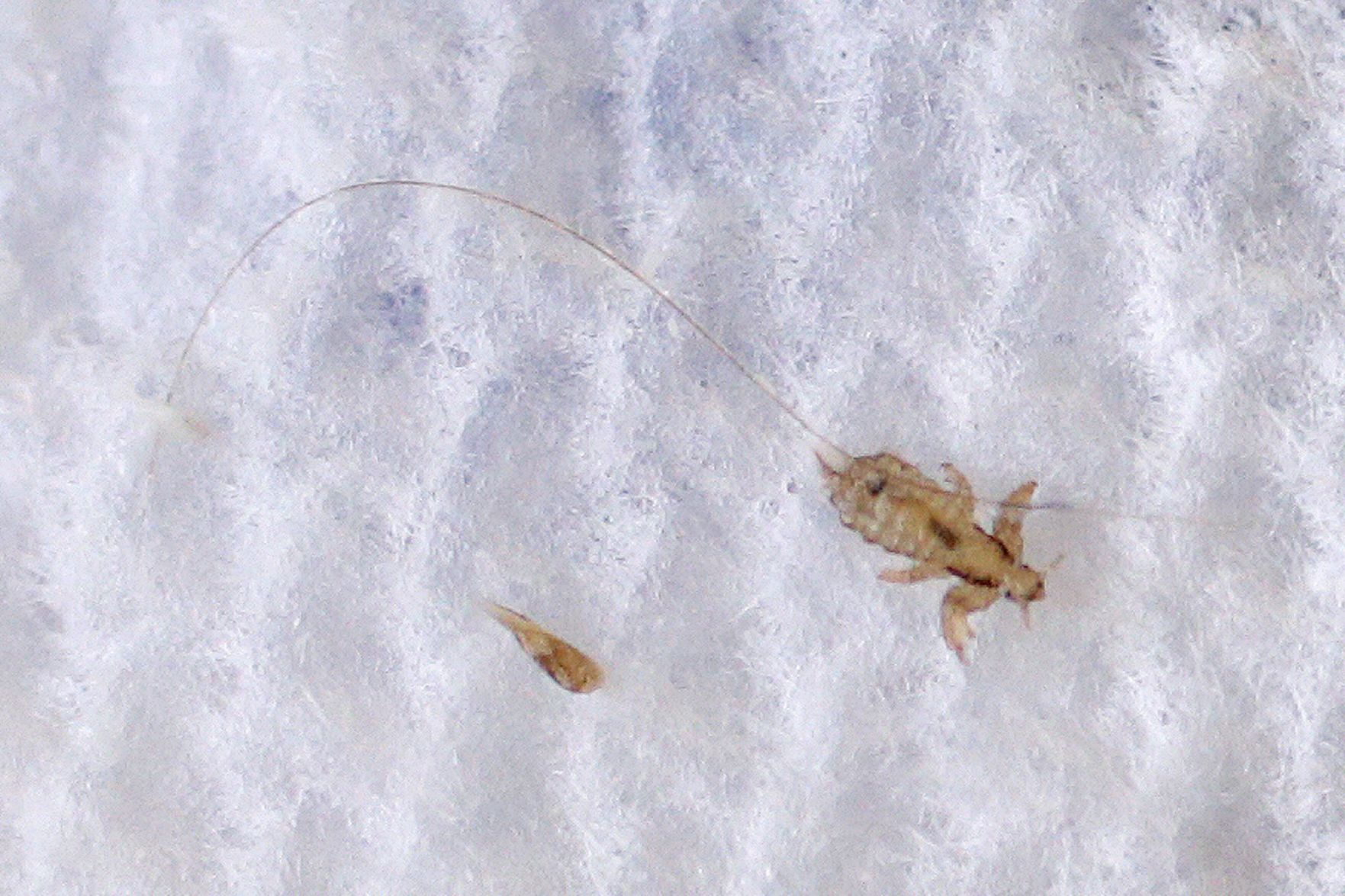 |
Name: I am known as a head louse (lice), or formally (and euphemistically) as Pediculus humanus capitis.
Description: I am probably one of those insects you prefer not to think about. I don't really weigh much and am hard to see. In fart, you may not even notice I'm there at all until my buddies and I start making lunch out of your head! If you were to look at me, you would see that I am between 2 mm and 3 mm in length. Male lice have a rounded abdomen, while that of the female terminates in two lobes. My mouth has recurved "teeth," which are pressed to your skin to anchor my head in position while my piercing, sucking mouthparts eat you. Pleasant huh?
Offspring: Let's just say I'm not an only child. The female louse lives for a month or more, laying between 50 and 100 eggs that hatch in five to 10 days.
Lice In Arizona: Unfortunately for me (and luckily for you), lice infestations are not too common in Arizona and generally occur among schoolchildren.
Symptoms and treatment: Usually, I cause skin irritation that may lead to swelling. If you think I am living in your hair, you should see a physician who can prescribe an ointment, lotion or shampoo that may help to kill me. Bathing, shampooing and changing clothes regularly can also help. Wait a minute! Why am I telling you this?
Source: "Venomous Animals of Arizona."
Critter: Hoary bat
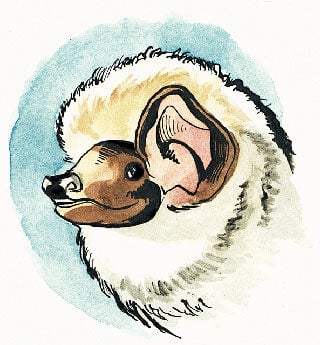 |
You can call me Hoary. I am a hoary bat, or Lasiurus cinereus.
Hey, good lookin'. I have been called one of America's most handsome bats. My name comes from my white-tipped fur, which gives me a hoary or frosted appearance.
We are everywhere. While one might dispute that I am attractive, I'm definitely one of the largest and most widespread of the American bats.I am 4 to 5 inches long. Hoary bats are found throughout Canada and all the way into South America.
But you won't see us. Don't be offended, but we are not attracted to anything human. In fact, we live deep in the foliage about 15 feet up in trees, well hidden on the forest edge. We will emerge at night to feed on moths and other flying insects.
Here mothy, mothy. On our first foraging trip of the evening, we sometimes go as far as 24 miles round trip, with several shorter trips throughout the night.
Going my way? In late summer and early fall, we head south, possibly as far as the tropics. For the trip, we travel in groups, often in the company of birds that are also migrating to warmer climes.
Would you believe? The hoary bat is Hawaii's only native land mammal. Some lone individuals have even been found in Iceland, Bermuda and Scotland's Orkney Islands.
Critter: Horned lark
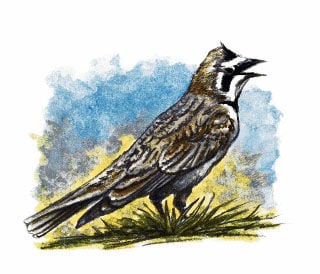 |
Name: Horned lark.
What a looker: I'm a big guy, measuring between 7 and 8 inches. OK, maybe that's not too big. I'm brown with a black stripe below and a white or yellow stripe above the eye. Check out the black crescent mark on my chest. I get my name from the black feathers on my head - they look like horns. In the air, my tail feathers are black trimmed with white.
Where I hang: I can be found at airports, fields, plains and beaches. I breed in the American Southwest and in Alaska, but have connections with breeding in the arctic and coastal areas of Canada. I winter in the American Southwest and on up to the southern part of Canada.
When I get the munchies: I like seeds. But I'll also eat insects that can be found on the ground.
Walk this way: When I'm not flying, I like to walk and run. You won't find me hopping around like those other birds.
There's no place like home: After migration, I return to my birthplace. Many distinct subspecies have been discovered in the West, because I have been able to adapt to the colors of my habitat.
Critter: Horse
 |
My name: Secretariat, Flicka, Black Beauty, Mr. Ed. I'm a horse, of course.
My size: There are three categories of horses: ponies, light horses and heavy horses. Ponies are from 10 to 14.2 hands in height. One "hand" is 4 inches, about the width of a man's hand, and a horse's height is measured from the top of the withers to the ground.
Light horses and heavy horses are more than 14.2 hands and are differentiated by build and proportion. Light horses' size and build make them suitable for riding. You'll see plenty of light horses in the Rodeo Parade.
Heavy horses have shorter legs and backs and also broad, powerful chests. They often have feathering, or fine hair, around their lower legs. The Clydesdale is an example of a heavy horse. Modern breeds of heavy horses are believed to be descendants of war horses that carried heavily armored knights.
My color: Domestic horses are descended from dun-colored, wild horses. The color is yellowish-red or light red-brown, and the horses had a dark or black mane and tail. Horses now come in a range of colors from white to brown and black, and many are more than one color.
My babies: Gestation for a horse is 11 months, and multiple births are rare. Within an hour of birth, the foal is able to stand and suckle. It reaches adult size between 4 and 5 years of age.
Critter: House finch
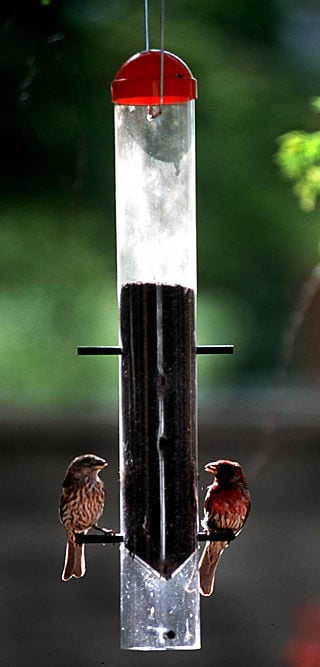 |
My name is: Carpodacus mexicanus, but my friends just call me a house finch.
I'm a snappy dresser: I am about 5 1/2 inches long and brown with a bright-red breast and forehead and more red on my rump. The ladies are more conservatively dressed, mostly in gray and brown.
My stomping ground: We are found in much of the United States and Mexico, though not in the central states. We like towns, woods, canyons, coastal scrub and desert.
Where I hang my hat: We make small nests of twigs and grasses in bushes, cacti, buildings and even hanging planters.
I'm a singing sensation: I have a musical warble that ends in a nasal "che-urr."
I'm hungry: I eat a variety of seeds. If you're planning to invite me to lunch (which would be most convenient if I'm nesting in your planter), my favorites are sunflower and thistle.
I'm feeling parental: Up to three times a year, moms lay from two to six eggs that are blue-white to blue-green with speckles. They hatch in about two weeks.
Make me feel at home: Since I'm already hanging out in your planter and eating your seeds, could you set up a birdbath nearby? You know you want me to stay.
Critter: Indigo bunting
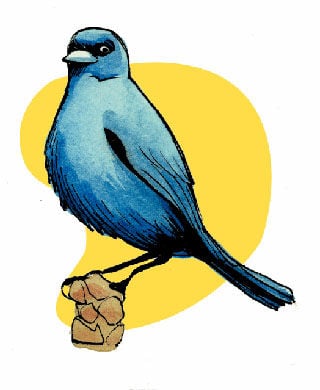 |
My name is: Passerina cyanea, but you can call me an indigo bunting.
What you see: I'm quite a looker. Usually only the males are seen. That's because during breeding season we are a beautiful bright-blue with a few dark markings on the wings and tail. Females are light-brown with faint markings and look a lot like a finch. In the fall, males molt and look more like females for the winter.
My travels: I can be found anywhere in Arizona in the summer. When it gets cooler, we migrate in small flocks at night to Mexico and farther south.
What's on the menu? Insects, seeds and fruit are my favorites.
Family: As if the bright-blue look wasn't enough, the males sing from the treetops to attract mates. Mom lays three or four pale-blue eggs in a cuplike nest she has built. She incubates them herself for 12 to 13 days and feeds the newcomers after they hatch. Mom usually has two broods a year.
Here's a surprising fact: The lovely blue color comes from sunlight refracted from within my feathers. There is no pigment in them. I'm really black. Keep that a secret, please. I don't want to disappoint my adoring public.
Critter: Jaguar
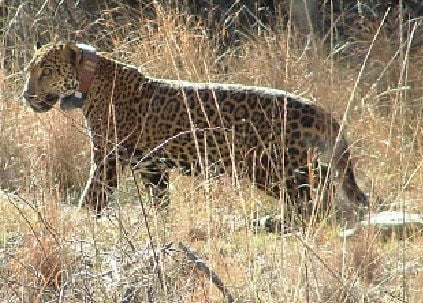 |
Size: Adult jaguars typically weigh between 125 and 210 pounds and can grow to more than 6 feet long.
Range: Jaguars defend territories and may roam more than 500 miles.
Relatives: The third-largest cat in the world, the jaguar is related to the lions, tigers and leopards of Africa.
Diet: Jaguars eat more than 85 species, including armadillos, turtles, fish and livestock. In Arizona, their diet mainly consists of deer and javelina.
Status: Listed as endangered in 1997. Their historic range once covered nearly all of Latin America, but it has been cut in half due to deforestation, hunting and a loss of prey.
Sources: Wildlife Conservation Society, Arizona Game and Fish Department, National Geographic, Arizona-Sonora Desert Museum
Critter: Japanese beetle
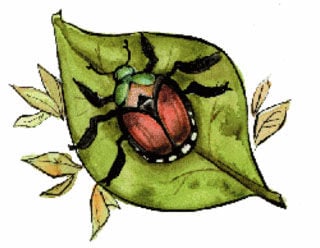 |
Name: Popillia japonica, but if you're worthy enough, you can call me a Japanese beetle.
Appearance: As you can see, I'm extremely attractive. I grow to a little less than half an inch in length and have a shiny green body with metallic-bronze-colored wings. I have small tufts of white hair along the sides and back of my body, and under the edge of my wings. Some would say I'm a striking blonde. I would agree with them.
Origin: My native country is Japan, as you can tell from my name, but I've traveled across the Eastern United States, all the way to the desert Southwest. My great-grandparents showed up in a nursery in New Jersey nearly 80 years ago, and found that, unlike in Japan, they had no enemies here. So their population grew and infested many states. Ohio had to be quarantined in the '60s because of my kin. Awesome! Although people have tried to stop my migration, I've continued to find my way around the United States.
Personality: Just like my ancestors, I'm a menace to society. Scientists say I'm a serious threat to American agriculture. It's not my fault that humans' fruit trees, roses and blossoms are so dang tasty. A beetle has to eat, right?
Critter: Javelina
 |
I am a peccary, but I prefer to be called a javelina. That's HAHV-eh-LEE-nah.
I have features similar to a pig, but I am much more beautiful. My hair is coarse gray and black. Please, I know how lucky I am. I have a very regal, long nose. I have a petite tail and ears. I am about 2 feet tall and 3 feet long. I can weigh up to 50 pounds.
I would classify myself as very social. I can be found with one good friend or in a large circle of up to 50. The best part about being me is that when it gets cold at night my friends and I snuggle together to stay warm.
I can be found from central Arizona and central Texas down into South America.
I dine on cactus fruits, mesquite pods and acorns.
When you are as beautiful as I am, there are trade-offs. Mine is that I don't see very well, but I do have an amazing sense of smell.
Please be careful if you see me. I know that people love to take pictures of me, but I bite.
Critter: Killdeer
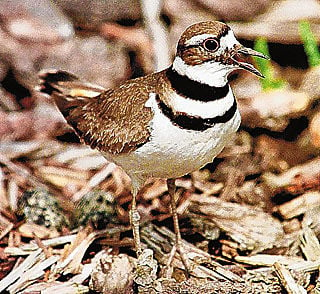 |
I am a Charadrius vociferus. But I'm best known by my other name, killdeer. No need to be alarmed; I don't actually hurt deer. My name comes from my call, which sounds like "kill-jer."
My body measures about 11 inches in length, and I weigh around 3 ounces. I have a 24-inch wingspan. I'm tall and thin, and I have a long tail. I'm brown with a white tummy and throat, and I have two black bands around my neck. When I'm flying, you might be able to see my reddish-orange rear on the top part of my tail. Young killdeer look similar to adults, but they have only one band around the neck.
I'm considered a shorebird, but I don't have to live near the shore. I can be found in Arizona, states along the West Coast and other Southern states year-round. I spend summers in the northern United States or in parts of Canada. Migration can even take me up to Alaska.
I eat insects.
I can be found in vacant fields, near railroad tracks and in parking lots.
Males build our nests, which usually are on the ground.
We usually lay three to five eggs. Both sexes incubate the eggs for about 24 to 28 days. Soon after they're born, the babies are led to insects by their parents.
Critter: Kissing bug
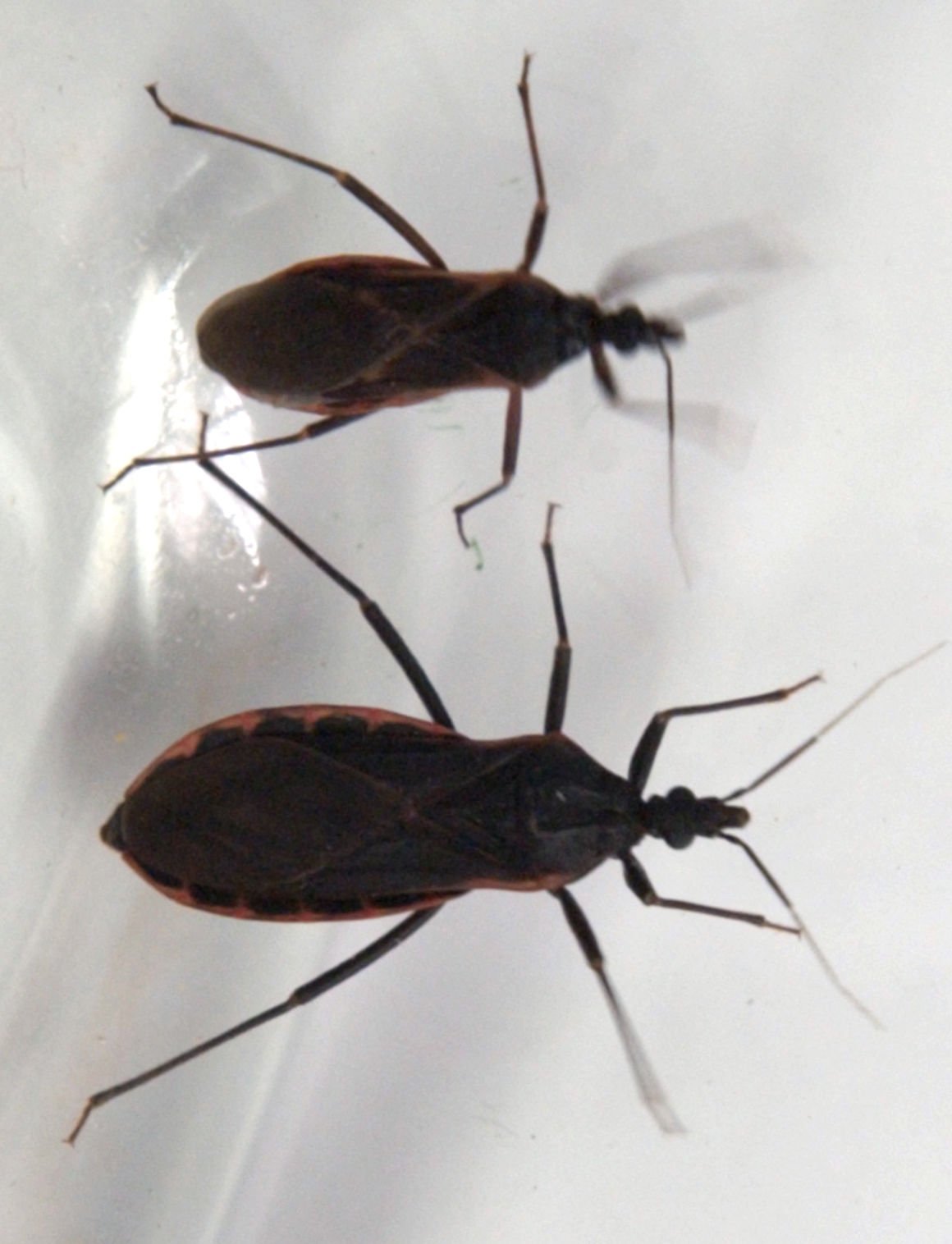 |
Name: Kissing bug, a k a Triatoma rubida
Description: Brown to black with red to orange markings on margins, about a half-inch to 1 inch long with elongated head.
Usual haunts: They are parasites that often live in rodent nests and feed on the blood of reptiles and mammals. They stay out of the sun and enter homes through cracks and under doors.
Most active: May and June.
Bite: Usually causes local swelling, intense itching, but all levels of reaction are possible, including life-threatening anaphylaxis.
First aid: Wash bite with soap and water and apply antiseptic. For severe reactions, consult a physician.
Source: Sonoran Arthropod Studies Institute
Critter: Ladybug
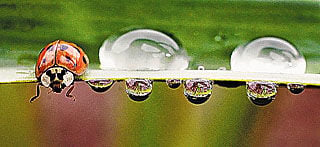 |
I go by many names. I'm a lady beetle, a ladybird beetle or a ladybug. But whatever you call me, I'm quite recognizable, and I'm almost everyone's favorite insect! I'm that cute little bug with an orange shell and black spots.
There are lots of us: There are more than 480 species of lady beetles. The ones most familiar to folks in North America are from the genus Hippodamia, and 18 different species live north of Mexico. The convergent lady beetle (Hippodamia convergens) is abundant throughout the United States.
We are the good bugs! Eating aphids, scales and mites on plants is our forte. We're so beneficial that you can find us for sale in garden centers. But hey, there's no guarantee we will stay where we're released. So if you decide to release us in your yard, we might end up being more beneficial to your neighbor.
Up and down we go: We like to migrate vertically, spending our larva days in the desert living off the plentiful aphids. Then after we mature, we spread our little wings and head for the mountains. You often can see thousands of us congregating in the Santa Catalina and Santa Rita mountains. In the spring, we head back to town, mate and lay eggs in good aphid hunting areas.
Did you know? Ladybugs are the official state insect in Delaware, Massachusetts, New Hampshire, New York, Ohio and Tennessee.
Critter: Leafcutter ant
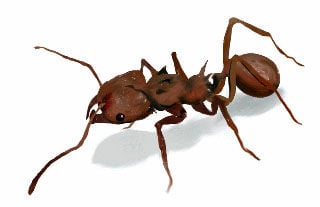 |
My name: I am a leafcutter ant or Acromyrmex versicolor.
My looks: I'm about 13 millimeters long, with a reddish brown body. That's about a half of an inch. I have spines on my body and a triangular head.
My home: I (and other worker ants) dig deep under the caliche layer of soil to make a home underground for the queen. You can usually spot a colony by the cinder cones of dirt that are from the soil we have excavated.
My job: Once the home is built, I go out and find pieces of leaves to bring back to the colony. You can often spot us by the long line we form.
My diet: I "chew" up the collected leaves and feed the particles to a special fungus that is grown inside the colony. Then I eat the fungus. Yummy.
You might run into me: At night during hotter temperatures or during the day when it rains.
Interesting fact: If the leaves collected aren't dry enough to "chew" they often get brought back up to the surface and laid by the colony entrance to dry.
Critter: Leprechaun
 |
Let's play a game. Can you guess what I am?
I am probably classified as a fairy. You would recognize me if you saw me; I am a wee old man. I often wear a hat and have been spotted sporting an apron. Some people think I work on shoes. Can you hear me hammering away?
I live alone and prefer to be far away from people.
My favorite day of the whole year is March 17, which is St. Patrick's Day.
Everyone wants to find me because I have a hidden treasure. If you find me, I may promise you my treasure so that you won't hurt me. I always want to be free. You can't keep your eyes on me all the time. I am pretty fast, so you must be diligent and not look away if you want my treasure.
Some people think I am mean; others think I am nice. I guess it just depends on the day I am having.
I have even been the subject of several movies. Pretty impressive, isn't it?
What am I?
I am a leprechaun.
Critter: Lesser goldfinch
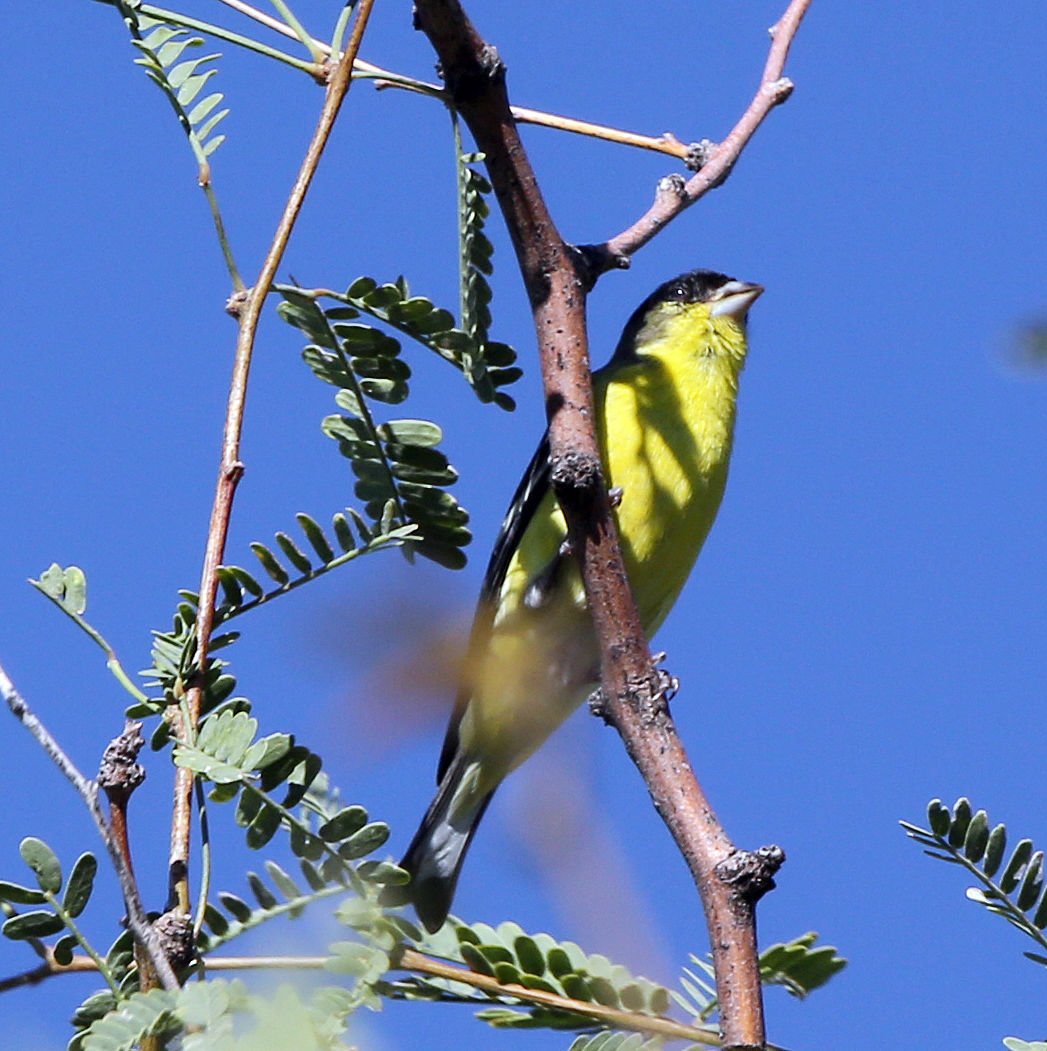 |
My name: Lesser goldfinch, aka Carduelis Psaltria
My appearance: Males have black caps, green or black upper parts and white sections on the wings. Females have green upper parts with black wings and tales. Both sexes have bright-yellow underparts and white sections on the wings.
My home: You can find me in living gardens, parks, the edges of wooded areas, the eaves of your house or anywhere that I am partly sheltered. In arid areas, I am usually found close to a water source.
My menu: I eat mostly seeds and vegetable matter, sometimes dining on an insect or two. I hunt for food in small flocks, except during nesting season.
My family: Females lay three to six bluish-white eggs that take 12 days to incubate in my nest. I can have multiple nesting cycles in a year.
My voice: I sing in a rapid series series of repeated sounds.
My personality: I am an active bird that you can often find in your birdbath. If you want to attract me to your birdfeeder, fill it up with some sunflower and thistle seeds.
Source: "Stokes Beginner's Guide to Birds, Western Region, " by Donald and Lillian Stokes, and the Arizona-Sonora Desert Museum Web site.
Critter: Lesser Nighthawk
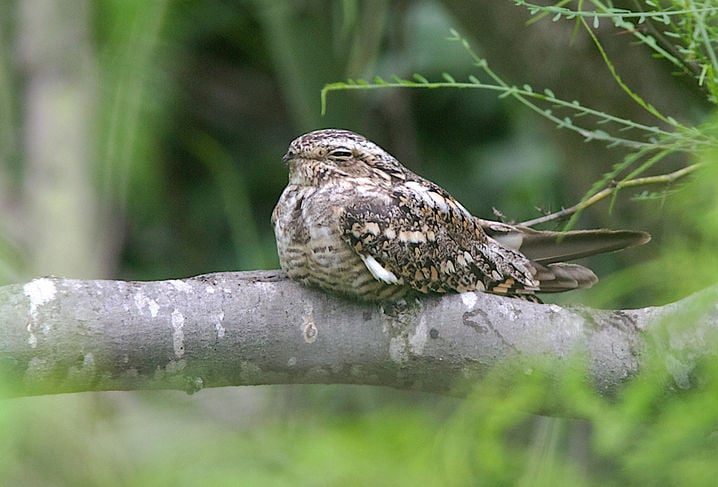 |
My name is Lesser Nighthawk. I patrol the night sky.
My area of operation is from central California, Arizona and parts of Nevada, Utah, New Mexico and Texas southward. I like to winter farther south in the tropics. You will find me in open, dry scrub and desert valleys.
My uniform is a marvel of camouflage. It is gray and white on the upper parts, with buff patterned under parts. The males have a white throat and a white wing patch; in the females, these are buff. We are about 8 to 9 inches long, with a 21-inch wingspan.
My mission is to fly low just above the treetops or above the brush and grass. I do this in the evening or just before daybreak, when my targets are the most active. I devour my insect prey inflight.
My voice is a soft vibrato whirring sound that is very difficult to locate, but it adds a mysterious sound to the night skies.
My legend is based on my group of fellow birds known as goatsuckers. Since we have wide, soft mouths and because we fly near grazing herds at night, the old fable is that we milk goats. I ask you to use common sense on that one.
Source: National Audubon Society Field Guide to North American Birds and The World Book Encyclopedia.
Critter: Loggerhead shrike
 |
Hello, my name is: loggerhead shrike, or Lanius ludovicianus.
Just another pretty face: I am 8 to10 inches long, gray on top and with a white underside. I have a wide, black face mask and a hooked bill. I have black wings with a small white patch and white patches on the rump and back.
My stomping grounds: I am migratory and spend my winters in the southern United States.
The neighborhood: I like roadside vegetation, savanna, desert and open country where I can find a high perch.
My home: I build a cuplike twig nest near the trunk of a tree or bush and line it well. In that nest, moms lay from four to eight yellow-white speckled eggs.
Let's do lunch: I am partial to large insects such as locusts. Smaller birds and mice are also good when bugs are in short supply. When those bugs are plentiful, I store them by impaling them on thorns in case I want a midnight snack.
Sticks and stones: My food storage method inspired my old name, "butcher bird," but people seem more accepting of my quirks these days.
Critter: Long-nosed leopard lizard
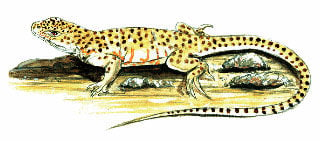 |
My name: Long-nosed leopard lizard, or Gambelia wislizenii.
Try to catch me: Like my namesake, I'm fast and I have dark spots. I'm about 8 to 12 inches long. Males tend to have a larger, broader head compared with females.
Mi casa es su casa: I probably live near you, since I inhabit a large area of the United States and Mexico. I live throughout Arizona, except in the White Mountains. I also set up residence in western and southern New Mexico; Utah and Nevada into Idaho and Oregon; Southern California; and northern Mexico.
OK, so I'm a cannibal:Not only do I like eating grasshoppers, crickets and beetles, but other lizards are good, too! Yup, I'm the Tyrannosaurus rex of lizards!
And hear this: Unlike other lizards or reptiles, I emit a shrill squeal if I'm threatened. And if you happen to catch me and don't heed the warning, I have a fierce bite that will make you wish you had left me alone.
Cold truth: If it's warm outdoors, I might try to escape without biting, but you'd best watch out if it's chilly, because cold weather makes me extra aggressive.
Critter: Lowland leopard frog
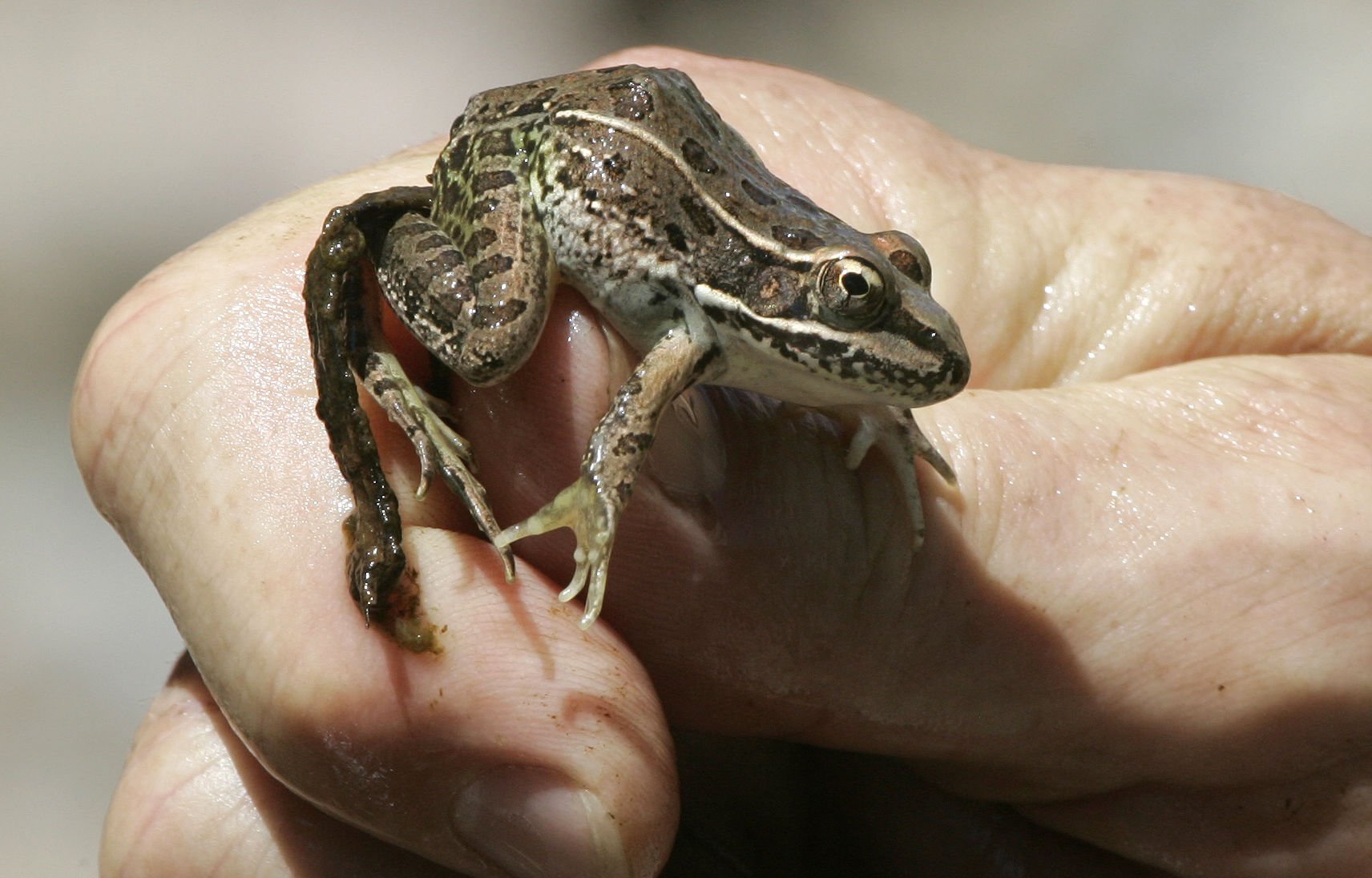 |
Name: Lowland leopard frog, Rana yavapaiensis.
Outward appearance: Ranges from 2 to more than 5 inches long. Coloring is tan to brownish and gray-green to green with many distinct light-bordered dark spots. Bellies are cream with a yellow groin. Webbed back feet.
Usual haunts: Near permanent water areas.
Fascinating facts: The male's voice is different for each of the several species of leopard frogs. The lowland has a call that lasts a half-second. A few years ago, Leopard frogs had been victims of a deadly fungus epidemic that affects only adults and not tadpoles. Mating season is February into April, which is earlier than other local leopard frogs.
Menu preference: Feeds on invertebrates invertebrates close to water, including insects.
Source: Arizona Game and Fish Department
Critter: Lucifer hummingbird
 |
My name is Calothorax lucifer. No, no ... no relation to that other creature of a similar name. I am a Lucifer hummingbird. My name means "light bearer." It's the Latin translation of the Greek word "phosphorus."
Speaking of phosphorus, my throat feathers are bright metallic purple; if you saw them, you might think they're glowing. The females of our species lack that decoration. We all have long, decurved bills and pretty spectacular bronze-green feathers on our backs, though. It's the agave nectar - it works wonders!
We're not overly proud, however. In fact, it's said that we hunch when sitting - not a good thing to do when you're only 3 1/2 or 4 inches long. And while some birds might flaunt such a long, deeply forked tail as ours, well, we try not to make other birds feel bad.
But if they get in our way, watch out. We're pretty territorial. We camouflage our nests, too, which is important since we like to have them low to the ground. We usually scope out an oak or sycamore and build a nest using plant fibers and spider silk. Then we find lichen, leaves and twigs to disguise it.
You'll have to look pretty hard to find us anyway. We've been seen in the Santa Rita and Huachuca mountain ranges and the Mule Mountains near Bisbee, but most of us live in central Mexico. And since we head back there in September, you might have to wait until April for the chance to see us here.
Critter: Magnificent hummingbird
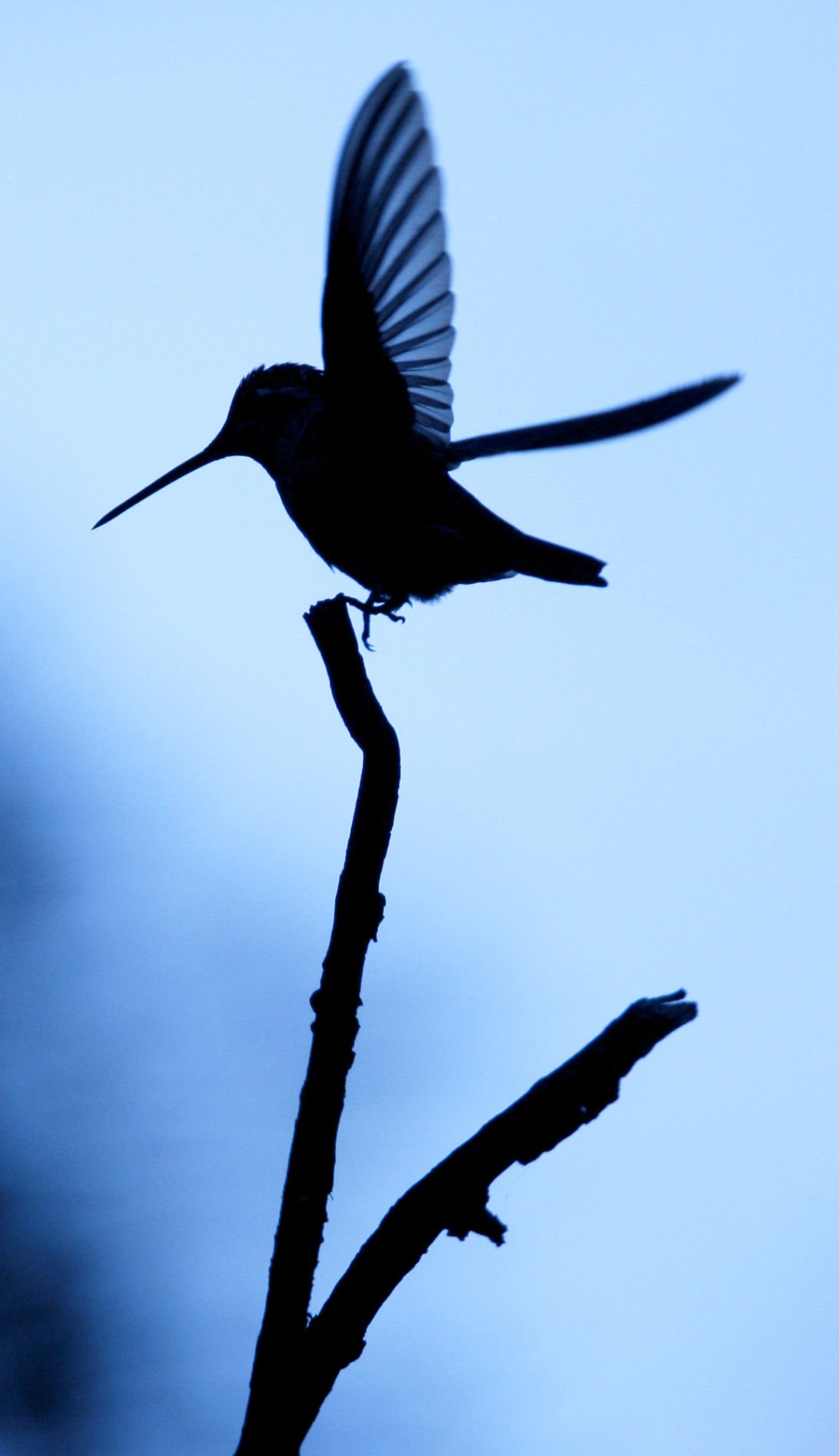 |
Who am I? I am big and I am beautiful. In fact I am magnificent. I am a magnificent hummingbird.
Not a prince: I am the bird formerly known as Rivoli's hummingbird. I was once named for Victor Massena, the Duke of Rivoli. But "magnificent" is much more fitting.
How pretty am I? My throat area is an iridescent green, and I have a deep purple crown. My chest and belly are a glossy green-black. With my metallic dark green wings, back and tail, you have to admit I am quite impressive. The females are emerald green above and whitish gray below. Even our long, black bills are imposing.
And just how large am I? I am 5 inches long with a wing spread of 7 inches. In Arizona, only the blue-throated hummingbird is larger.
My family ties: I nest in tall trees in canyons and on mountain slopes. The nest is about 2 inches across and is made of spider webs, mosses, lichens and fine plant fibers, lined with down and silky fibers. The average family size is two eggs that hatch in 16 days.
My territory: The northern edge of my distribution is Southern Arizona, southern New Mexico and southwestern Texas. But my range goes all the way to Nicaragua. I am a summer resident in Pima, Cochise and Santa Cruz counties.
Source: Arizona Wildlife Views
Critter: Mallard
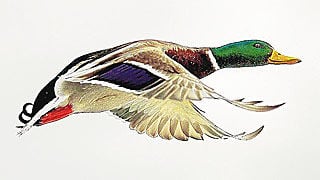 |
Greetings from the mallard, also known as Anas platyrhynchos.
A famous duck: Other than Donald Duck, I'm probably one of the most recognizable types of waterfowl in the world. The image of the male mallard - with his familiar green head, white collar, chestnut breast and grayish body - is common. The female mallard also is easy to identify, with her drab brown color and white tail.
We don't mind company: One of the reasons for our success is our adaptability. We're just as comfortable living among humans in urban areas as we are in the wild.
Vacation spots: We can be found almost anywhere in the world. Some of us are now spending the winter in Tucson. We're at many of your neighborhood lakes and parks.
A balanced diet: We like our lakes and ponds to have large amounts of vegetation and aquatic invertebrates for us to eat.
Have you heard? The familiar loud "quack quack quack" is the sound of females calling other ducks or their young. Males have a much softer voice.
Critter: Mediterranean house gecko
 |
You can call me: Mediterranean house gecko, or Hemidactylus turcicus.
Up-close and personal: I am about 1 to 3 inches long, with large eyes that have no lids and vertical pupils. My coloring can range from light pink, yellow and white to gray and brown. I have a few spots and often a banded pattern on my tail.
We're closer than you think: I like to hang out by your porch lights to catch the bugs that are attracted to the light, but you can also find me in rock crevices and the cracks of tree trunks. I am mostly nocturnal.
Continuing the line: While pregnant, the eggs can often be seen through my transparent abdomen. Usually three sets of one or two hard-shelled eggs are born each year to a female. We share a nest with other females.
I get around: I am a non-native species originally from west India, the Middle East and, of course, the Mediterranean basin. I spread rapidly to many areas because my eggs are often accidentally transported around the world in plants. You can find me from all over the Southwest to the southeastern states, Cuba, Mexico and the Canary Islands.
Critter: Mexican free-tailed bat
 |
Your friend: Mexican free-tailed bat, also known as Tadarida brasiliensis.
About us: We have a long, narrow wingspan and forward-pointing ears. We can fly as fast as 60 mph and travel up to 50 miles from our roosts.
Bat sightings: We live in large colonies in caves, in mines, under bridges and even in buildings. Large maternity colonies live in the cracks under most bridges in Tucson.
Making a living: We set out on nightly flights to consume massive amounts of insects.
Bat habits: We migrate south to Mexico for the winter and return north in the spring.
Bad rap: We can become infected with rabies, but no more than other mammals. We pose no threat to humans. We will bite if handled, but only in self-defense.
Bat show: A mass departure starts around dusk and lasts several minutes. We leave by the hundreds or thousands, following the one in front of us in the same general direction.
Critter: Mexican gray wolf
 |
Do you have a mix of black, gray and brown hair, stand no higher than 32 inches, and hang out with your mom, dad, brothers and sisters all the time? If so, you might be like me - a lobo, or Mexican gray wolf (Canis lupus baileyi).
We are a subspecies of the gray wolf, one of two types of wolves - the other is the red wolf. Even more special, we are the only wolf indigenous to central Mexico and the southwestern United States.
We used to range the deserts of Sonora and Chihuahua - from western Texas, through southern New Mexico, and into southeastern Arizona - hunting deer, elk, rabbits, javelina, and other small animals.
My pack tends to stick together - just mom, dad, and my brothers and sisters in our territory. We were born in the spring. But lobos are pretty rare. In fact, you'll probably only find us in zoos and museums (including the Arizona-Sonora Desert Museum), though the U.S. Fish and Wildlife Service is trying to bring us back into the wild.
Critter: Mexican long-tongued bat
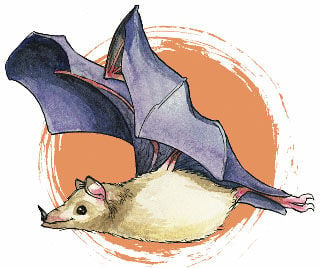 |
Hola! I am a Mexican long-tongued bat, or Choeronycteris mexicana.
Part of my name reveals that I spend time in my homeland of Mexico, but I also live in the southern parts of Arizona, New Mexico, California and even Texas. It is thought that I migrate to where the best flowers are in bloom!
The other part of my name is pretty self-explanatory. Besides that, I am a medium- to large-size bat with brown-gray coloring. My tail is tiny, and I have a spear-shaped flap of skin on my nose.
I eat the nectar and pollen of flowers and the occasional fruit and little insect for protein. My eating habits help pollinate many flowers because the pollen often gets stuck on my face and body.
I roost in the mouths of caves and sometimes in abandoned buildings or mine shafts. I like to stay near the entrance and will often fly out toward the light instead of farther into the dark if I am disturbed.
I like hanging out close to my fellow bats, but don't tend to cluster like other types of bats. I like a good inch or two of personal space while I hang happily from one of my legs.
Critter: Milkweed bug
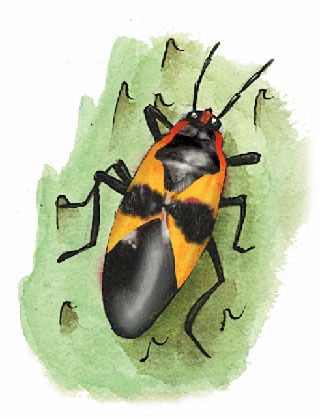 |
Call me: A milkweed bug. I'm a member of the order Hemiptera.
My attire: I am quite a looker - one of those critters you stop and notice. We are orange and black with a very distinctive pattern on our backs. On the underside of the abdomen, the females have one black stripe and two dots, the males have two thick black stripes. We have a long proboscis and delicate legs.
Family time: We are quite gregarious and often hang out in large groups. If you see two milkweed bugs attached end to end, it means the family will be growing soon. The youn'uns take about a week to hatch and a month and five molts to become an adult.
Dinnertime: As you might guess from our name, we dine on milkweed pods. Our long proboscis allows us to penetrate the pod to get the food inside. Because we help control milkweed, we are considered beneficial, unless you are a milkweed plant.
Yuk: Because the toxic milkweed gives us a very nasty taste, we are safe from most predators. Other insects mimic our bright coloration to keep away hungry birds.
Want to adopt me? We are easy to raise and good to study, consequently we are often used in laboratories and science classes. We can be purchased commercially or captured. In captivity, we live on shelled sunflower seeds.
Critter: Mountain lion
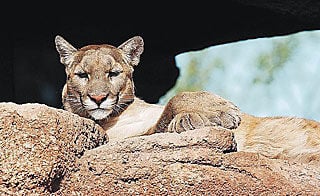 |
I am a Puma concolor, but I like to be called mountain lion. I also answer to puma, cougar, panther and even catamount.
I am no domesticated cat, even if I am very cute. In North America, I'm second in size to the jaguar. I'm 6 to 8 feet long from head to tail. My tail is about 2 to 3 feet long. I can weigh between 75 and 200 pounds. I'm grayish-brown to brownish-red. My belly is a little lighter in color than my back. My tail has a black tip. My feet are large and padded. I see very well.
I like Arizona and can be found all over the state. The area I consider as my home range can be anywhere from 75 to 200 square miles. My den is made in caves, under logs, under rock overhangs and on ledges on the side of cliffs.
I can run up to 35 mph, but not for a long time. I can leap 15 feet. I don't bother to chase much of my prey because I prefer to ambush my meals.
I dine on both large and small animals. I like deer, sheep, javelinas and rabbits.
I usually have one to four babies that are born after 14 weeks. The newborn cubs weight about 1 pound, are blind and have spotted fur. They are able to be on their own by 1¼ to 2 years of age.
Critter: Morpho butterfly
 |
Can't miss me: They call me the Morpho butterfly, or Morpho menelaus, and I'm a real looker in the world of butterflies. My iridescent, bright blue upper wings can't be missed.
Lush habitat: I love to fly quickly through the dense rainforests in South and Central America, where I make my home. I rarely go near the ground but can be found basking in the sun and showing off my wings, which are nearly 7 inches long.
Beauty as defense: I actually use my beautiful coloring as a defense mechanism. While I flash around my bright blue upper wings during the day, the underside of my body is usually brown, gray or black and resembles foliage, which allows me to fool my enemies. At night while I'm asleep I fold up my wings so only the dark underside can be seen. This is called "crypis" and it makes me less visible to predators while I slumber the night away.
Humble beginnings: I wasn't always so beautiful. They call me a Morpho butterfly because I pass through four distinct phases of metamorphosis, the first being a pale green egg, which looks like a dewdrop. My "ugly" stage comes second; I turn into a red-brown caterpillar with lime-green patches and stinging hairs all over my body.
Critter: Mosquito
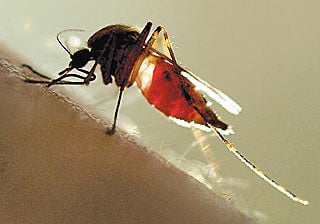 |
I am a mosquito. I'm sure you've heard of me. I'm the one that's making you itch. Don't scratch.
Look at me: I'm quite small and have long narrow wings and a long proboscis. That's a tube through which I suck my nourishment. More on that later. Females have short hairs on their antennae; males have more and longer hairs on their antennae.
What's for dinner? You may think we all like only blood, preferably yours. That's not true. With most mosquito species, the males prefer nectar. It's the females that are the bloodsuckers, and most of that biting happens at night or just before sunset.
The mosquito hovers near her food source - that's you - to discover the warmest spot. That's where the capillaries are closest to the surface, making it the easiest spot for drilling. She uses her proboscis to suck blood from her victim, and she tends to leave behind a little saliva in the process. That's what causes the itching that's driving you crazy.
Making more mosquitoes: Moms lay their eggs on the surface of water, and the larvae and pupae require that water to mature. Water with some plant material in it is best. If there's no water, I won't lay the eggs. So stop scratching and check for standing water around your yard and house plants.
About that itch: So I already bit you. I don't really care if you itch. But I can tell you that scratching just makes it worse. There will also be a little swelling right at the bite site. That's the red bump that you're scratching. You can try alcohol or calamine lotion. Just stop scratching!
Leaving my mark: Have you heard of the West Nile virus, malaria and dengue fever? You can thank me for spreading them and some other diseases. You're welcome.
Stop scratching!
Critter: Mountain skink
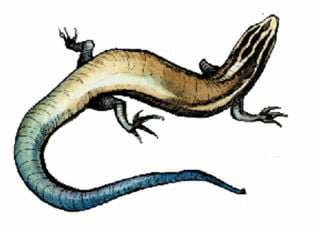 |
My name: Mountain skink, aka Eumeces callicephalus
My looks: I am a small lizard with shiny scales and four limbs. I am olive or tan on my upper parts, with a pale stripe and dark-brown band that can run from my eye to my groin. My tail has a bluish hue, and I sometimes have a Y-shaped mark on my head. Younger skinks have more pronounced coloring and more distinctive markings.
My extended family: There are about 1,200 species of us, with at least one type living on every continent on Earth, except Antarctica.
My home: You can find me in rocky areas, oak and pine habitats, and generally where there is moisture, although some of us prefer the desert.
My food: I dine on insects such as spiders, beetles and flies that I catch with my forked tongue, which often hangs out of my mouth.
My trick: If you want to catch me, grab my whole body because I can easily detach my tail, which will wriggle about as I try to distract you while I make a run for it!
Critter: Mourning cloak butterfly
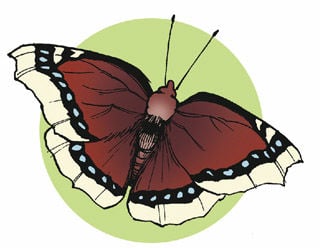 |
Butterfly in mourning? I'm the mourning cloak butterfly, or Nymphalis antiopa. My name comes from the dark-purplish part of my wings that looks like a cloak one might wear when in mourning. The edges of my wings are a soft creamy-yellow color, and a fine line of blue shimmering spots separates the light and dark colors on my wings.
Hide and seek: My dark "mourning cloak" allows me to hide and camouflage myself in dark areas like tree bark. I tend to hide from humans, but sometimes I can be lured to human hands with sweet fruit in the summer.
Montana's star: I'm commonly found all over the United States, but the people of Montana like me so much that they made me the official state butterfly in 2001. I'm well-suited to Arizona, though, because in order to fly, my wings need to be warm. The dark cloak on my wings absorbs heat, and the dry heat of Arizona allows me to fly in search of my favorite food - tree sap.
Days of our lives: Adults of my species usually live about 10 to 11 months, making us one of the longest-living butterflies. We hibernate in the winter, then emerge in the early spring to mate and lay eggs, which hatch into caterpillars.
Rare to some: Though I'm one of the most common butterflies in the United States, my species is rare and desired in England, where I'm called by the common name of "Camberwell Beauty."
Critter: Mourning dove
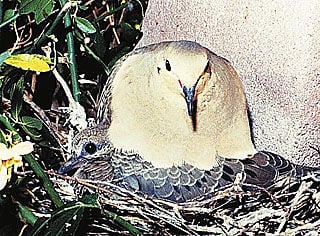 |
I am a mourning dove, or a Zenaida macroura.
My name comes from my call, which some people think sounds mournful with a "coo-ah, coo, coo, coo."
I am about 12 inches long. I am sandy-brown. I have a long tail with white edges. My wings have black spots.
I can be found in the United States up to Alaska. I am also found in Canada, Mexico and even Panama. I like open fields and parks.
My nest is made with sticks, and I build it in trees, or bushes and sometimes even on the ground. I usually have two white eggs. I eat and partially digest food for them before I feed it to my babies.
People in the United States aren't consistent at all. In some states I am protected, while I am shot at in others. I don't feel safe in Arizona during hunting season, Sept. 1 to Dec. 15. I am ranked as one of the two most important game birds by the state.
Critter: Mud Dauber
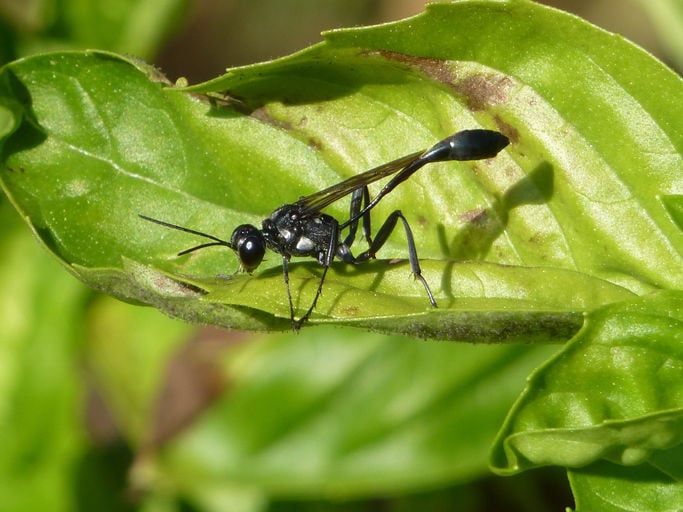 |
I am a mud dauber. Although I am a wasp, don't be afraid of me. I am not aggressive and should be considered beneficial. I am a solitary critter, and while I can sting, my bite is not considered dangerous.
My delicate physique: I am a medium-sized wasp, about 3/8 to 3/4 of an inch in length. My segmented body includes a long, slender petiole, or stalk, for use when building a nest. We mud daubers in Arizona are usually dark or metallic green, blue or black.
Daubing in mud: We get our name from the nests we build. They are cylindrical tubes attached to bridges, houses, under eaves or wherever we think it looks like a good place for a home. The nests can be about the size of a baseball.
Setting up the nursery: The nest is lined with paralyzed spiders. These hapless critters provide the larvae with nourishment while they grow. Generally, the new family emerges in the spring and starts the process all over again.
Living with me: I do eat other insects, and you can usually let me alone to do my thing. If you find it necessary to get rid of my nest,do not handle it - use a hoe or other implement. I won't defend my nest, although I may be very sad.
Source: "Venomous Animals of Arizona" by Robert L. Smith
Critter: Mule deer
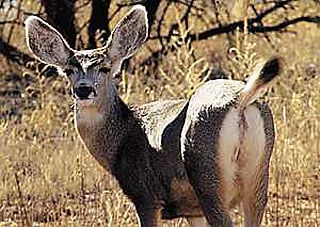 |
Muley! That's what some folks call me! I object and prefer to be called a mule deer. Scientifically, I will answer to Odocoileus hemionus.
It's about the ears! My name comes from my rather prominent ears. I guess they could have called me a donkey deer, so I won't complain. My ears are about 9 inches long, and I have excellent hearing. My ears act like portable antennae.
It's about the feet! I am one of four hoofed species, or ungulates, that call the Sonoran Desert home. The others are the javelina, pronghorn and bighorn sheep. The hooves are specialized claws or toes that are great for running away from our predators, especially those pesky mountain lions.
I'll ruminate on that! I am a herbivore. I like, among many things, mesquite beans and leaves, jojoba, catclaw and a variety of grasses and forbs. I also am a cud chewer, so I chew and chew and chew.
Picking me out in a crowd! I am about 6 feet long and stand about 3 1/2 feet tall at the shoulder. I am brownish-gray, with those aforementioned ears. My rump has a white patch, and my small, white tail has a black tip. This is supposed to help with predator control. Bucks grow antlers that are shed in the spring and regrown in the summer and fall.
Calling the place home! I am found throughout the desert wherever I can find enough to eat and good places to hide. I might make some seasonal elevation changes, like lots of desert dwellers do, to get out of the heat.
Critter: Ocelot
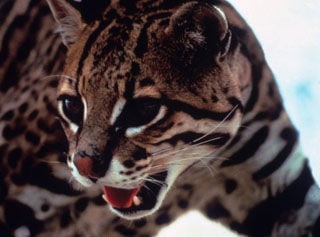 |
I am an Ocelot
The face in the mirror: I am smaller than other wildcats — between 3 and 4½ feet long. I weigh about 30 pounds, My coat is light yellow with black spots and bars.
Menu choices: My favorite meals are birds, deer and mice. I hunt at night.
My enemies: I spend my days in high trees to keep safe from predators. Humans have hunted me for my coat and that, along with diminishing habitat by clearing of brush lands in southern Texas, have caused my numbers to dwindle. I am listed as endangered.
Family: We mate from early September to late November. The ladies have one or two babies.
Fascinating facts: I compensate for my small size by having powerful legs that help me to be one of the fastest cats.
Critter: Orange Sulphur Butterfly
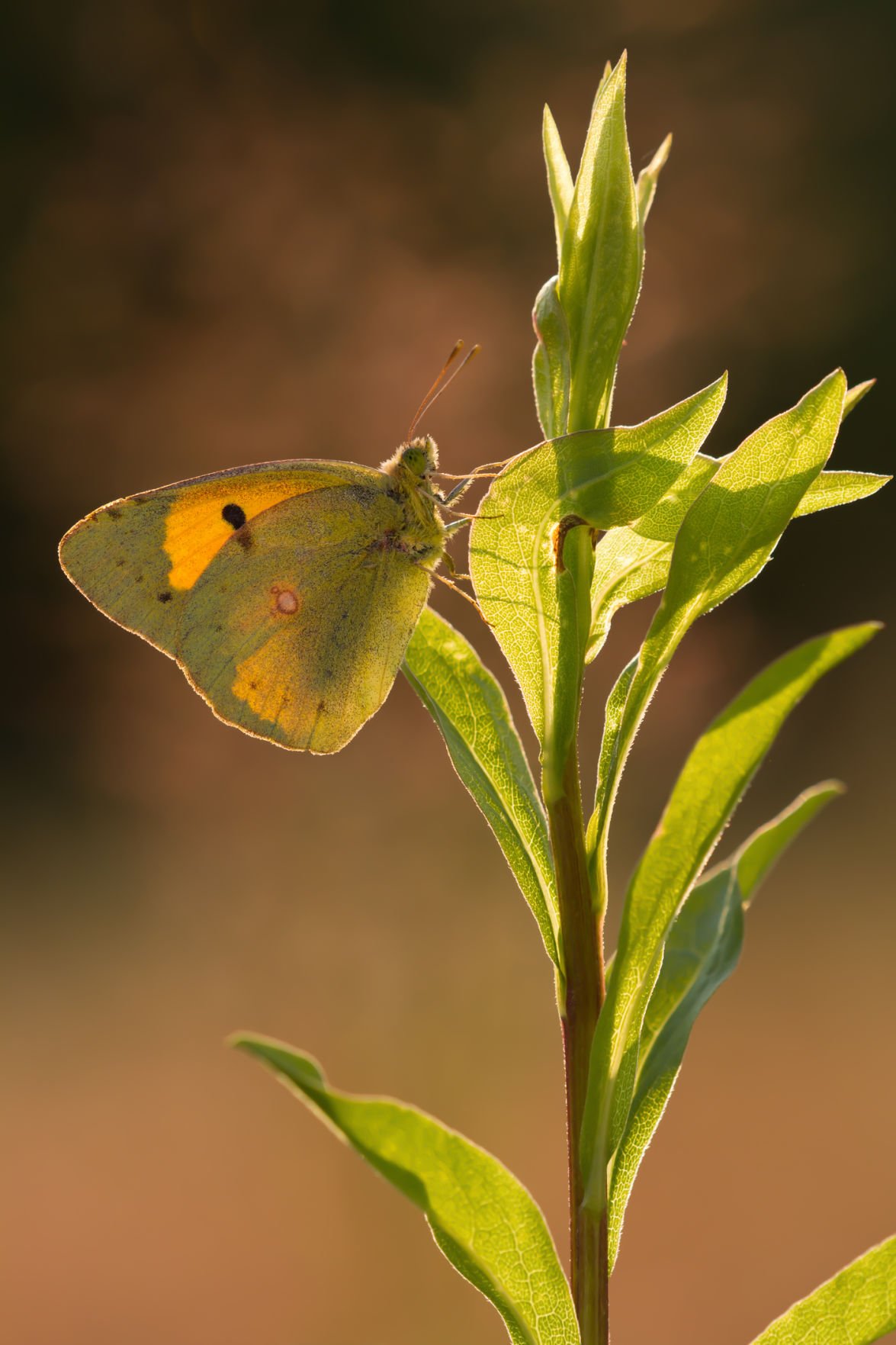 |
Name: Orange Sulphur butterfly, aka Colias eurytheme Subfamily: Coliadinae
What to look for: This is one of the most abundant butterflies in North America. Males are yellow with orange overlay, yellow veins, black borders and black spots. Females are yellow or white, and they have irregular black borders and lighter- colored spots. The wingspan reaches 2½ inches. This critter is easily confused with a similar species, the Clouded Sulphur.
Where to look: Adults fly year-round in the warmer areas of Arizona.
What they eat: Usually nibble at night on a variety of flowering plants.
Big appetites: In caterpillar stage, they can do large amounts of damage to plants, chewing holes in the tops of leaves.
Where they hang out: Prefer open areas, mowed fields, roadsides and gardens.
Source: “Butterflies of Arizona: A Photographic Guide” by Bob Stewart, Priscilla Brodkin and Hank Brodkin.
Critter: Osprey
 |
I am an osprey. For you scientific types, I am Pandion haliaetus.
Where you can find me: I have a breeding range from Alaska to Newfoundland down to Arizona and New Mexico. I like to winter along the California coast, but, hey, who doesn't? Or, I may head to Latin America. You will find me around lakes, rivers and seacoasts. I vant to be alone and will usually be hanging out by myself.
As hawks go: I am on the large side. My length is 21 to 24 inches, and I have an impressive wingspan of 4 1/2 to 6 feet. When my wings are extended, there is a distinct "wrist" that is visible. I have a brown top side and a white underside. My head is white with a dark eye-stripe.
Gone fishin': I am a very specialized hawk because of my fishing technique. I hover over the water and wait to spot a fish. Then I plunge down into the water at a steep angle to snare the fish in my sharp talons. Interestingly, as I fly off to have dinner, I like to reposition the fish so its head is pointing forward. Enjoy the view, little fishy.
Good news: Although I was nearly done in because of pesticides in the 1950s and '60s, I am coming back and nesting in places where I had previously disappeared.
Critter: Palo verde root borer
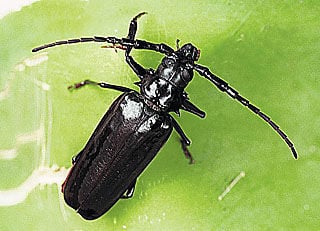 |
I am a palo verde root borer. You might call me scary, disgusting or yukky, but that is just because you don't know me.
My impressive appearance: If you can stand to get close enough, I am really quite amazing to look at. I am about 3 to 4 inches long and dark brown. Everything about me is big, so you can really see my wings, antennae and legs. I have strong mandibles that come in handy during battles at mating time.
The boring part: We emerge from the ground during the monsoon season. The ladies, after mating, burrow into the soil to lay their eggs. They dig down about a foot near a root, generally a palo verde tree. It can take up to three years for the youngsters to appear on the surface. They live on the root's starches while developing. Much maligned for killing trees, we don't usually harm them, unless we happen to sever a major root. In New Mexico, they call us mesquite borers, because that is our tree of choice over there.
It's a bird! No, it's a beetle! I fly at dusk and could be mistaken for a slow hummingbird. This is when mating takes place, as well as when we scout out a new place to lay eggs. The males can get rather mean during the mating season, but it's our rivals we don't like, not you.
Critter: Peregrine falcon
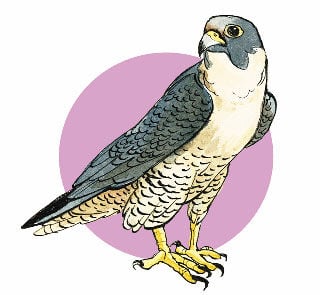 |
It's a bird! It's a plane! It's ... really a peregrine falcon, so the first guess was right. Peregrines can rocket down out of the sky at nearly 200 mph.
A room with a view: Peregrines hang out near water, and like to live on and around cliffs. They hunt smaller birds, sometimes hunting in pairs to confuse prey. A falcon may strike its prey inflight with its talons curled into a fist, catching it as it falls. The bird regurgitates in pellet form anything it can't digest, likes bones and feathers.
It's a family thing: Peregrine young are incubated and cared for by both parents. Falcons mate from April to July, usually producing one brood of two to five eggs that hatch in about a month. Babies start to leave the nest at around six weeks.
Pesticide predicament: Pesticides are the main reason these falcons were placed on the endangered species list in 1984. The pesticide DDT, eventually banned in the United States, made their eggshells so thin that they would break during incubation. The peregrine was removed from the list in 1999 after breeding programs increased the population.
How the falcon helped build faster jets: Jet engines used to stall out at high speeds because air that should have gone into the engine would get pushed out around it, but the discovery of a small, protruding cone in falcons' nostrils helped humans figure out how to funnel air into the engine instead.
Critter: Phainopepla
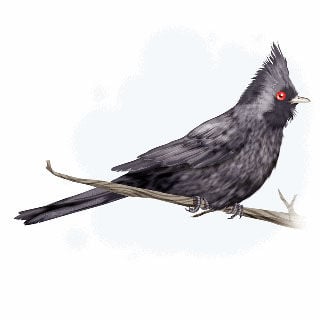 |
Alright, don't make fun of me because my name is Phainopepla or Phainopepla nitens.
Despite my long name, I am quite a looker. Males of my type have shiny black feathers with a spot of white on the wings. Females and younger birds are brownish-gray. We have red eyes.
I have an interesting connection with my food. My main food source is mistletoe seeds. Once I eat them, most of them travel through my digestive system unharmed, and end up back on the tree branches (use your imagination). The seeds then begin to grow more mistletoe for me to eat!
I like to live in the desert bushes and trees of Nevada, Arizona, New Mexico and California. I leave the desert during the hot summer months for higher elevations.
Females among us lay two-to-three eggs in the high branches of trees. The eggs are pale in color but are colorfully specked with black or purple spots.
Both males and females sit on the nest for about 15 days.
Critter: Pima orangetip butterfly
 |
I am not a plain butterfly. I am rather pretty with my bright yellow wings. The upper tips of my wings are orange and black. My wings have a white edge with black marks. The underside of my wings has bands of green and a yellowish-white color. I am an Anthocharis cethura pima, but you can also call me a Cethura Orangetip or even a Pima Orangetip.
I can be found in winter and early spring when it first becomes warm. I prefer the low deserts and love saguaro cactus. I like to hang out in Arivaca, the foothills of the Santa Ritas, the Huachucas, the Dragoons, the Chiricahuas and the Peloncillos.
I can be found near crucifers, which are plants, when I am young and old.
Males can be found on the hilltops, while the females are usually found on the slopes of the hills. We meet for afternoon delight where the crest meets the slope.
Critter: Pink elephant
 |
Have you seen me? If so, you may have had too much to drink on New Year's Eve. Many consider that I am imaginary, but I beg to differ. I am a pink elephant. I am often seen in a herd, marching tail to trunk.
One too many: Considered a whimsical character, I am often associated with an overindulgence of alcohol. As attitudes toward drinking have changed over the years, so has my image. In the 1940s and '50s, my cute likeness was frequently seen adorning cocktail napkins and swizzle sticks. I even had a drink named after me. I was not the one doing the drinking, but usually I was portrayed as being tipsy. Modern times and changes in how drinking is viewed have relegated me to a humorous symbol that time has passed by.
Where did I come from? The earliest reference to me as a drinking hallucination seems to be in the 1890s. Jack London referred to me in "John Barleycorn" published in 1913.
Sing my praises: In the 1930s, Guy Lombardo had a hit song about pink elephants running amok with a lavender alligator and a polka-dot boa constrictor. "Pink Elephants on Parade" was a song from the 1941 Disney animated movie "Dumbo." Apparently, for some, the almost psychedelic scenes that accompany the lyrics are frightening enough to garner the segment a spot on the 100 Scariest Movie Moments list.
Call a cab: If you do see me, join me for a cab ride home.
Critter: Pipevine swallowtail
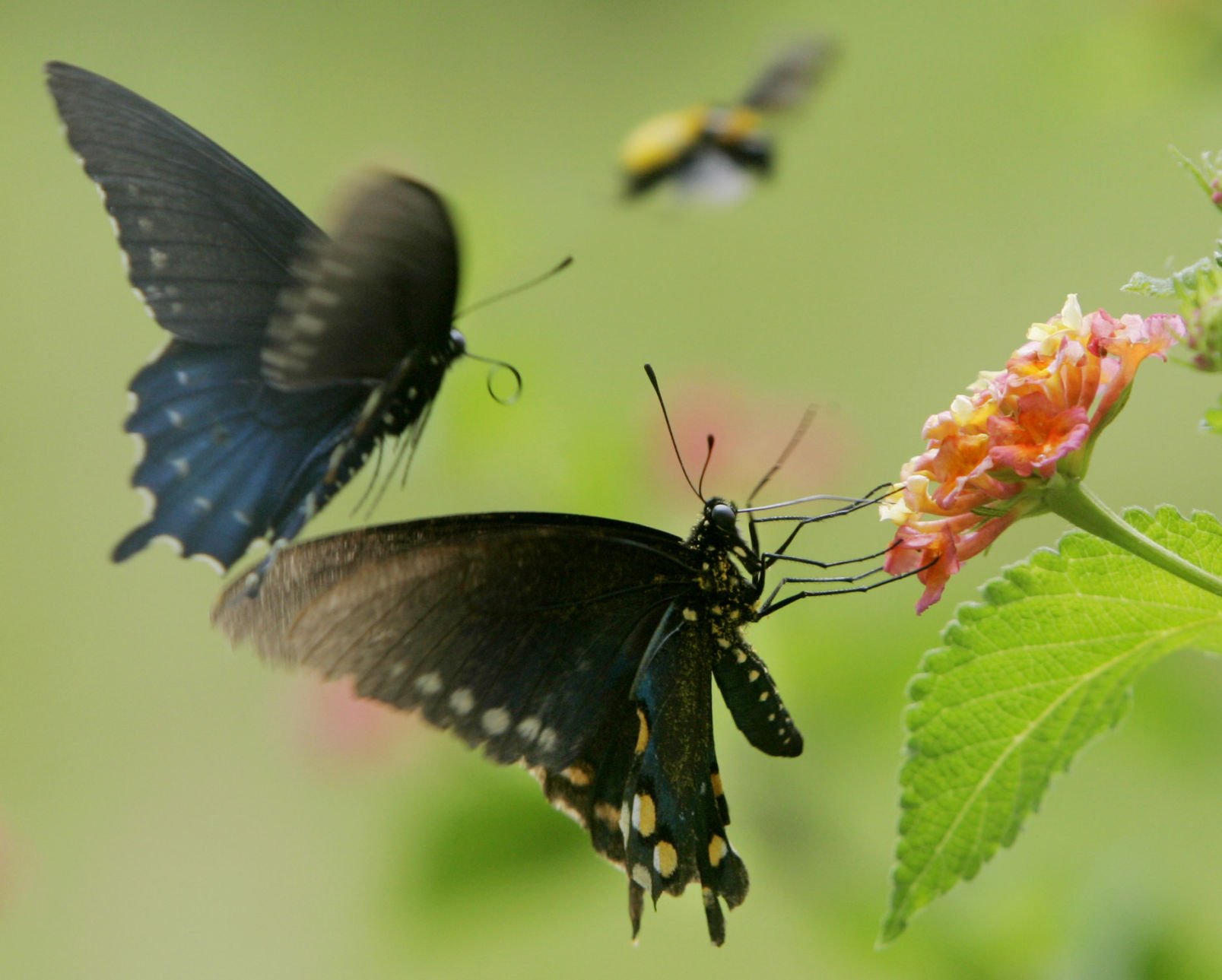 |
Name: Pipevine swallowtail, aka Battus philenor
Description: This critter is a small- small- to medium-sized, medium-sized, medium-sized, glossy blue-black blue-black blue-black butterfly.
Feeds: Obtains nectar from a variety of flowers, such as cnidoscolus and ipomoea.
Usual haunts: City gardens and mountain canyons. Can be found , from the spring into the fall. Has , been spotted all year around in Nogales.
Cool stuff: This butterfly flutters its wings while taking nectar, however, its wings are still while it is taking water
Source: "Butterflies of Southeastern Arizona"
Critter: Prairie falcon
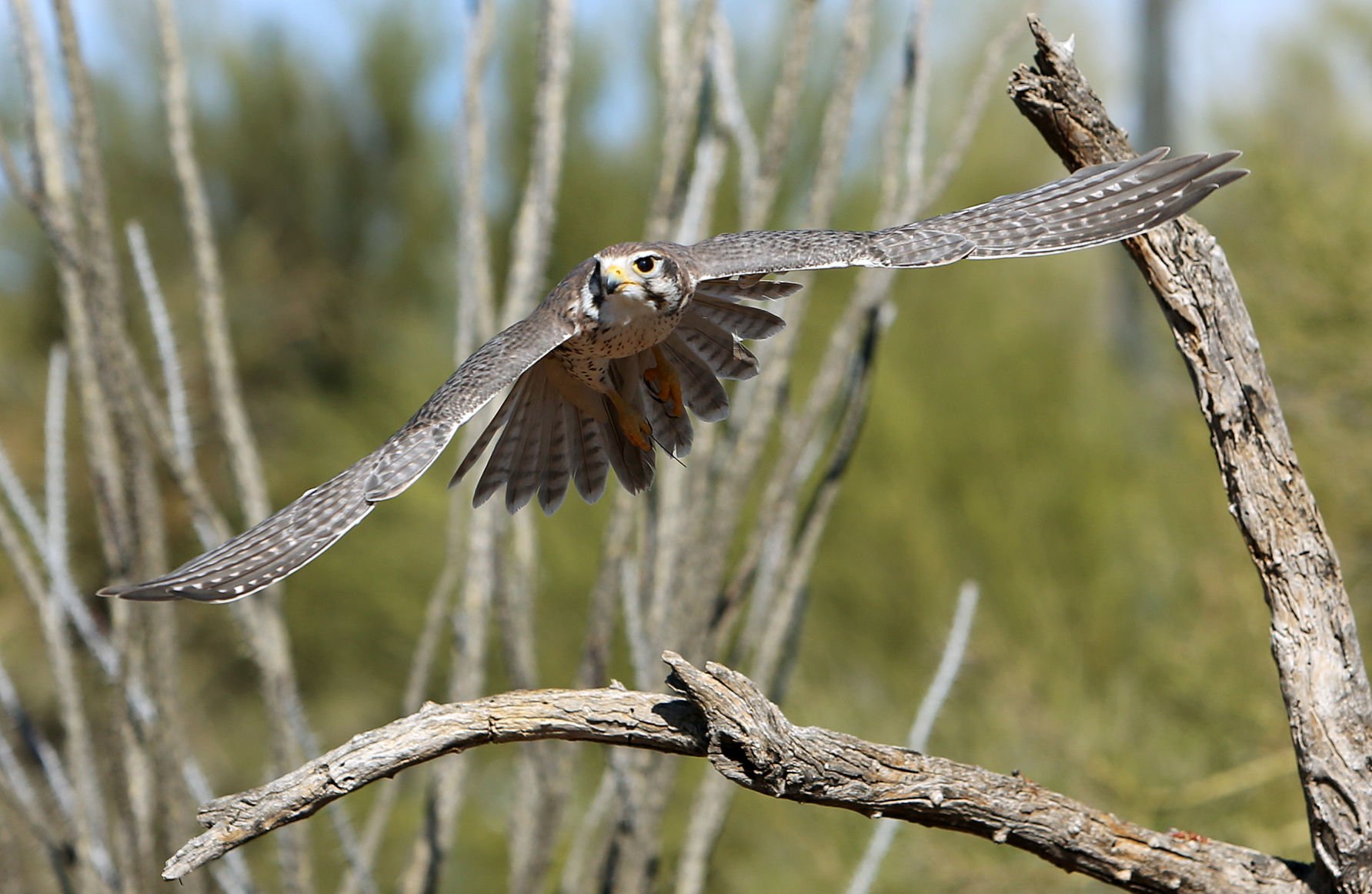 |
Name: Prairie falcon, aka Falco mexicanus.
Favorite fashions: This falcon is pale sandy-brown above with lighter feather edging and creamy with fine streaking below. It has black wing pits. It measures 17 to 20 inches in length with a wingspan of about 42 inches.
Neighborhood: The prairie falcon is found from the Canadian prairies to the Mexican border. It also winters farther south.
Local address: This bird likes open mountains, dry plains and prairies.
Favorite foods: Ground squirrels and other rodents and small birds are the preferred diet.
Life and death: The falcon lays three to six reddish, spotted eggs in an aerie set on a protected cliff ledge. Nest robbers and rodent poisoning programs have reduced prairie falcon numbers.
Facts: It flies faster than the peregrine falcon and can overtake other birds its own size.
Critter: Praying mantis
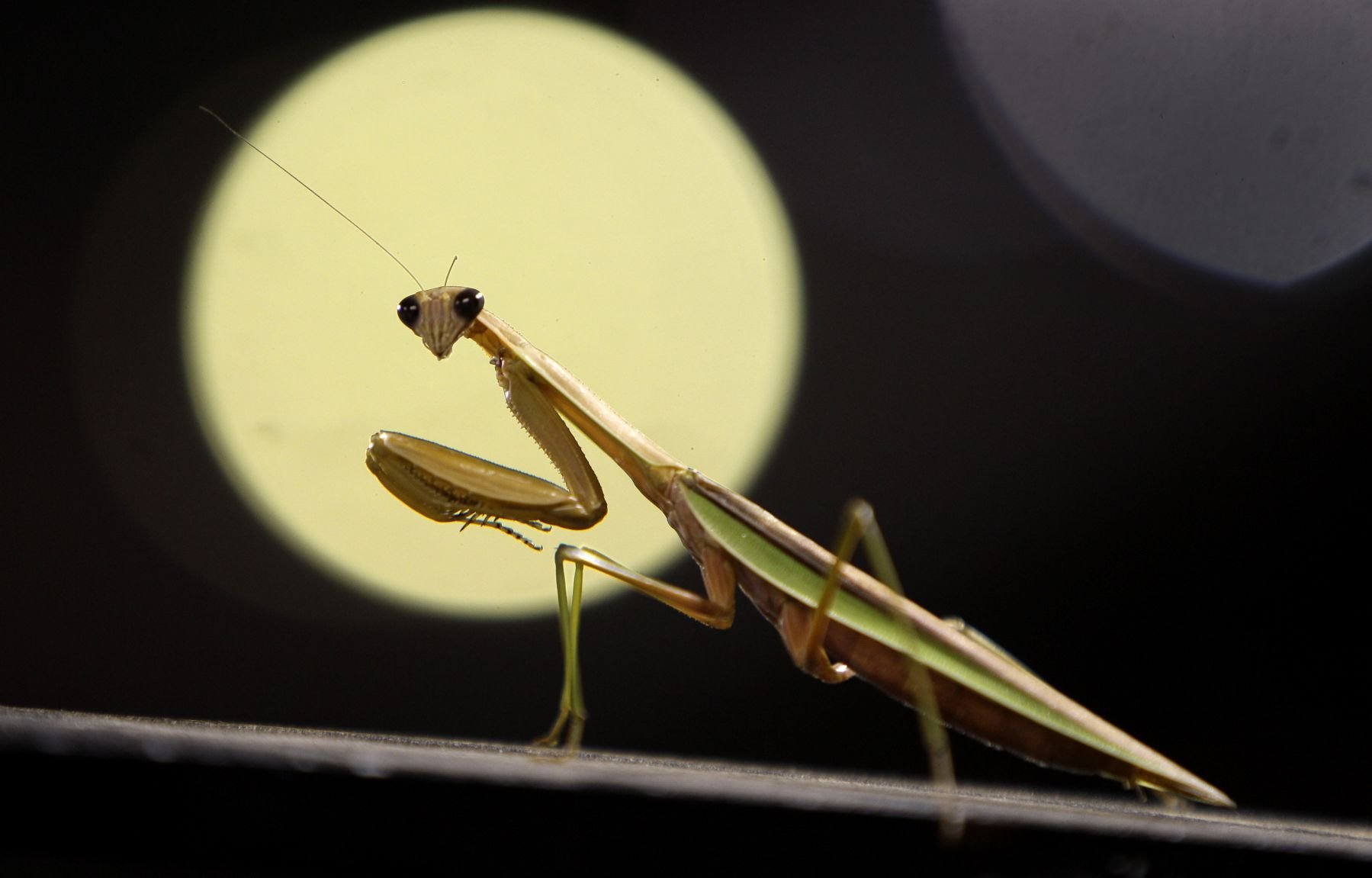 |
My name: I am a praying mantid; some folks call me a praying mantis.
My whereabouts: Here in the Southwest you'll find about 10 native species of mantids. Some of us are small, narrow and brown, and like the desert soil. Some are larger, green ones that can vary to yellow or tan. One relative is an immigrant from the Mediterranean. This guy is spectacular, with hind wings that have a large, dark eye spot. His name, Iris oratoria, means "talking eye."
Time to eat: My front legs are quite noteworthy for their rapid reflexes and strength. I ambush dinner by snatching it so quickly it doesn't know what happened.
Till death do us part: Courtship has its dangers for the males in my group. Some gals have been known to grab their suitor and start munching on him, too.
Here come the little ones: The casing we deposit the eggs in is called an ootheca. It contains masses of eggs covered with a hardened foam. It's a very secure incubator for the dozens of young that hatch.
Source: "Insects of the Southwest" by Floyd Werner, Ph.D., and Carl Olson, M.S.
Critter: Pronghorn
 |
I am: A pronghorn.
I am not: An antelope, although many call me that, even zoologists. I am not even closely related to the antelope.
I look like: A deer. I am 3 to 4 feet high at the shoulder. I am light brown to brownish-red in color with a white throat, chin, rump and lower half of the abdomen. I have long, slender legs and a short tail. I have horns that are sharply curved with a single prong halfway or farther up the shaft. The females' horns are quite short.
Find me: In the grasslands of Northern and Southern Arizona and other Western states.
I eat: Grass, weeds, greasewood, sagebrush and grain crops.
I survive: Because I am fast, barbed-wire fences and snow are not my friends, as they allow coyotes to catch me. Otherwise, I can tolerate varied climates and temperatures from 40 below zero to more than 120 degrees.
I am fascinating: I am the second-fastest mammal in the world and can reach and maintain a speed of 65 miles per hour. Only the African cheetah is faster. I evolved here in North America.
I do not have antlers. I have true horns, which are modified growths of skin, and I am the only animal that sheds my horns every year.
Critter: Pyrrhuloxia
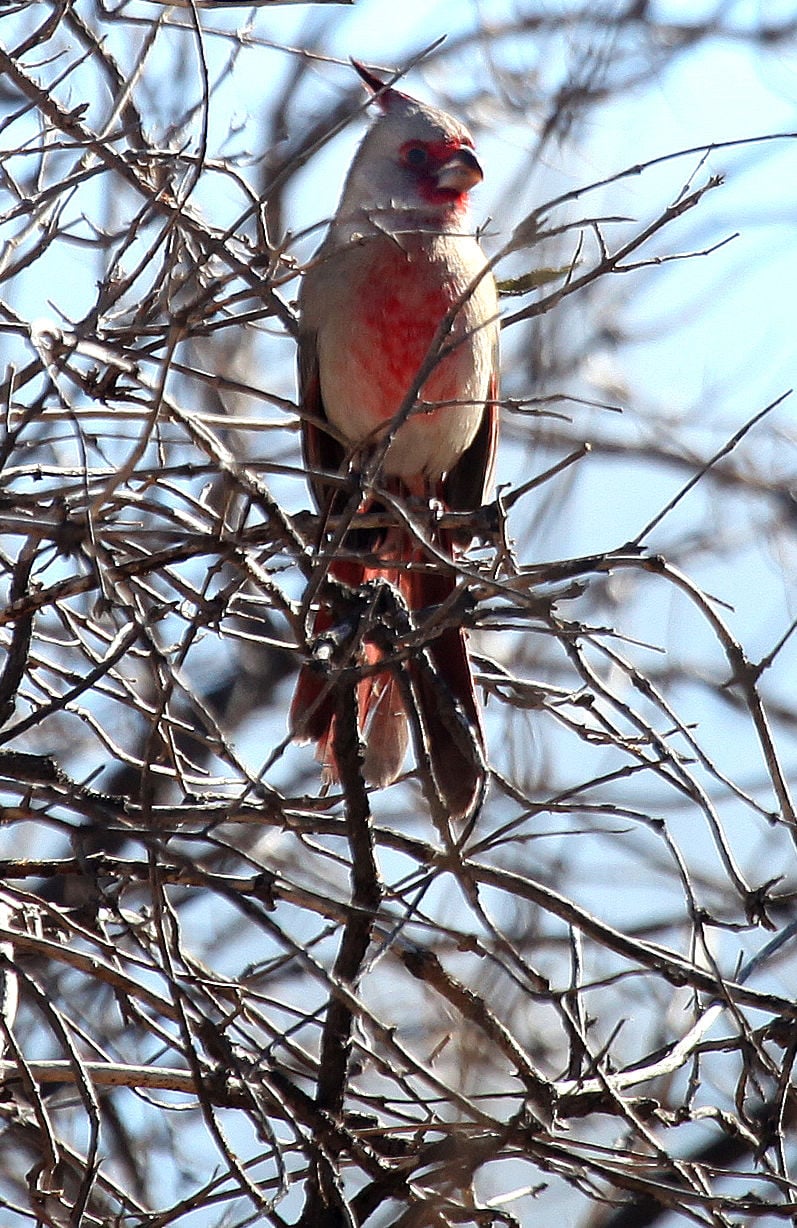 |
Call me: Pyrrhuloxia, aka Cardinalis sinuatus
Attire: I look like a gray cardinal, but I have a yellow to ivory colored parrot-like bill. I am about 7½ to 8 inches in length. The guys are gray and have a crimson crest with rose stripes on the breast and belly with red flashes on the wings and tail. The gals are more buff-colored than gray with touches of red near the eyes and on the crest, wings and tail.
My song: Tseeu tseeu tseeu tseeu
My call: Qu it
Mailing address: Mesquite scrubs in the southwestern United States to central Mexico.
Feed me: Cotton worms and weevils — I am very beneficial around cotton fields. I also like seeds and berries.
Did you know? My name comes from Latin and Greek words meaning "bullfinch with a crooked bill."
Source: Audubon Society Field Guide to North American Birds
Critter: Queen butterfly
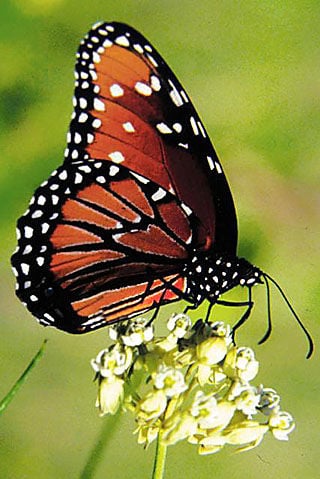 |
Name: Queen butterfly, aka Danaus gilippus
Looks: A close relative of the monarch butterfly, queens are medium-sized and generally orange and brown. Queens belong to the brush-footed family of butterflies.
In early stages: Caterpillars feed almost exclusively on the plants in the milkweed family, which are poisonous to most vertebrates. Most larvae are fiercely spined, and their pupae are usually sharply angled and adorned with silver or gold colors.
Specialties: Queens are remarkably strong fliers, migrating great distances every year to roosts in California and central Mexico.
Butterflies are important pollinators, and few of them pose serious threats to economically important plants. In short, they are benign and aesthetically pleasing.
Critter: Question mark butterfly
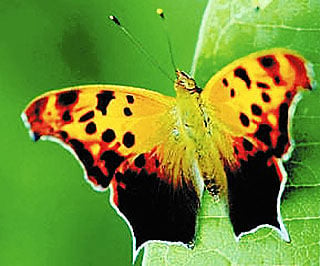 |
My name is: Question Mark butterfly, aka Polygonia interrogationis.
At first glance: You may notice a torn look to the edges of my wings. My brown, black and white coloring serves as excellent camouflage while I perch on tree trunks.
How I got my name: From the silver question mark on the underside of my hind wings.
Look for me: Widespread throughout the Eastern United States, a small number of us thrive in the Southwest. We may be few in number, but you will have no trouble identifying us or recalling our name once you locate the question mark.
Sun worshipper: The most likely place to find me will be during your afternoon walk along the edge of a forest. Males like to find a sunlit spot to set up their territory, fluttering and flying around to ward off intruders and catch the last of the sun's rays.
On the menu: Sap, rotten fruit, excrement and damp soil.
Critter: Raccoon
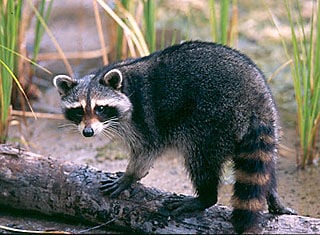 |
I am a raccoon, or a Procyon lotor.
I have black hair around my eyes that makes me look like I'm wearing a mask.
With striped brown, black and gray fur, I'm about 16 to 28 inches in length. My ringed tail is anywhere from 8 to 12 inches long and I weigh from 15 to 40 pounds. With my paws on the ground, I stand about 12 inches tall at the shoulder.
I like to hang out in areas with trees and near rivers and ponds. You can find me in many areas of Arizona, but I shy away from the south central part of the state.
I'm mostly active at night, but sometimes can be found sunbathing in a tree. I live in dens that I make in hollow trees, holes in the ground and even under buildings.
When it comes to food, my tastes range from nuts and berries to crayfish, rodents and carrion. I will gladly take vegetables from your garden and stuff from your trash can, too.
My mating season is in December and January. I am pregnant for about 63 days. Usually I have two to seven babies, and they are born blind. Newborns are about 4 inches long and weigh about 2 ounces. They have light fur, but I know they are mine because they have a faint mask and a ringed tail. How cute ? and they grow so fast!
They nurse for several weeks and open their eyes at about 21 days. The adventure of leaving the den usually happens at about 10 weeks of age. The babies are completely independent at anywhere from 4 to 6 months of age.
Don't think I am bragging, but I climb and swim very well.
Critter: Red Satyr
 |
I am a red satyr. Just looking at my name, you might expect me to appear as a flame-haired, horned and goat-footed follower of Pan and Dionysus who chases nymphs in the woods. Chasing nymphs sounds like fun, but any nymph I chase would be a butterfly, just as I am.
I am handsome. My front wing is 1 1/2 inches to almost 2 inches from base to tip. My wings have a brown background with red or orange patches on the upper side of both sets of wings and on the underside of the forewing. I have two large eyespots and small blue eyespots on the underside of my hind wings, and a large eyespot on the underside of each forewing.
Find me. I like the center and southeastern quarter of Arizona and parts of New Mexico, Texas and Mexico. I like oak woodlands and mesquites.
Chasing nymphs: When I, a male, am in the mood, I fly to the top of a hill - usually in midmorning - and wait or look for the ladies. They aren't really nymphs, but red satyrs like me. I do this from the spring to the fall, and the ladies have one or two broods in that time.
Feeding the hungry: Our host plants are grasses, and eggs are deposited on these. Hungry larvae can then begin eating as they emerge.
Critter: Red-winged blackbird
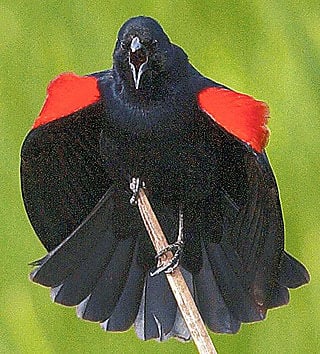 |
I'm a red-winged blackbird. Sometimes I'm called a Agelaius phoeniceus.
We get our name from our males, who are black with a red spot on each wing. The spot is actually red and gold, but I won't be picky about it because I really like my name. The females look a lot different, with streaked brown-and-white feathers. My body is about 7½ to 9½ inches long. My wingspan is 10 to 13 inches.
I dine on insects and seeds. I prefer areas with grasslands and wetlands.
Arizona is my home year-round. My cousins who live up north come to stay with us during the winter. When they migrate, the males and females don't travel together. The males go first and pick out a site for the nest, and then they attract females with their striking red spots.
Our mating season is in early spring. We usually lay three to five eggs, which are light blue and have purple and black marks. After 11 days, our baby birds come out of the eggs blind and featherless. When they're 20 days old, they're ready to leave the nest. The females tend to the young, while the males protect the nests.
Critter: Regal horned lizard
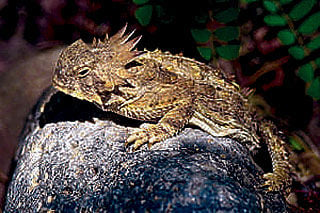 |
My name is: Phrynosoma solare, but I don't stand on ceremony. You may call me a regal horned lizard.
Mistaken identity: If you've heard the term "horny toad" it refers to me and other horned lizards - and, of course, we're not really toads.
My royal good looks: My name is a dead giveaway. I have horns around my head that look like a crown. The four large horns at the back of my head are connected at the base. I am 3 to 5 inches long, and I'm gray or beige in color, with a light mid-dorsal stripe. On each side of my body, I have a single row of fringe scales.
My neighborhood: The Sonoran Desert is my home. I like rocky and gravelly areas, and I can be found on hills and the lower slopes of mountains. I generally would be found in areas that have succulent plants such as cacti, mesquite trees and creosote bushes. I don't like to live too close to other kinds of horned lizards.
What's for lunch? Ants. That's why I may not live long as a pet, since most people don't want to keep a ready supply of live ants marching around their homes.
Continuing the family line: My children start as clutches of just a few or as many as 30 eggs. They are laid in July or August, a lovely time of year in Southern Arizona.
Critter: Regal ringneck snake
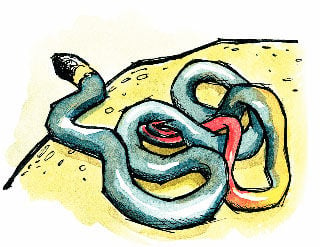 |
My name: I am a regal ringneck snake, Diadophis punctatus, but you may call me "your highness."
My kingdom: Almost anywhere in the United States and Mexico are within my realm. My preference is a moist habitat, either with water nearby or the water table close to the surface. I like woodlands, forests and grasslands and can be found up in areas up to 7,000 feet in elevation.
The royal attire: I am quite beautiful, as would befit my regal name. My very smooth scales are a rich olive to blue-gray on the top, with a brilliant red or yellow-orange belly. The red is particularly intense by my tail. I have a neck band that matches my belly.
Monarchial menu: Since I reside around the water, I like my fare to consist of salamanders, frogs, worms and slugs. I will eat the occasional lizard or small snake.
Defending the throne: When alarmed, I hide my head, coil into a tight disc and flash my bright tail. Oh, I also can release a pungent musk, just to make sure I am left alone.
The future of the empire: Although I am not venomous now, I do have a very primitive venom apparatus, enlarged rear teeth and saliva that can paralyze my prey. Check back in an eon or two to see how I have evolved.
Critter: Ringtail
 |
My name: Ringtail, aka Bassariscus astutus
My face: I am a squirrel-size animal that weighs 1 to 2 pounds. I am grayish-brown with - you guessed it - a fluffy black-and-white ringed tail. I have large, black eyes ringed with white, big ears and a pointy muzzle.
My home: I make my den in the niches in rock walls, boulder piles or hollow trees. I live alone.
My meals: Rodents, fruit, birds, snakes, lizards and insects are all favorites on my menu. I eat at night, as I am a nocturnal hunter. I have large eyes and a good sense of smell to locate my prey.
My enemies: I serve as the occasional lunch for great horned owls, bobcats and coyotes.
My family: I'm a solitary creature, but we pair up for a few days in April for mating. Two to four kits are born in June, and they leave home in the fall.
My claim to fame: I am Arizona's state mammal, though I am shy enough that you probably have never seen me in the wild.
My secrets revealed: I am an excellent climber. I use my long tail to help me balance on cliff walls and in trees. I can rotate my hind feet 180 degrees. This makes it possible for me to descend a cliff face-first. Take that, Spider-Man!
Critter: Roadrunner
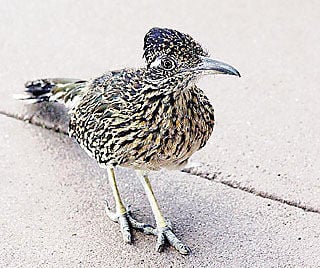 |
I am a roadrunner. I also answer to greater roadrunner or Geococcyx californianus. My favorite name is Fastius Tasty-us, what Wile E. Coyote would call me if he could catch me, which he will never do.
I am gray and brown. I am long, lean and sleek, reaching 24 inches in height. My legs and tail are long. I weigh about 13 ounces. My eyes are yellow.
Running is my main mode of transportation. I can fly, but I like my flights to be low and short.
I can be found in the Southwest and down into Mexico.
I have a strong stomach. I like insects, lizards, rodents, other birds and even snakes. Yes I can catch a snake; I'm pretty tough.
Not many critters can claim fame outside of the great outdoors, but I can. I had a television show with that silly coyote. But more important, I had a car named after me, the Plymouth Road Runner. They were really cool cars.
Critter: Robin
 |
I am a robin. You can also call me Little Robin Red Breast or Rockin' Robin. I don't tell many folks my scientific name, which is Turdus migratorius.
I'm practically everywhere. I am one of the most familiar birds of North America and can be found all over the country. I like Arizona's mountains and wooded areas, as well as the riparian spots.
I am easily recognizable. he guys have a slate-gray back with a rusty red chest and white speckles on their throat. The gals have similar coloring, only more subdued shades of gray and orange. We are about 9 to 11 inches long and have a 17-inch wingspan.
Robin's egg blue. That is the beautiful and descriptive color of our eggs. We generally have two broods a year with three to five eggs per clutch.
We are watching, not listening. When we robins cock our head from side to side as we walk around the yard, we are actually looking for worms and insects, not listening for them, as some people believe. This is because our eyes are set back on our heads - it's hard to see the ground! We also enjoy fruits and berries.
Did you know ... We employ ants to rid us of lice and other parasites. It's called anting. We stand near an anthill and let the ants crawl over us to get rid of the pesky vermin.
Critter: Rock squirrel
 |
I am a rock squirrel. Really smart scientist-types may call me Spermophilus variegatus. I am one of many kinds of ground squirrels.
Check out my wardrobe: A lot of my cousins have stripes and patterns on their backs, but I prefer an understated look. I am mostly gray with mottling, sometimes with a little black on my shoulders, head or back. I'm a little larger than other ground squirrels; I can be 18 to 20 inches long. My tail is also quite bushy compared to my cousins, almost like a tree squirrel's tail, but I'd prefer to stick to the ground.
My neighborhood: We are common in canyons and rocky deserts, so Southern Arizona is a nice place to call home.
Drop by the house: We dig burrows in the rocky ground for our homes. We'll often live in the same burrow for a few years. Our homes are so nice that, when we've moved out, other animals move in rather than dig their own burrows. Do you think I should get a real estate agent?
Lunch, anyone? I like plant stuff for lunch, mostly seeds, cactus fruit and buds. When I'm hungry and my favorites aren't available, I'll go for insects and smaller animals. I must bulk up before I hibernate.
Family life: We live in colonies. It's nice to have close neighbors. Ladies have one or two litters of babies each year with three to nine babies in each litter. Could you baby-sit next Saturday evening? Just take a head count at bedtime.
Critter: Round-tailed ground squirrel
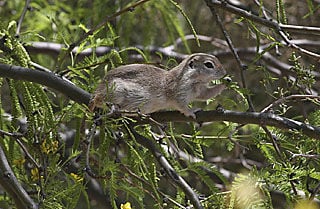 |
My name: round-tailed ground squirrel, aka Spermophilus tereticaudus.
My appearance: I'm a small species, weighing about 6 to 7 ounces. My coloring ranges from brown to gray, and I am lighter on my belly. I have short hair and a black-tipped tail. I look similar to a small prairie dog, but we are not related.
My home: I live throughout much of Arizona. I dig a multi-chambered burrow in the open areas of the desert, in colonies with other squirrels.
My food: I eat mostly green vegetation, including cacti, grasses and flowers. I will also eat insects. I get my water from eating plants.
My family: I hibernate during the winter and emerge around February for breeding. I have one litter a year. My six or seven babies are born blind and hairless.
My life: I am a social critter that spends most of the time sunning on the rocks and looking for food. I communicate with the other squirrels in my colony with a sharp whistle that tells them that predators or other dangers are near.
Critter: Ruddy daggerwing butterfly
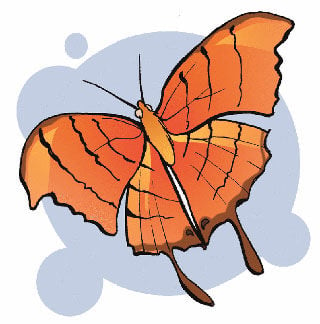 |
My descriptive name is ruddy daggerwing. Scientific types refer to me as Marpesia petreus.
I'm gorgeous: I am a butterfly 2½ to 3½ inches across. My wings are bright orange on the upper side with black lines. Each of my hind wings has a long daggerlike tail. I hope you figured that out by my name. The underside of my wings are tan to orange-brown with a dark median band. The underside of my body is white.
My neighborhood: I am found in Southeastern Arizona and in some parts of New Mexico and Colorado. My kind is quite common in Florida.
My family: We fly in late summer or fall, particularly during the monsoon, and have one brood a year in Arizona. Our larvae feed on the leaves of fig trees.
Fascinating fact: We came to Arizona in 1983 in large numbers and are thought to have bred on fig trees introduced to the area.
Critter: Rufous hummingbird
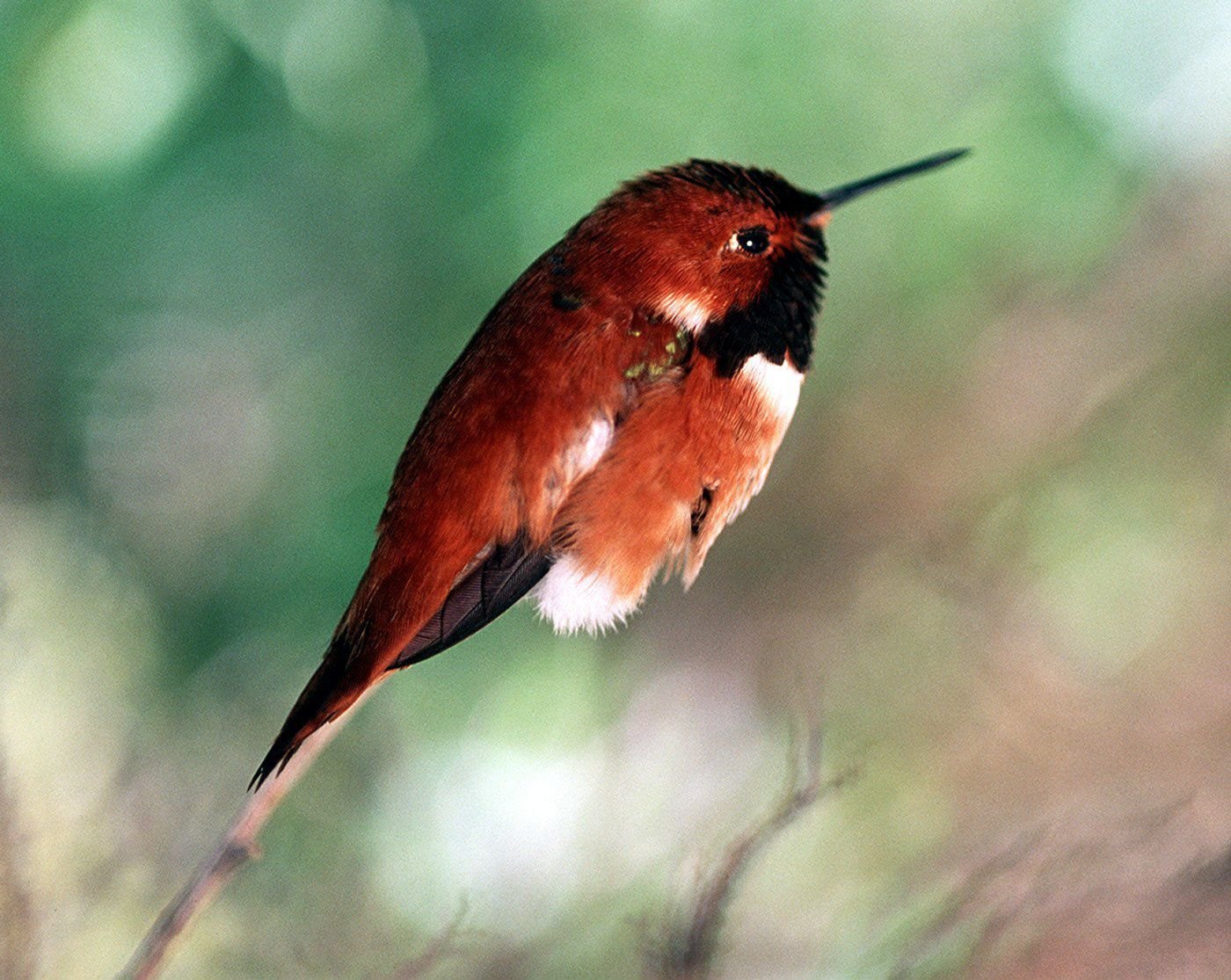 |
Call me Rufous. Selasphorus rufus.
I'm gorgeous: Not to be boastful, but I have been called "arguably America's most beautiful hummer."
I'm little: I am about 3½ inches in size and weigh about 3.5 grams.
My gorget: A gorget is a patch of bright, colorful feathers on the throat or chin. The guys have a flaming orange-red gorget with a white bib. The gals have no gorget, but there is some red to golden green on the throat.
Just passing through: I summer in the Northwest, as far north as southern Alaska. In the winter, I head for Mexico, down to Guerrero and Veracruz. So you will see me in Arizona, heading north from February through May and south from July through October.
Source: Arizona Wildlife Views
Critter: Sandhill crane
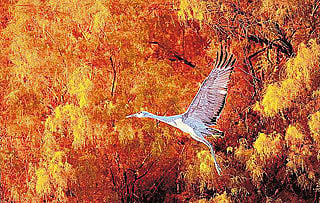 |
What's your favorite snowbird? One of my favorites flies down each winter from the cold North to bask in the warmth of the Southwestern meadows and wetlands. It's the sandhill crane.
Description: Sandhill cranes are large — up to 37 inches in length, with a wingspan of 80 inches. Everything is long - their legs and bills, as well as their necks, which they hold straight during flight.
They have gray feathers, often stained with rust or brown. They have red foreheads and whitish cheeks and chins.
Habitat: During the summer, they're seen throughout Canada and the northern part of the American Midwest.
In the winter, they migrate to Southeastern Arizona (famously at the Willcox Playa, a dry lake bed just south of the city of Willcox). They also spend the cold season in New Mexico, Texas, northern Mexico and Florida.
Diet: Mostly plants, although they do eat insects, reptiles, fish and small mammals.
Fast facts: There are three subspecies of sandhill cranes that migrate, and sandhill cranes range across Canada, the northern United States and Siberia. Two nonmigratory subspecies (Mississippi and Cuban) are endangered.
These birds love to dance, whether it's for mating, to show aggression or to relieve tension.
The sandhill crane doesn't breed until it's 2 to 7 years old. It can live as long as 20 years.
Did you know? In Nebraska, a crane fossil, thought to be roughly from 10 million years ago, was found. It's structurally identical to the modern sandhill crane, making it the oldest known bird species still in existence.
How can you see one? Each year, Cochise County's city of Willcox hosts the Wings Over Willcox Birding and Nature Festival.
For more info, go to WingsOverWillcox.com
Critter: Scaled quail
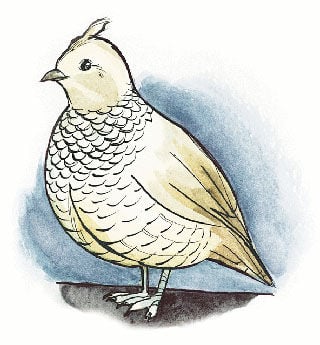 |
I'm no reptile, but I do have scales. In fact, I am called a scaled quail, or Callipepla squamata. My name comes from the bluish-gray feathers on my breast and mantle, which have black edges that create a scaled effect. The brown part of my belly also looks like scales. Overall, my body is small and stocky and colored gray-brown. I have a buff-white crest on top of my head, which is why some hunters call me a "cotton top."
I live in the brushy deserts of Arizona, and the dry grasslands of Colorado, western Kansas, and western Oklahoma south to central Mexico. Since I live in the dry desert, I get very thirsty so I have to visit water holes regularly. Because of my arid habitat, I usually only breed during the rainy season when there is a lot of moisture for vegetation.
When the time and weather are right, I lay 12 to 14 eggs in a grass-lined hollow. The eggs are a pale, buff color, with reddish-brown spots.
Though I am a bird, I rarely fly. Instead, I run from intruders. I usually hang out with my mate during breeding season, or with a small flock the rest of the year.
My friends and I are very sensitive to drought and heavy rains, so some years we are hard to find because there just aren't many of us.
Critter: Sharp-shinned hawk
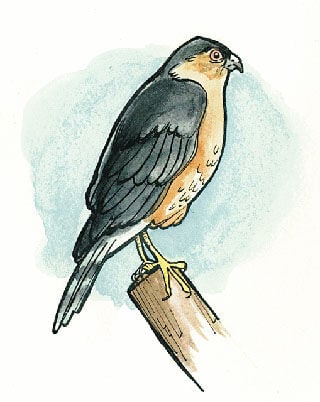 |
I am an Accipiter striatus, but I will allow you to call me a sharp-shinned hawk.
I am a rebel. I like to fly real fast. I eat birds. I take my prey suddenly and swiftly. You may even see me chasing my dinner though trees. You will know who I am when you see me fly, I make sharp turns that make me proficient during the chase.
Don't confuse me with a Cooper's hawk. They beat their wings slower than I do. They may be a little bigger than me, but their tail tips are more rounded than mine.
I am slate gray. My chest is rust with broken white stripes. My tail is long and narrow. The tip of my tail is squared off. I am between 10 and 14 inches long. I have short wings that are rounded, but my wingspan is 21 inches.
When I am young, I am brown with whitish-colored spots. My chest is creamy white with streaks. I have bars on my sides.
I breed in forests. In the winter and during migration, you can see me in almost any habitat. I am one of the most common hawks during migration.
Some people think my species is dwindling out East, because my prey is declining in numbers.
Critter: Side-blotched lizard
 |
I am a side-blotched lizard, but you can call me ubiquitous.
I am everywhere in our desert, as well as in all major North American deserts from western Washington to northern Zacatecas, Mexico. I am also abundant from central Texas to the Pacific coast.
I am active nearly any time of year - not many lizards can say that. You can even find me basking on sunny days in January. During the summer, I am usually the first lizard out in the morning, retreating by mid-morning.
I am 4 to 6 inches long from snout to tail. As you might imagine, I have a dark blotch on my sides, just behind my front feet. Generally, I am brownish with white spots. Males can have some pale-blue speckling.
I am not picky about what I eat - most little creatures, such as ants, spiders and scorpions, are fine.
I am quite tasty. I have to be wary, as bigger lizards, snakes and birds will eat me. Only about 10 percent of adults and 20 percent of the kids survive to see the next year.
Critter: Soldier butterfly
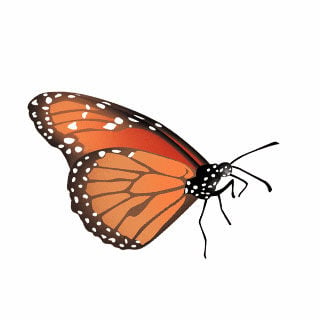 |
Name, rank and serial number: I am a Soldier butterfly, or Danaus eresimus. My rank is, well, soldier. As for my serial number, get real. I'm a butterfly. I don't have a serial number. There are also Monarch and Queen butterflies, but someone has to be the good soldier, and that's me.
Uniform: I am a bright orange, with black veins. My front wings have two rows of white spots coming from the leading edge. My hind wings on the underside have white splashes around the veins. I'm 2 1/2-3 1/2 inches across.
Patrol area: I'm assigned to grasslands, riparian areas and the edge of wooded areas in Southeastern Arizona and New Mexico.
Mess: As a larva, I feed on milkweeds.
Dependents: I'm known as a monsoon influx species; I come to the area and fly from mid-August to mid-November. That means that is when I breed.
Defense: Chemicals from the milkweeds that I eat protect me from most predators. Birds just don't like the taste.
Critter: Sonoran Desert bumblebee
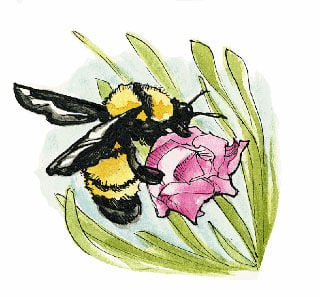 |
My friends call me a Sonoran Desert bumblebee, but my real name is Bombus sonorus. I'm a native Tucsonan.
I'm easily recognizable because I'm such a striking beauty - my body is black and yellow. When people think of what bees look like, they think of me, even though there are many different types of bees that don't have my characteristic coloring.
Bumblebees, such as myself, have a bad reputation for stinging people, but very few people are actually stung by us. We're rather timid, and usually don't sting unless one of our nests is stepped on. Wouldn't you be mad if someone destroyed your home?
You should wash the sting site with soap and water if you do get stung by me. Ice, antihistamines and aspirin may alleviate the pain and swelling.
Some people are highly allergic to my venom, and may enter anaphylactic shock from one of my stings. These people should go to a hospital right away.
There are certain people who aren't so allergic to my venom, and can become sensitized to it if they are stung repeatedly over time.
I live for about a year in a colony that may contain 100 to 400 workers. A grueling life, indeed.
Critter: Sonoran Desert Toad
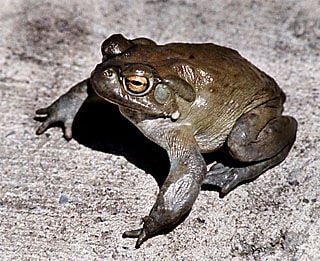 |
Call me: Sonoran Desert Toad, formerly the Colorado River Toad.
My physique: I am the king of toads out here. The largest toad in Arizona or California, I can weigh in at more than 2 pounds and be up to 7 1/2 inches long.
My best features: I happen to think the distinctive white warts at the corners of my mouth are quite attractive. They blend nicely with the rest of the warts on my brown to olive skin.
Cautionary note: Not exactly known for my speed, my best defense is chemical warfare. A poisonous toxin is produced by glands all over my skin, but especially in two raised oval glands behind the eyes. It is extremely toxic to pets and young children. So do be careful around me.
I'm not all bad: One of my beneficial attributes is the number of crickets and roaches I consume. I will even eat mice and small snakes.
Favorite time of year: The rainy season is my time to croak. I am not seen for most of the year, but as soon as those summer monsoons arrive I will start showing up near ponds and rainpools looking for love. Listen for me in the evenings, just don't touch!
Critter: Southern fire ant
 |
Hot, hot, hot: Officially I am known as a Solenopsis xyloni, but you may know me as a Southern fire ant. I may be little, but my bite is ferocious; I'm called a fire ant because when I sting the bite feels like it's on fire. My bites cause a burning and itching feeling.
Tiny terror: I am only 1/8 to 1/4 of an inch long. Though you may not see me, you sure will feel my bite if you make me angry. My skin is shiny and two-toned: black and red, like fire.
Family support: Worker ants build mounds of dirt in back yards or gardens. My relatives and I live in colonies, working together to find food and make shelter. When our nest is disturbed, we swarm out of the dirt mounds in large groups, stinging anything in our path.
No mercy: We are small, but fellow insects cannot escape the wrath of our hunger. My relatives are predatory and often capture and eat other insects.
Critter: Southwestern myotis bat
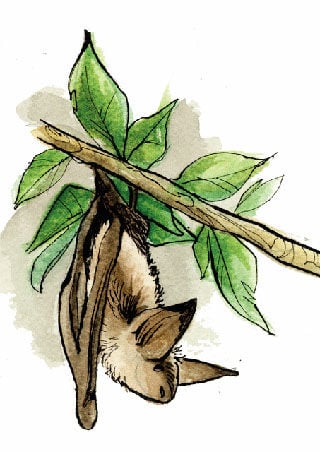 |
Who would I be? I am a Southwestern myotis. That is I am a bat. I am very similar to the long-eared myotis, except my ears are shorter.
How big would I be? I have an average wingspan of 10½ inches. My body is about 2 inches long.
Where would I live? I can be found in the ponderosa-pine mountain islands of Central and Southern Arizona and New Mexico. I like woods with mixed pine and oak, also chaparral and riparian forests. I am a summer resident in these states, but I am very secretive as to where I spend my winters.
What's on the menu? I am especially fond of soft-bodied moths, just like my long-eared cousin. But if we are both in the same area, those other guys will switch to beetles, and the moths are left to me. We forage for insects by hovering or flying slowly over vegetation, rocks or the ground.
What else do you know about me? Not much, although it is believed that I am widespread, if not common in the areas that I like. Since my survival is so dependent on secure roost sites, it is important that you learn as much as you can about my habits. If you can help preserve my favorite haunts, you can help assure my survival.
Critter: Spiny softshell turtle
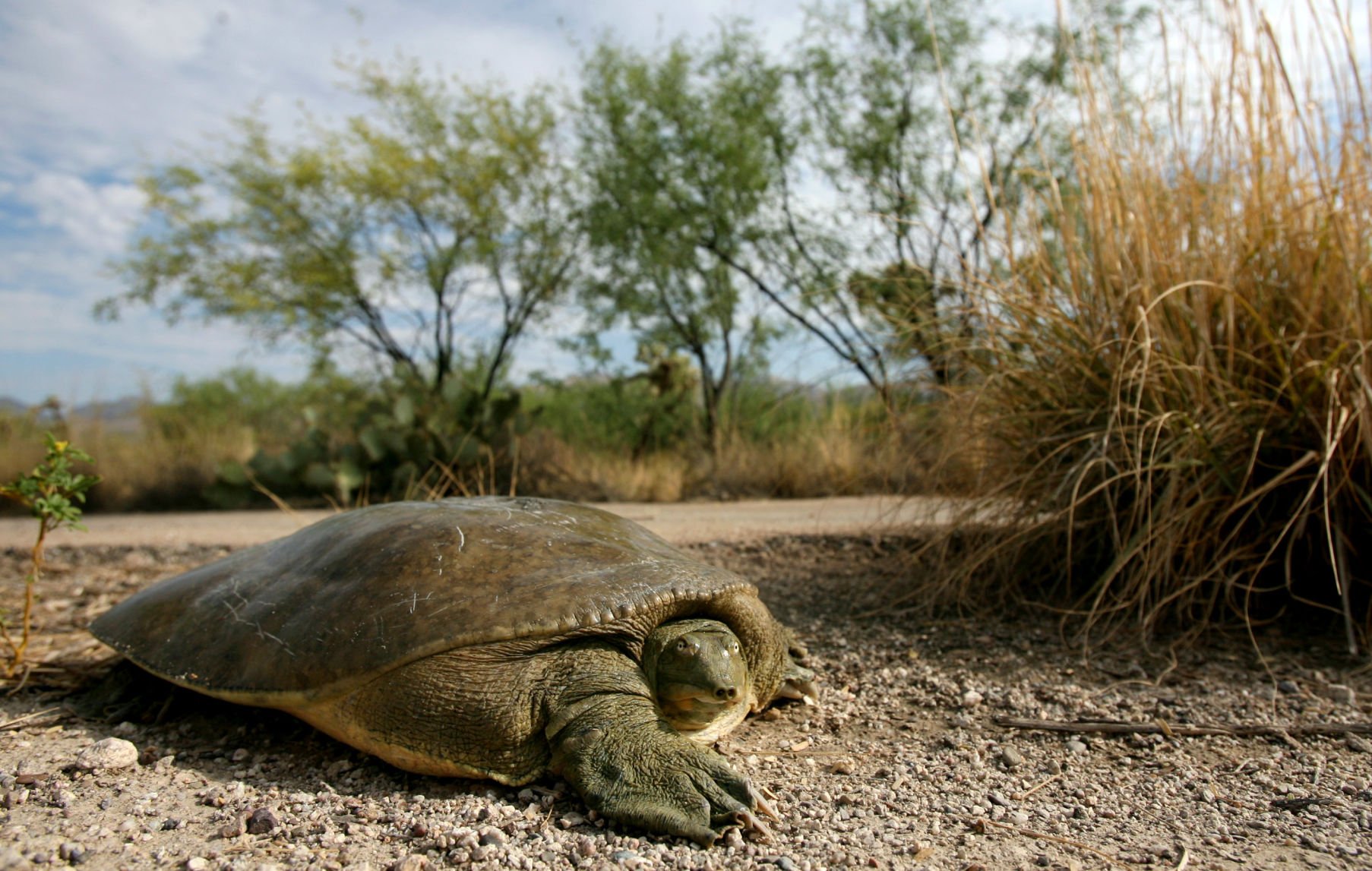 |
Name: Spiny softshell turtle, aka Trionyx spiniferus
Appearance: Greenish-tan in color with a grayish-white underside. This aquatic turtle has a long body, up to 12 inches long. The shell is flat, almost pancake like, leathery and flexible. Looks like a Frisbee with feet.
Location: Cormmon to quiet water with mud bottoms. Prefers permanent ponds, canals and irrigation ditches. Well established in all Arizona lakes and rivers, such as the San Pedro, Gila and Colorado rivers.
Mealtime: Eats earthworms, snails, crayfish, insects, fish, frogs, tadpoles and an occasional aquatic plant.
The young: Eggs are laid in the spring on sandy beaches and hatch in about 90 days.
Interesting fact: The turtle's pointed snout can inflict a painful bite.
Source: The Arizona-Sonora Desert Museum
Critter: Spotted bat
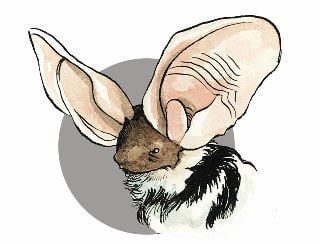 |
I am a spotted bat, aka Euderma maculatum.
I'm No. 1! I have translucent pink ears that are almost as long as my body. They are the largest ears of any bat found in the United States.
I even have spots! I have long, silky, snow-white fur underneath and jet-black above. On my shoulders and rump are white spots, and that is where my name comes from.
Hard to find me. I occupy a range from central western North America to southern British Columbia and northern Mexico.
Consider me rare. Until 1965 there were only 35 specimens of my species. But it is believed I am not as rare as that would make one think.
Look up. I live high on cliff crevices where I am rarely observed and not harmed by humans.
Dinnertime. I feed almost exclusively on moths.
Listen for me. I am one of the few bats whose echolocation frequencies are low enough to be heard by humans.
Critter: Spotted skunk
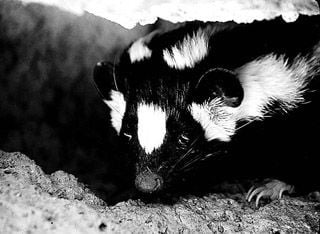 |
Introducing: Spotted skunk, aka Spilogale gracilis
Mustelidae family: My family includes badgers, skunks, otters, ferrets and weasels.
Good things come in small packages: I'm small, about 2 pounds, with bold black-and-white spots. My tail is bushy black with a white tip.
Skunk habits: We're nocturnal creatures. We don't hibernate, but we can spend several days underground during winter storms.
A place like Sabino Canyon: We prefer rocky riparian canyons. We build our own dens in brush piles, hollow logs or mine shafts. We often share our dens with other animals, such as our friend the pack rat. Our dens have a distinctive, strong, musky order and may be littered with berries, insect parts and bits of fur.
It's going to be a bad day the day you upset a skunk: We can spray a noxious fluid up to 12 feet.
Predators: We can stop most predators in their tracks, except for humans and automobiles. Our only other major predator is the great horned owl, which has almost no sense of smell.
Critter: Striped plateau lizard
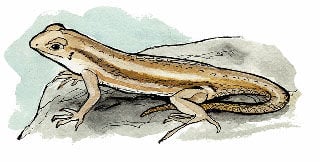 |
Who am I? Striped plateau lizard, aka Sceloporus virgatus
Brown is beautiful: I'm brown, with distinct brown stripes and brown spots. If you turn me over, you'll find my belly is white, and I have a small blue patch on my throat.
Where I make my home: Found primarily in Mexico, but a few of us have made our homes in Southeastern Arizona and in the southwest part of New Mexico.
Where I roam: Cool pine forest and oak woodlands.
Sightings: Look for me near rocky or sandy surfaces along streams where there is plenty of shade and water.
Dining preferences: I eat a variety of insects, including centipedes.
Five to 15 is enough: I lay my eggs in June and July.
Critter: Summer tanager
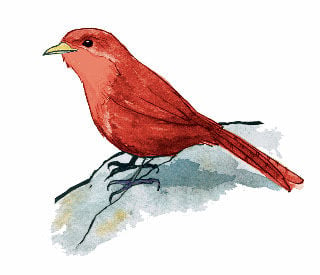 |
Who am I? I am a summer tanager, more formally known as Piranga rubra.
The face in the mirror: Males are a bright red with slightly darker red wings. Females are a mustard yellow all over with wings that are a darker yellow. We have pointed bills and are about 7 to 8 inches long.
My voice: My call is a descending series of notes sounding like pikitukituk.
My neighborhood: We're found in woodlands most of the time. During our migration in the spring, you can find us in Pima County, and we're in most of Arizona during the summer.
Home and hearth: Ladies take care of housing by building a cuplike nest.
My family: Once or twice each year, moms lay three to five pale blue eggs with dark markings. Moms incubate them for 10 to 12 days until they hatch. Mom and Dad both feed the babies.
Favorite foods: We eat mostly insects and prefer bees and wasps. The next time you're not stung, I'd appreciate a "thank you." We also occasionally eat fruit.
Critter: Tarantula
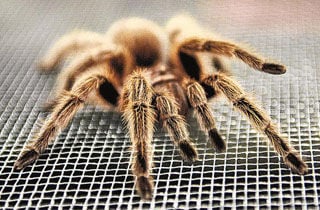 |
Call me a tarantula. Or you can call me the largest spider in Arizona, just please don't call me scary. There are as many as 30 species of tarantulas in the state, and we are found throughout the world.
Look at me. Generally we have a body length of about 2 to 4 inches. The females are stockier than the males and usually are blond to brown in color. The males are black. These gals wouldn't think of shaving their legs, and indeed our legs are quite hairy! The guys have reddish hair on their abdomens.
Below ground. We are all nocturnal and spend our days quite content in our holes. In fact, we may live in the same burrow for years, expanding it as we grow. We are very neat and make sure the area around the hole entrance does not have piles of soil to give away its location. We line the outside of the entrance with silk to alert us of prey that might be approaching. We even cover the opening when we are home and resting.
Home is not where the heart is. When the males reach maturity at about 8 to 10 years, they start wandering about looking for love. This is usually from June to October. After mating, it is very important that the male depart the scene quickly! The males generally do not live more than a year after maturity. The females may live for many more years after they start breeding. There are lots of predators in a tarantula's world, and the survival rate for the spiderlings is quite low. It is estimated that a female will produce only two youngsters that make it to maturity.
Gentle giants. We may look imposing and frightening, but we are really very docile and don't see very well. We won't cause you any problems unless we are provoked. Our venom would not really hurt you, but our bite sure would. Our hair can be rather irritating if you come in contact with it. So if you just observe me and let me go about my business, we can all get along here in the desert where we both live.
Critter: Taxiles skipper
 |
Call me: Taxiles skipper, aka Poanes taxiles.
What a looker: I am a butterfly. Like many other species, we have males and females that look different. The males are orange with brown-edged wings on their dorsal side, while the females are many shades of brown.
Where I hang: I can be found in the mountains, usually above 5,600 feet. In Southeastern Arizona, I have been seen in the Santa Ritas, the Santa Catalinas, the Huachucas, the Whetstones, the Chiricahuas, the Galiuros and the Pinalenos ranges.
When I get the munchies as a larva: Bromegrass, nodding brome ( Bromus anomalus) and Arizona wheatgrass ( Elymus arizonicus).
More cool stuff about me: I am the most common skipper that can be found in the summer. You can find me at water spots and at a variety of flowers.
Critter: Tailless whipscorpion
 |
My name is: Tailless whipscorpion. But I'm not really a scorpion at all. I'm an arachnid.
I'm not just another pretty face: Most whipscorpions get their name from their whiplike tails. As you can guess from my name, I don't have a tail. However, my first pair of walking legs are long and whiplike. I have spiny, clawlike pedipalps that are useful for grasping my prey, insects. I am pale brown to black in color and look a bit like a flat spider with long legs. My body is less than an inch long.
I hail from Mexico and north to central Arizona.
My home: I hide under rocks or in tree-bark crevices by day. I also like dark places like basements and under sinks.
What's on the menu? Bugs are yummy. I hunt them at night, locating them with my sensory legs.
Looking for love: When courting, we touch each other with our sensory legs. Then the guy deposits a spermatophore on the ground and guides the young lady over it. She will lay up to 60 eggs and carry them in a sack under her abdomen for a few days. When they hatch, they'll ride on Mom's back until their first molt, within a week.
What's not to love? I'm not venomous, and I don't bite or sting, so stop screaming when you see me.
Critter: Tiger rattlesnake
 |
Name: Tiger rattlesnake, aka Crotalus tigris.
My good looks: My colors vary widely from blue-gray to reddish-pink. I have darker flecks or spots that form bands, or "tiger" stripes, on my back.
What do they know? I've heard people say I have a small head and a large rattle in comparison to my medium-size body. It seems to suit me just fine.
Diet: A steady supply of rodents and other small mammals.
The shy type: I'm active from spring to late fall. I'm primarily nocturnal and prefer not to be seen. I'm most active during the summer monsoons.
Little ones: I mate in April, and the young are born in late June through September.
Critter: Tiger Salamander
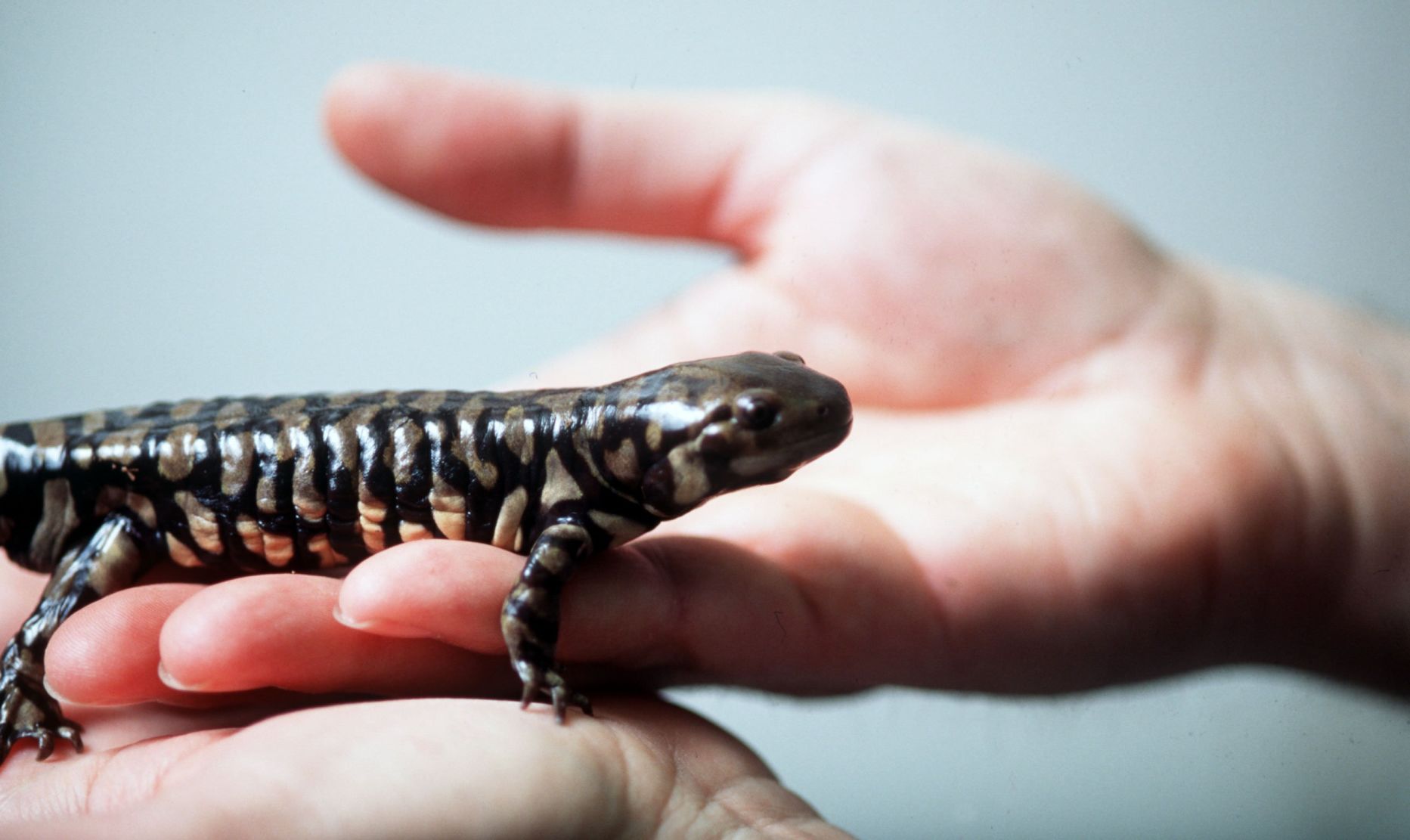 |
Who I am: Tiger salamander, aka Ambystoma tigrinum.
What I look like: I am large and stocky with small eyes and a broad, rounded snout. The Arizona tiger salamander has fewer than 25 yellow spots on a dark background and a belly marked with yellow. The Sonora tiger salamander has more than 25 spots and a brownish belly.
Where I am found: My Arizona brother is found in Arizona from the Grand Canyon south to central Arizona and into New Mexico. My Sonoran brother is found in Santa Cruz County in the Huachuca Mountains.
Where I live: I spend much of my time in the burrows of squirrels, gophers and badgers. I stay near quiet water such as ponds and lakes, or even temporary rain pools.
What I eat: If it moves and I can swallow it, it's lunch.
How I live: You won't see me much because I stay in my cooler, moister burrow except when I come out to breed. Then I crawl to water, often at night. I lay my eggs singly or in small clusters. They are attached to twigs and weeds in a still body of water.
Source: "A Field Guide to Western Reptiles Reptiles and Amphibians" by Robert C. Stebbins.
Critter: Tiny checkerspot
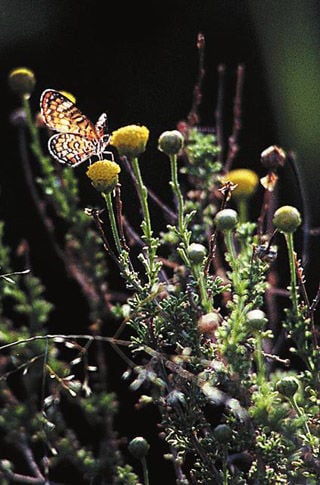 |
You can call me: Tiny checkerspot, or Dymas checkerspot. If you want to get technical, you can call me by my scientific name, Dymasia dymas.
Just a tiny little thing: As an adult butterfly, my wingspan is only an inch wide.
Check me out: I'm light-brownish-orange in color. I have a prominent white rectangle shape surrounded by white spots and narrow black bands resembling a checkered pattern.
Residential status: I enjoy the weather and accommodations the Tucson area have to offer. My many relatives and I call this home most of the year.
Frequent sightings: My favorite place to hang out is the desert near a wash or stream.
No big hurry: I move in a slow, fluttery motion.
Critter: Tobacco Hornworm
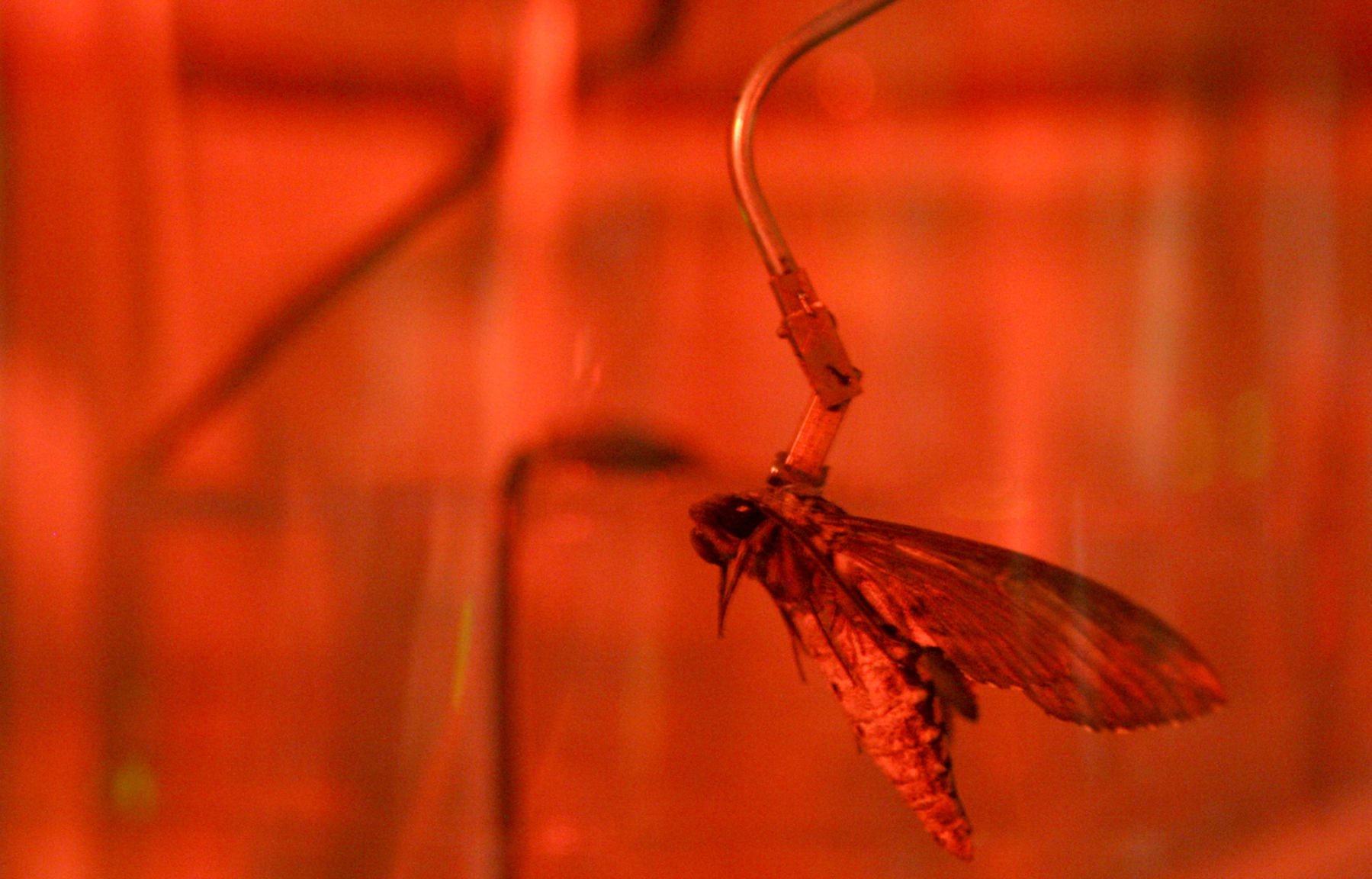 |
Name: Tobacco Hornworm, a.k.a. Manduca sexta
Birth: Females lay single eggs on the underside of leaves, which turn into large green caterpillars with long horns and large heads. They can grow to be over 3 inches long.
Transforming skills: After feeding, the caterpillar burrows into the ground, turning into an immobile dark brown cocoon of saliva and soil. A large juglike handle that will be the tongue of the new moth, sticks out near the head. Inside the caterpillar is making it's transformation into a moth.
Eating habits: As caterpillars, they eat a variety of garden foliage including tomatoes, peppers and tobacco. They are generally considered a pest that blends in easily. As moths, they pull nectar from flowers with a gland or tongue that protrudes from their abdomen.
Habitat: Manducas live in fields from Massachusetts to Minnesota, down to Florida and across the Southwest and into parts of Mexico.
Source: www.silkmoths.bizland.com and "Insects of the Southwest, " by Floyd Werner and Carl Olson.
Critter: Turkey vulture
 |
I am a turkey vulture. Although some folks also call me a turkey buzzard, my official name is Cathartes aura.
Big bird. I am a large bird with a wingspan that measures 6 feet and I am just over 2 feet long. In flight, my two-toned wings have a slight V shape and projections that look like fingers on the trailing edge. My tail is squared off. I have a very red, bald head and my legs are red, too. My sharp beak is ivory.
Roadkill! Yum! Our role is to clean up the dead animals along the road and anyplace else we can find them. It's a tough job, but someone's got to do it, and, frankly, we rather like our food already dead. Our bald head is specially adapted for digging around in carcasses. Without feathers, we don't run the risk of picking up diseases.
Other adaptations. Only occasionally will we kill an injured or dying animal. Consequently, our feet are rather weak and more suited to walking than grasping. After all, dinner is not trying to escape! Also, we have a really good sense of smell. Cruising slowly around in the air, we are on patrol for the next meal. Ah, nothing better than the sweet aroma of dinner ripening in the distance.
Nest, schmest! Nest building is not something we spend a lot of time doing. Our annual breeding usually produces two eggs. These are deposited on a bare cave floor, rock ledge or in a hollow log. It takes them about 40 days to hatch. It's not that we don't care about the children. Both parents are involved in incubation and feeding of the youngsters. Those little guys thrive on regurgitated carrion.
Critter: Twin-spotted rattlesnake
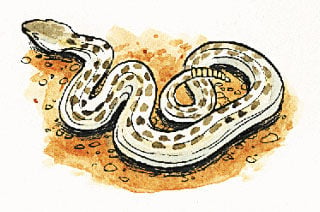 |
I am: a Twin-spotted rattlesnake, aka Crotalus pricei
My size: I am a small snake, usually 1 to 2 feet in length.
My markings: My overall color is a grayish-brown, with two distinctive rows of brown spots down my back. There are smaller spots on my sides, and my tail has distinct brown bands.
My home: I live in mostly rocky mountain and forest areas of Southeastern Arizona, through parts of Colorado and sometimes in northeast Mexico.
I can easily camouflage myself in the leaf litter, but you may be able to find me sunning on the rocks.
My activity: Is limited by colder weather and rain, although I may venture out to feed during warm rains.
My family: I give birth to live young, which are 6 to 7 inches in length.
My attitude: I am a mild-mannered snake that makes a soft rattling sound, which may be mistaken for a locust buzzing.
Critter: Two-tailed tiger swallowtail
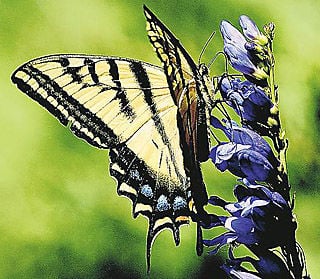 |
Unusual name, unusual look: I have a long name, Papilio multicaudata, but that's not the most unusual thing about me. I have two tails on each of my wings. That's why most people call me the two-tailed tiger swallowtail. Think that's crazy? I have a cousin called the three-tailed swallowtail who lives in South America.
Wild animal: As you might guess from my name, I have black tiger stripes adorning my wings, which are mostly a bright-yellow color. I'm pretty big for a butterfly; my wingspread can sometimes be more than 12 centimeters, or 4.8 inches.
Easy to see: Not only am I a big butterfly, I'm also showy. I am one of the most common butterflies in our region and I enjoy flying throughout the mountains and sometimes make a trip to the lower valleys and cities.
Feed me: I get hungry after all that flying, so I usually stop to drink the nectar of thistles, milkweeds, California buckeyes and lilacs, as well as many other flowers.
Critter: Vermilion flycatcher
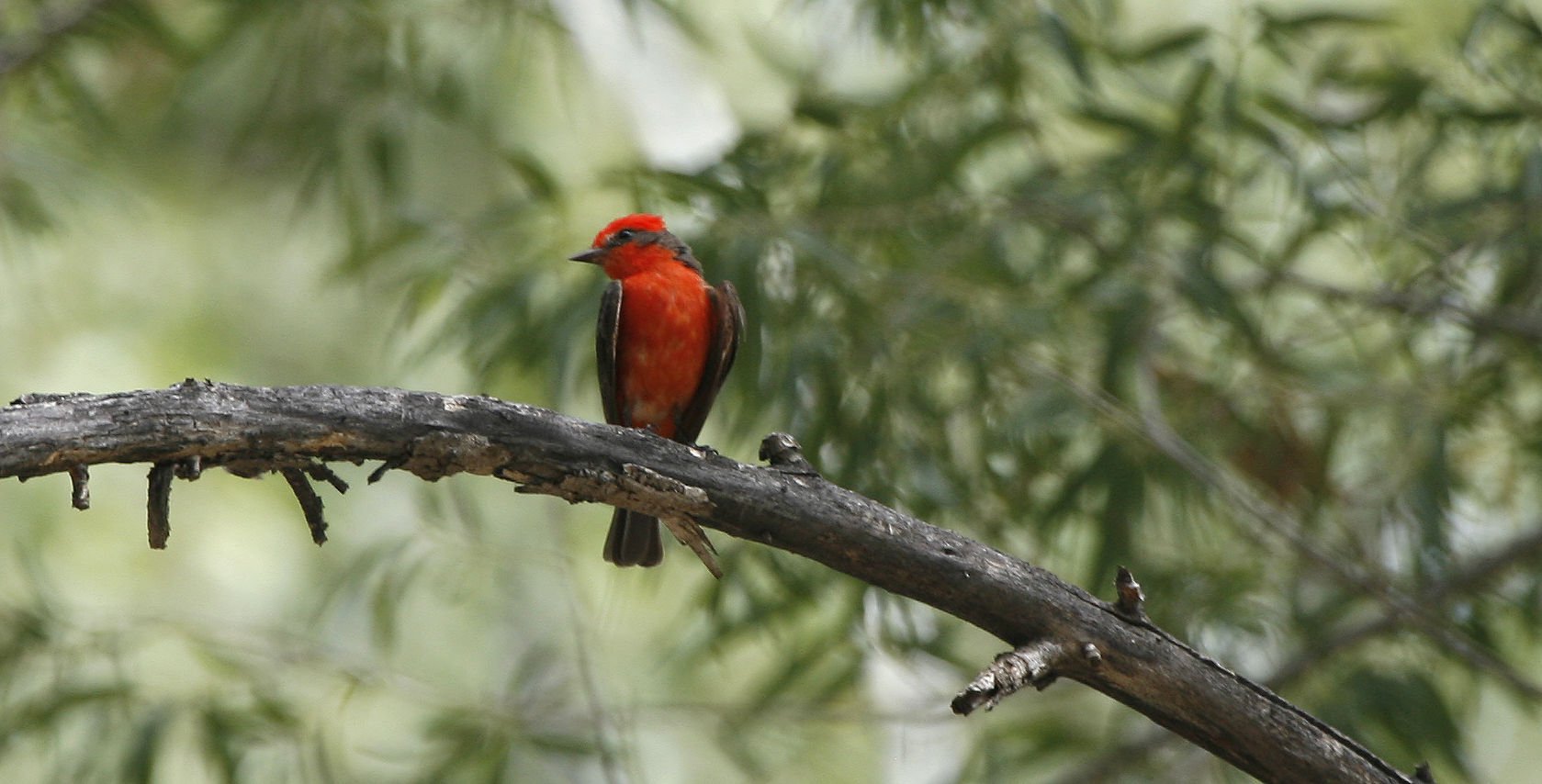 |
Name: Vermilion flycatcher
Description: This bird is about 6 inches long. Males have a red head and belly and are dark brown elsewhere. Females are similar but have white bellies with dark streaks. The females and young birds have bellies that range in color from white to pink to yellow.
Usual haunts: The breeding area is from southeastern California east to western Texas and south into the tropics. In the winter, this critter sticks close to the southern part of its breeding range and can go as far east as the Gulf Coast.
Housing: They prefer trees and shrubs that are next to rivers and roads. Their nests are made of a variety of items, including fibers and feathers, and are lined with spider webs and lichen.
Offspring: Eggs are creamy-white with dark brown spots. The bird tends to have three eggs.
Interesting fact: Although this bird is very colorful, it can be hard to detect in Cottonwood, willow and mesquite trees. It tends to stay in the highest canopy when seeking food.
Source: National Audubon Society's "Field Guide to North American Birds."
Critter: Western diamondback rattlesnake
 |
You call me a western diamondback rattlesnake. If you were speaking scientifically, you would call me Crotalus atrox. But whatever you call me, do it with respect, because I am the largest and possibly most dangerous of the Southwest rattlers.
Seeking me out? Generally, I am about 2 to 3 feet long, but I can grow up to 7 feet in length. My color palette includes gray, brown, pink and yellowish tones with a light brown to blackish diamond-shaped pattern on my back. All my markings are indefinite and speckled with dark spots and I have an overall dusty appearance. You can imagine how handy that is when I am slithering around the desert.
The tale is in the tail. I have a tail that has black and white rings around it, kind of like a raccoon. At the tip of that tail is my characteristic rattle. The rattle is really just a series of horny, interlocking segments. The sound is produced when they knock together at a very high speed. A new segment is added each time I shed my skin.
Stay outta my way! You really don't want to get bit and have to deal with my venom. I don't have a particularly social attitude. I hold my ground and boldly defend my space. So, be cautious when you are traipsing about in my habitat, which around here can be just about anywhere.
Critter: Western patch-nosed snake
 |
I'm known as: Western patch-nosed snake, aka Salvadora hexalepis
My most outstanding feature: My nose resembles a triangular shield, and I use it for digging. I'm long and slender, and I'm dark green-gray with pale yellowish strips down my back and belly.
Always the opportunist: I'll climb trees to hunt a lizard or small mammal, and I'll use my nose to dig up lizard and snake eggs. I'll eat anything I can overpower.
Survival skills: My ability to move fast and my quick wit save me from becoming prey. My tolerance for a wide range of temperatures makes me comfortable in the desert.
Home: You can find me in Northwestern, Central and Southern Arizona.
Mother's love: Females lay five to six eggs, depositing a pheromone that prevents other patch-nosed snakes from eating the eggs.
Critter: Western pipistrelle
 |
I may be small, but don't call me Pippi. My hair's not long enough for braids. I am the Western pipistrelle, or Pipistrellus hesperus. At about 3 inches in length, I am the smallest bat in North America.
Don't mistake me for a butterfly either, even though I kind of fly like one. I weigh only a little more than a penny.
Like Batman the comic-book guy, I wear a black mask over my ears and face. My wings are black, too. But my fur is yellowish-gray.
Late to bed, early to rise. I get up early in the evening and stay up until late in the morning. You might see me up to two hours before sunset.
It's called echolocation. Since most bats don't see so well, we emit sonar sound pulses that echo off nearby objects; that's how I know how close dinner is.
Two's a crowd. I like to live alone, but sometimes we live in small maternal groups. Unlike many bats, who have only one offspring per year, we usually have two, so we like to have a little help keeping track of all the rugbats.
Critter: Western meadowlark
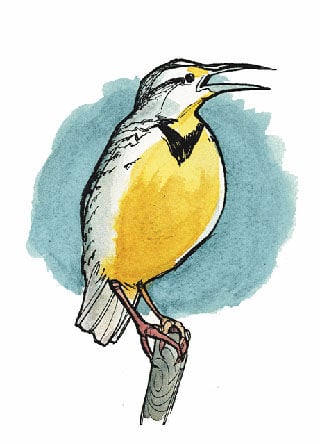 |
I am a Western meadowlark.
I never tell the kids this until they are older, but my other name is Sturnella neglecta.
I can be found in Southern Arizona in the winter. My relations, the Eastern meadowlark, can actually be found in the same area all year round. That is enough about them.
I am white, tan and black. I have a V-shaped black-mark around my neck. I also have vibrant yellow on my chest and between by beak and my eyes. It really is a pretty yellow. I am about 9 1/2 inches long. I have a wing span of about 14 1/2 inches. I keep my slender figure by eating seeds, insects and worms.
I can be found in meadows and grasslands. My mating season begins in the early spring. In the winter I can be found in loosely assembled flocks and can even be seen with those Eastern relations. They just keep getting in my spotlight all the time.
Regardless of the neglecta in my name, I am a fairly important bird. I am the state bird of Kansas and North Dakota. Imagine that! Two states have picked me. See, I really am special.
Critter: White-crowned sparrow
 |
Name: White-crowned sparrow, aka Zonotrichia leucophrys
Look at me: Stands 6 to 7 inches tall, displaying a black-and-white-striped crown. Its slender body is gray, with a brown and gray back. Given its slightly more upright posture and similar appearance to the white-throated sparrow, a close inspection is needed to tell these two apart.
Sounds like: "Tsee tsee tsee zzeech-i chi-i-i" is the song it sings throughout the night.
Range: The abundant birds, gathering by the thousands, can be found throughout North America.
Breeding: Arizona's White Mountains and San Francisco Peaks are common stops for sparrows to breed.
Nesting: Nests are hidden in dense brush or near open grasslands. After making a cozy cup of bark and grass, females lay three to five speckled pale-green eggs.
Source: "The Audubon Society Field Guide to North American Birds. "
Critter: White-tailed deer
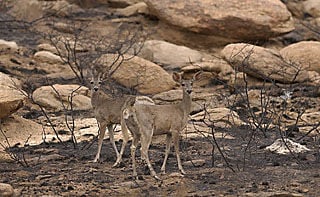 |
Name: White-tailed deer, aka Sonoran deer
Most obvious feature: Its distinctive tail is brown or gray on top and white underneath. When the deer is running, the tail is raised like a plume, which highlights it against the reddish-brown body color.
How big: 2 to 3 feet tall, the males weigh about 125 pounds and the females about 80, although weights can vary from 50 to 200 pounds.
Eats: These deer prefer to feed at night. They munch on weeds, shrubs, grass, mistletoe and cacti fruit.
Eaten by: Coyotes and mountain lions are natural predators, as well as feral dogs. Young are often taken by bobcats and foxes.
At home: Lives in cactus and mesquite deserts and oak-grasslands and pine forests in the central and southeastern mountains of Arizona.
Did you know: White-tailed deer are creatures of habit, following identical paths or feeding in favorite pastures year after year, unless driven away by food shortages or heavy predation.
Critter: White-throated swift
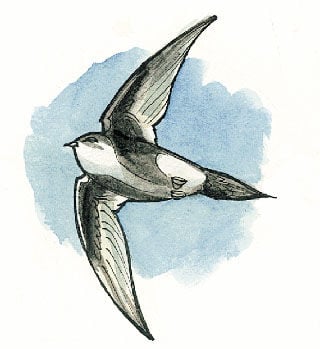 |
Look! Up in the sky! It's a bird; it's a plane; it's Superman! No, I'm a bird, a white-throated swift, aka Aeronautes saxatalis.
How can you be sure? Well, there's no engine or windows and no blue cape. I am 6 to 7 inches and, seen from below, have black wings, flanks and tail, while the rest is white. My wings are long, and my tail is short.
Where is that bird? In the winter, I am found in Central California and Southern Arizona and New Mexico south to Central America. In the warmer months, we breed through the Rocky Mountains to British Columbia. We like arid mountains and rocky areas.
About that name "swift":Like airplanes and Superman, I am a speedy guy, among the fastest of birds. And like Spider-Man, I cling to vertical surfaces like the sides of buildings or trees. No perching for me.
On the fly: I am an aerial feeder. That means I catch and eat insects as I fly. We also mate in flight, during which we spiral downward in free fall, separating in the nick of time.
After that mating: We nest in colonies. Our nests are built of feathers that are glued together with our saliva. We lay 3 to 6 white eggs per clutch.
Critter: White-winged dove
 |
Name: White-winged dove, aka Zenaida asiatica
The face in the mirror: Light brown bird, 11-12 inches in size, this dove is the only North American dove with a large, white patch on the wing.
Neighborhood: He likes mesquite trees, groves, saguaros, desert oases and towns.
Real estate preference: A flimsy twig platform in a tree or thicket. Moms generally lay two buff-colored eggs.
Witty repartee: A harsh cooing that sounds vaguely like the crowing of a young rooster.
No chocolate: This dove eats seeds and fruit.
Fascinating facts: The white-winged dove is a pollinator of the saguaro.
Source: "A Field Guide to Western Birds," by Roger Tory Peterson and The Arizona-Sonora Desert Museum.
Critter: Wilbur T. Wildcat
 |
Rebel yell: Give me an A-R-I-Z-O-N-A!
On the job: Formally I'm known as the University of Arizona's mascot, but most people know me as Wilbur T. Wildcat. My best gal, Wilma, and I can be found on the sidelines of many UA sporting events cheering for the Cats.
A perfect pair: Wilma and I tied the knot on Nov. 21, 1986 during an Arizona State game.
Not the first: The UA's original mascot was a live bobcat called Rufus Arizona, named after then-President Rufus B. von KleinSmid. The bobcat was bought by the freshman football team as a gift to the school in 1915. Rufus (the mascot) met an untimely death the following year when he was practicing gymnastic stunts on the limbs of a tree to which he was tied. Several other live mascots were used in the following years, but I made my debut as the first costumed mascot in 1959 and have been around ever since.
Nemesis: Most Tucsonans know that I love to hate my rival, Arizona State mascot Sparky the Sun Devil.
Origin of the Wildcats: Bill Henry, a writer for the Los Angeles Times, reported that the Arizona men "showed the fight of wildcats" when they played a football game against Occidental College in 1914. The student body later voted to change the university's athletic team name from the "Varsity" to the "Wildcats."
Critter: Wolf spider
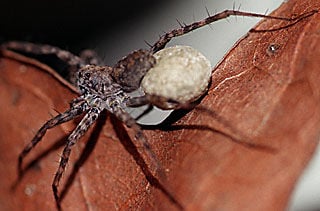 |
Wolf or spider? Actually I'm called a wolf spider, but I have eight legs, so technically I look more like a spider than a wolf. My official name is Hogna carolinensis.
Not so small: I'm not one of those wimpy little spiders you'll find hiding in your house. My body is about 1 inch long, and like tarantulas, I live in burrows. My color is usually gray or dark brown, and I have a distinctive peach-colored stripe going down the top of my body.
Catch me if you can: I can be found all over the United States, but I especially like to burrow in desert or wooded areas. My burrows are very conspicuous, and you might be able to see me at night, when my green eyes shine.
Nighttime is the right time: Wolf spiders are most active from March through October, but you will rarely see me during the day because I am nocturnal.
Hunting for love: During the summer monsoon, adult males can be found searching vigorously for a mate.
Don't be afraid: While I may look a little scary, don't worry, because I pose no danger to humans. In fact, I actually eat some of the insects or other small pests you might find in your home.
Critter: Woodhouse's toad
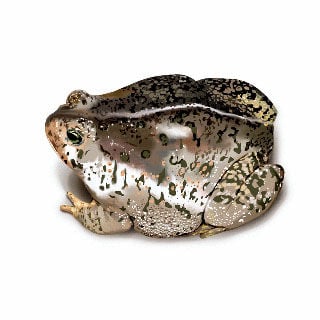 |
I am a Woodhouse's toad, or Bufo woodhousii.
I range in size from 1 1/2 to 5 inches in length, and I have a whitish stripe on my back. I have prominent cranial crests, which are ridges near my eyes. I have long parotid glands, which protrude at the back of my head.
My skin is a variety of colors - gray, olive and yellowish-brown. My back is greenish or blackish, with dark spots. My tummy is a beige or cream color, and it may have dark spots. My legs are yellow and black.
The monsoon is my favorite time of the year. You can find me during or after it rains.
I like a variety of areas, including grasslands, woods, desert streams, valleys, flood plains, farms, sandy areas and your back yard.
My breeding season starts in February and can last until early September. I am most happy and do my breeding near water of any kind.
Don't laugh. My voice has been compared to a snore, or worse, the cry of a baby or a calf. If you are trying to hear me, keep in mind I keep it short, from one to three seconds.
Critter: Woolly aphid
 |
Who can bring fear to the hearts and minds of gardeners everywhere? That would be me, woolly aphid.
Family: Eriosomatidae
I'm a small, soft insect: I have a plump, pear-shaped body and two tubes that project like exhaust pipes from my abdomen.
Home is where the sap is: We live in colonies found on young leaves, twigs and branches. We feed and reproduce in spring and early summer, then produce winged young that migrate to start new colonies.
I know things look bad: Sometimes our appetites cause leaves to curl and deform. We feed by inserting needlelike mouth parts into plants to withdraw sap. We turn the sap into a sweet, sticky product called honeydew. Ants, bees and wasps gather honeydew for food. A unsightly black fungus called sooty mold can grow on honeydew.
Critter: Velvet mite
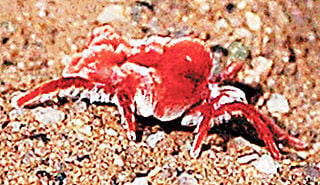 |
I am an arachnid, a class that includes spiders, scorpions and ticks. I am the velvet mite, or Dinothrombium sp.
Tiny hairs cover my body, giving me the look of the soft material I am named after. I mostly have a bright red hue but can be orange or have cream markings. People think that my coloring may be a warning for predators not to eat me.
I am about an eighth of an inch long, with an egg-shaped body and eight legs.
I come out of the soil to feed just after it rains. I eat mostly termites and possibly other bugs and their eggs that are smaller than I am.
You can find me all over North America. I like to hang out with other velvet mites. If you find one of us, there are usually lots more near. People have witnessed so many of us in one place that the area took on a pink tinge from overhead.
Males lay their sperm on the ground, and females sit on them to make them fertilized. Our young larvae become parasites and feed off the blood of other small insects. As we grow older, we live in the top layer of dirt on the ground.
Critter: Vine snake
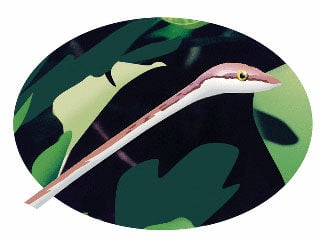 |
It's not the most original name, but it's one that best describes me: vine snake, aka Oxybelis aeneus.
Where I live: I make my home in only a few mountain ranges in Southern Arizona along the Mexican border.
Where to look: I can be found in brushy hillsides, canyons and near streams. I'm an expert tree climber, which is where I spend most of my time.
What to look for: A very thin snake that looks something like a vine. Look closely. I'm extremely difficult to spot; you might mistake me for a twig.
Lizards beware: My diet consists of lizards.
Fear factor: I have fangs in the back of my mouth, but my venom is only potent enough to subdue a lizard, not people.
Critter: Yellow grosbeak
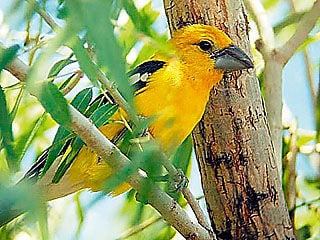 |
Hello, my name is: Yellow grosbeak, or more formally Pheucticus chrysopeplus.
Where should we meet? I'm not usually in Arizona. I caused quite a stir among bird lovers in May 2004 when I made a visit from Mexico or Central America to the Arizona-Sonora Desert Museum. Birders came from all around just for a chance to see me. It's so nice to be appreciated. If you want to see me, you'll have a better chance in southern Sonora.
What I'll be wearing: I'm larger than most grosbeaks - about 9 inches in length. I have a yellow head and underparts and black wings and tail with a white pattern on them. My bill is dark gray.
What's on the menu? I eat seeds, insects and small fruit. My short, stout bill is especially adapted for seed cracking. If you would like to order something different, that's fine with me.
On my way to Carnegie Hall: My song is similar to a robin's, with slow, steady phrases.
Critter: Yellow-headed blackbird
 |
I'm a yellow-headed blackbird. I'm also known as Xanthocephalus xanthocephalus - a word so cool you have to say it twice.
My wardrobe: After seeing my name, I'll bet you can make a good guess about my appearance. I'm 9 to 11 inches from head to tail. Besides all the black feathers and bright-yellow head and chest, I have white patches on my wings and black around my eyes like a mask. The ladies are brown with a dull-yellow head and chest. That's so they're not seen by predators while they're incubating eggs.
Where am I? I can be spotted in Southern Arizona in the winter. I nest in deep-water marshes, so you won't really find me hanging out in the dry desert.
Listen: My call is low and raspy. You'll often hear me before you see me.
Preferred menu: I dine on insects and seeds.
Family time: Mom builds a cup-style nest. If Dad does a nice mating display, Mom will lay three to five greenish-white eggs with brown markings. She has two broods each year. Mom incubates the eggs, and they hatch in 1 1/2 to two weeks. Mom also feeds the babies. In fact, Mom does just about all the work when it comes to raising the young.
Critter: Yellow-rumped warbler
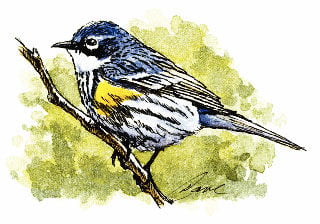 |
My name is yellow-rumped warbler, or Dendroica coronata.
Go ahead - admire my derriere. When I part my wings, you'll see a nice yellow patch on my rump. My name isn't just wishful thinking, you know. I also have yellow patches on the top of my head and on my flanks. My chin and belly are white, I have a black mask and breast, and I am about 5 or 6 inches from head to tail.
My significant other is a little duller in color, but she still has the yellow patches in all the right places. In the winter, we guys molt and look a little duller also, but I never give up my yellow patches.
We like it here in Arizona, especially the southeastern part of the state. We'll stay here year-round. The southwestern and western areas of Arizona are home in the winter, and north and northeast are great in the summer. We're also comfortable in Mexico and Central America.
The dinner menu: We are partial to insects and berries. When the kids are hungry, Mom and Dad both pitch in to feed them.
Speaking of kids, Mom builds a cuplike nest twice a year and lays four or five eggs. Mom stays with them, and they hatch in 12 to 13 days. They are fledglings for only 10 to 12 days. Kids grow up so quickly.
Critter: Yellow warbler
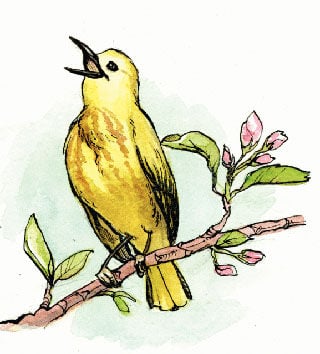 |
The name on the mailbox: Yellow warbler, or, more formally, Dendroica petechia.
The face in the mirror: My face is a lovely bright yellow. In fact, most of me is yellow. I am about 5 inches long and have a light-olive tint on my back.
Sunbird, not a snowbird: I winter in the tropics, but can be found in Arizona and other states in the summer.
My neighborhood: I like gardens and thickets along streams.
Welcome to my house: I nest in a cup made of bark, plant fibers and down. It is generally placed in a sapling.
Starting a family: My eggs are pale blue, spotted thickly with brown. I lay four or five at a time.
Moving up the charts: When our guys sing, it sounds like they're singing "Sweet-sweet-sweet, sweeter than sweet."
An interesting note: Cowbirds like to lay eggs in other birds' nests, and for some reason, they really like mine (it is quite special). This is bad news for my incubating eggs. If I find one of these interloping eggs, I cover it up with a new foundation and lay a new clutch of my own.
Critter: Zebra-tailed lizard
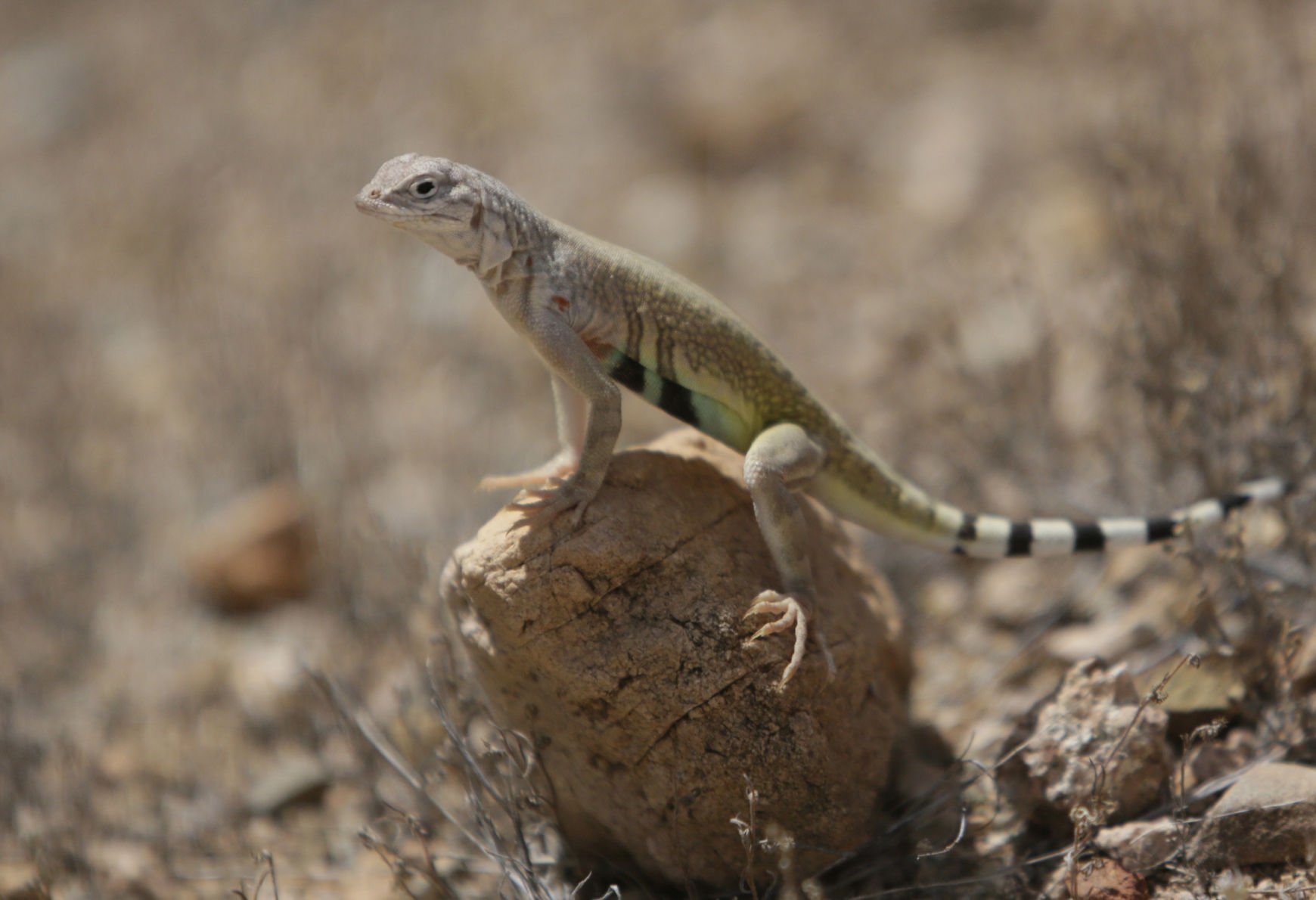 |
Name: Zebra-tailed lizard
Description: These critters have slim bodies, a long, flat tail and extremely long legs. Their backs are pale gray and spotted, and their legs and tails have dark stripes.
The name comes from their tails, which have white-with-black bands on the underside.
This critter is 6 to 8 inches long.
Eats: Zebra-tailed lizards dine on insects, spiders and sometimes plants. They also feast on other lizards.
Usual haunts: They like washes, hardpan and open areas in which they are able to run.
Fascinating facts: Running is very important for these critters, and their long legs help them run fast. They have been found to travel as fast as 15 mph. Just before they are about to run, they curl and wag their tails. They run with their tails curled forward.
The tails also offer some protection from predators. Hawks or other predators focus focus on the tail, which the zebra-tailed lizard can regenerate when a hungry predator grabs it for a snack.
Source: "A Field Guide to Western Reptiles and Amphibians" and "Reptiles and Amphibians of the American Southwest. "
Critters of Southern Arizona




|
||||
Kind | Name | Description | Photo | Photo credit |
|---|---|---|---|---|
| Kind | Name | Description | Photo | Photo credit |




|
||||

































